

Required works of art for AP®︎ Art History
by Smarthistory
Content Area 1
Global prehistory | 30,000–500 b.c.e..
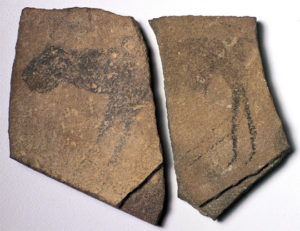
1. Apollo 11 Stones
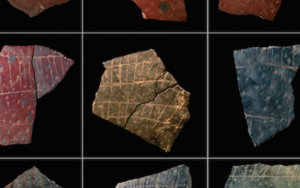
1. (related) Origins of rock art in Africa
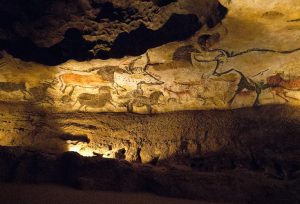
- 2. Great Hall of the Bulls
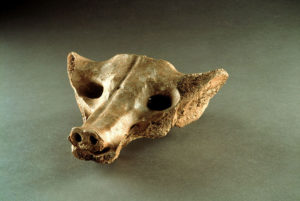
- 3. Camelid sacrum in the shape of a canine
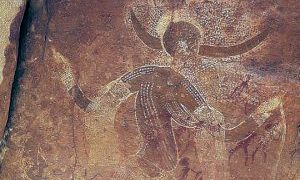
Running Horned Woman "> 4. Running Horned Woman
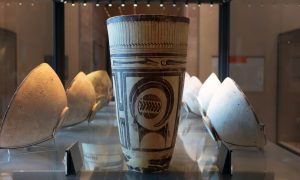
- 5. Bushel with ibex motifs
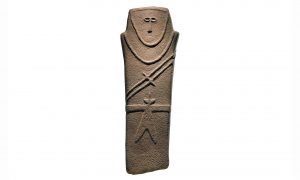
- 6. Anthropomorphic stele
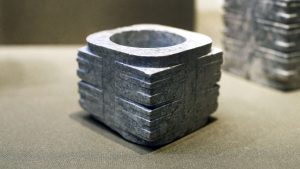
cong "> 7. Jade cong
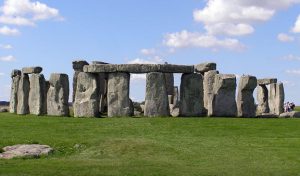
- 8. Stonehenge
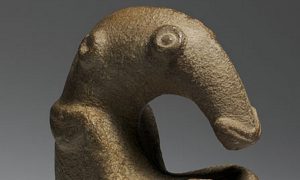
- 9. The Ambum stone
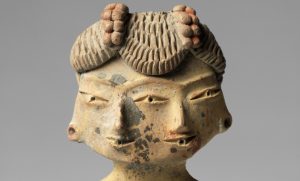
- 10. Tlatilco female figurine
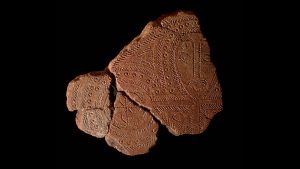
- 11. Terra cotta fragment
Content Area 2
Ancient mediterranean | 3,500 b.c.e.–300 c.e..
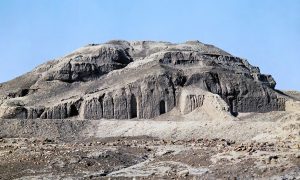
- 12. White Temple and its ziggurat
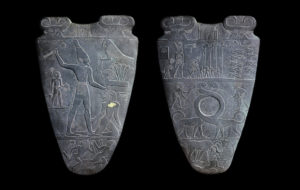
- 13. Palette of King Narmer
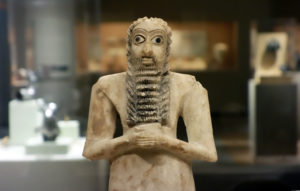
- 14. Statues of votive figures, from the Square Temple at Eshnunna (modern Tell Asmar, Iraq)
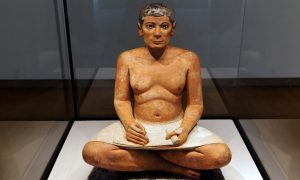
Seated scribe "> 15. Seated scribe
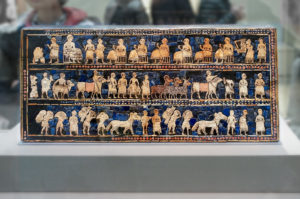
Standard of Ur from the Royal Tombs at Ur (modern Tell el-Muqayyar, Iraq)"> 16. Standard of Ur from the Royal Tombs at Ur (modern Tell el-Muqayyar, Iraq)
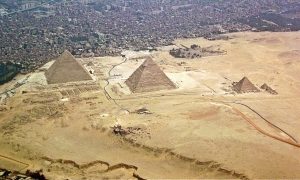
17. Great Pyramids (Menkaura, Khafre, Khufu) and Great Sphinx
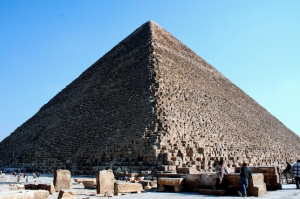
17.a. Pyramid of Khufu
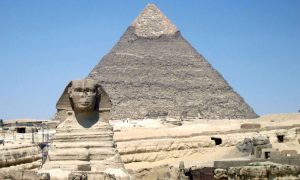
17.b. Pyramid of Khafre and the Great Sphinx
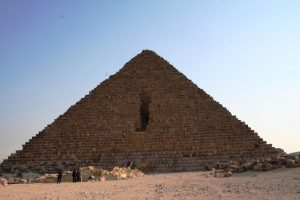
17.c. Pyramid of Menkaure
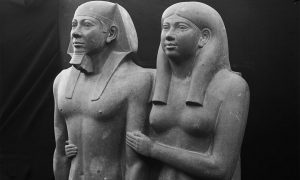
- 18. King Menkaura and queen
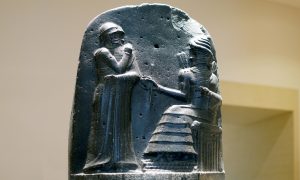
The Code of Hammurabi "> 19. The Code of Hammurabi
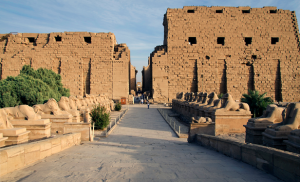
- 20. Temple of Amun-Re and the Hypostyle Hall
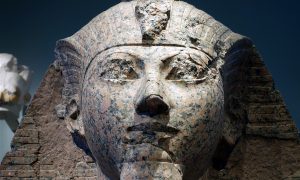
- 21. Mortuary Temple of Hatshepsut
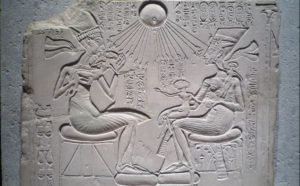
Akhenaten, Nefertiti, and three daughters "> 22. Akhenaten, Nefertiti, and three daughters
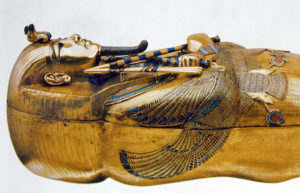
- 23. Tutankhamun’s tomb, innermost coffin
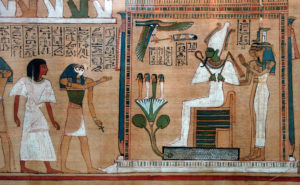
Book of the Dead )"> 24. Last judgment of Hunefer, from his tomb (page from the Book of the Dead )
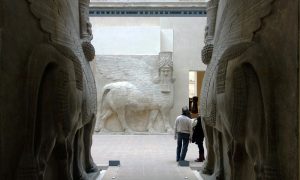
- 25. Lamassu from the citadel of Sargon II, Dur Sharrukin (modern Khorsabad, Iraq)
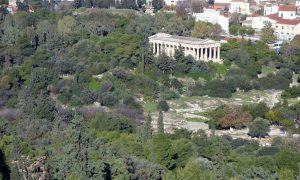
- 26. Athenian Agora
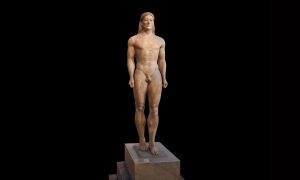
Anavysos Kouros "> 27. Anavysos Kouros
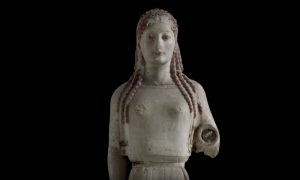
Peplos Kore from the Acropolis"> 28. Peplos Kore from the Acropolis
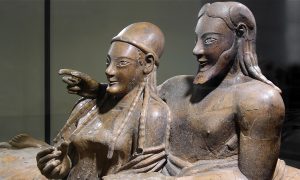
Sarcophagus of the Spouses "> 29. Sarcophagus of the Spouses
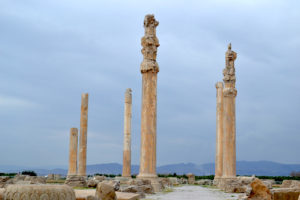
apadana ) of Darius and Xerxes"> 30. Audience Hall ( apadana ) of Darius and Xerxes
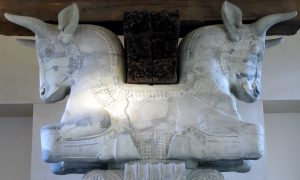
30. (related) Capital of a column from the audience hall of the palace of Darius I, Susa
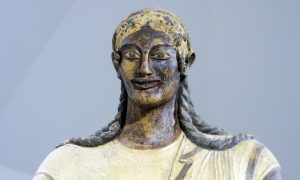
- 31. Temple of Minerva (Veii, near Rome, Italy) and sculpture of Apollo, Master sculptor Vulca
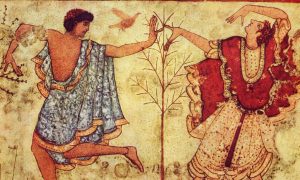
Tomb of the Triclinium "> 32. Tomb of the Triclinium
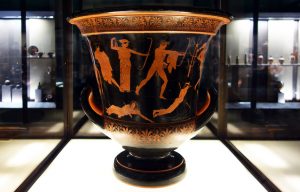
Niobides Krater "> 33. Niobides Krater
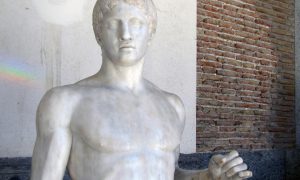
Doryphoros (Spear-Bearer) , Polykleitos"> 34. Doryphoros (Spear-Bearer) , Polykleitos
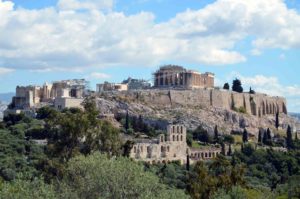
35. Acropolis
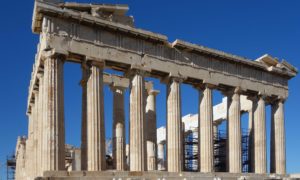
35.a. The Parthenon
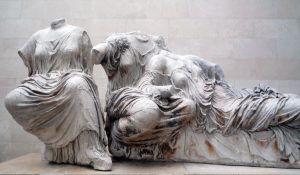
35.a.i. Parthenon sculptures (pediments, metopes and frieze)
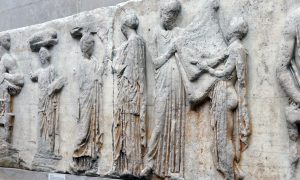
35.a.ii. Who owns the Parthenon sculptures?
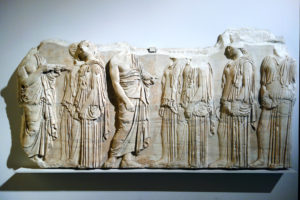
Plaque of the Ergastines "> 35.a.iii. Plaque of the Ergastines
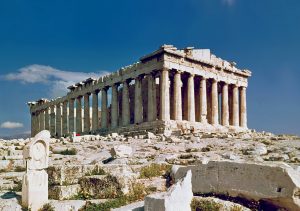
35.a.iv. The Many Lives of the Parthenon
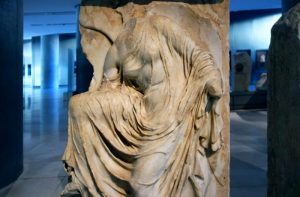
Nike Adjusting Her Sandal from the Temple of Athena Nike"> 35.b. Nike Adjusting Her Sandal from the Temple of Athena Nike
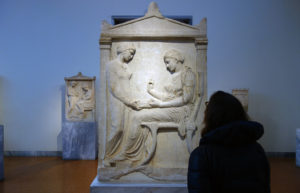
Grave stele of Hegeso "> 36. Grave stele of Hegeso
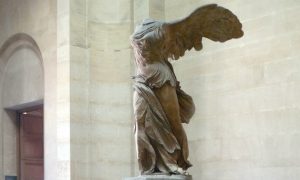
Winged Victory of Samothrace "> 37. Winged Victory of Samothrace
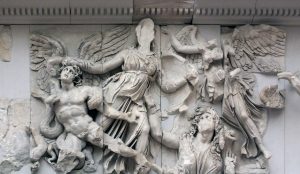
- 38. Great Altar of Zeus and Athena at Pergamon
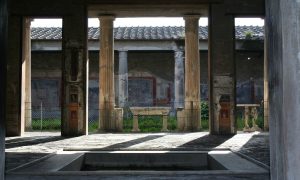
- 39. House of the Vettii
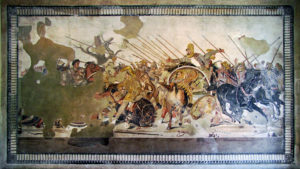
Alexander Mosaic from the House of Faun, Pompeii"> 40. Alexander Mosaic from the House of Faun, Pompeii
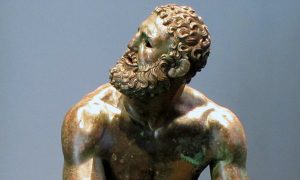
Seated Boxer "> 41. Seated Boxer
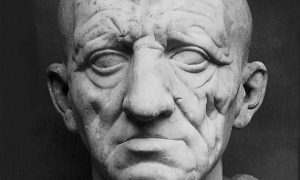
Head of a Roman patrician "> 42. Head of a Roman patrician
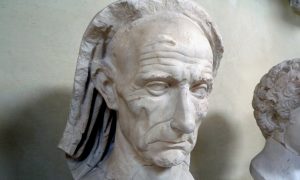
42. (related) Veristic male portrait
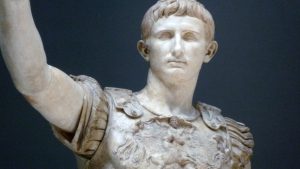
Augustus of Prima Porta "> 43. Augustus of Prima Porta
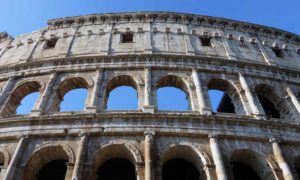
- 44. Colosseum (Flavian Amphitheater)
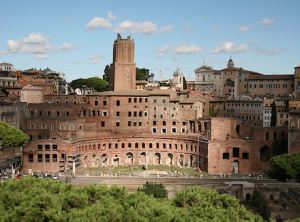
45. Forum of Trajan, Apollodorus of Damascus
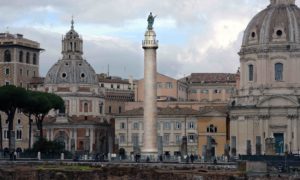
45.a. Column of Trajan
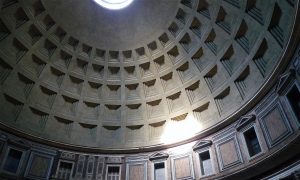
- 46. Pantheon
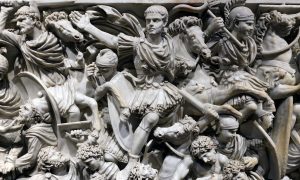
Ludovisi Battle Sarcophagus "> 47. Ludovisi Battle Sarcophagus
Content area 3, early europe and colonial americas | 200–1750 c.e..
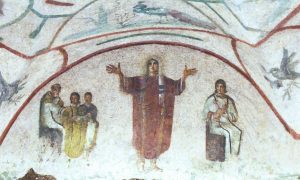
- 48. Catacomb of Priscilla
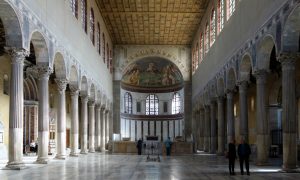
- 49. Santa Sabina
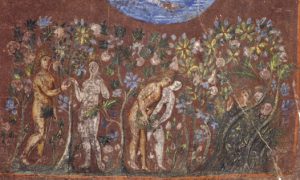
Vienna Genesis "> 50. Vienna Genesis
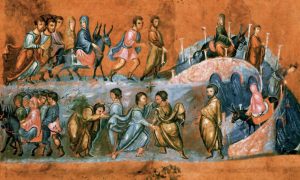
50a. Jacob Wrestling the Angel
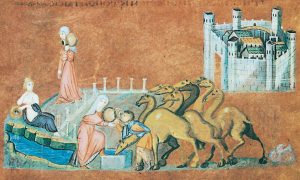
50b. Rebecca and Eliezer at the Well
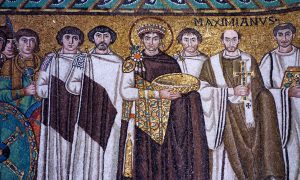
51. San Vitale
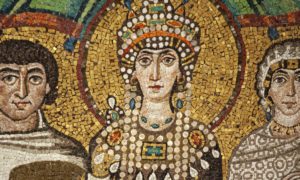
51.a. Empress Theodora, rhetoric, and Byzantine primary sources
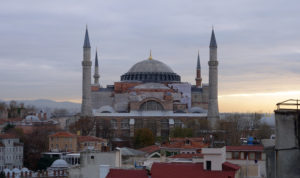
52. Hagia Sophia, Anthemius of Tralles and Isidorus of Miletus
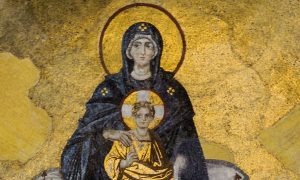
Theotokos mosaic "> 52.a. Theotokos mosaic
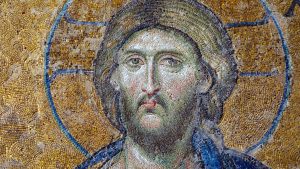
Deësis mosaic "> 52.b. Deësis mosaic
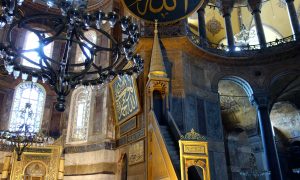
52.c. Hagia Sophia as a mosque
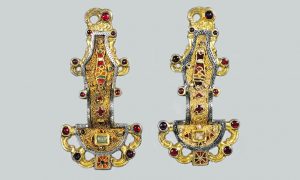
- 53. Merovingian looped fibulae
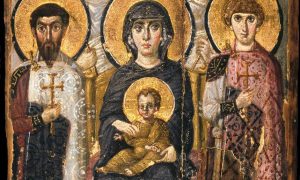
Virgin (Theotokos) and Child between Saints Theodore and George "> 54. Virgin (Theotokos) and Child between Saints Theodore and George
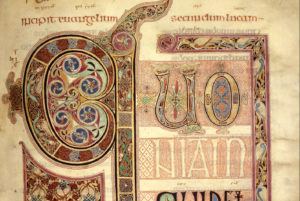
Lindisfarne Gospels : St. Matthew, cross-carpet page; St. Luke portrait page; St. Luke incipit page"> 55. Lindisfarne Gospels : St. Matthew, cross-carpet page; St. Luke portrait page; St. Luke incipit page
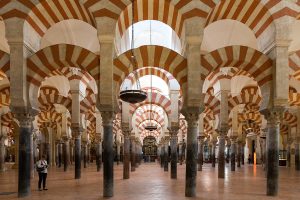
- 56. Great Mosque at Cordoba
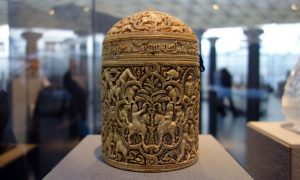
- 57. Pyxis of al-Mughira
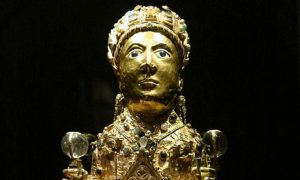
- 58. Church of Sainte-Foy
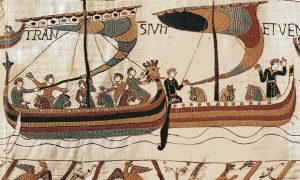
Bayeux Tapestry "> 59. Bayeux Tapestry
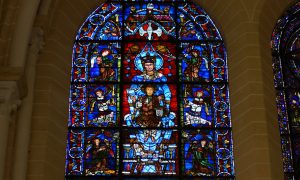
- 60. Chartres Cathedral
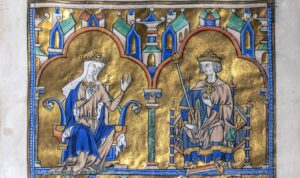
Bibles moralisées "> 61. Dedication Page with Blanche of Castile and King Louis IX of France, Scenes from the Apocalypse from Bibles moralisées
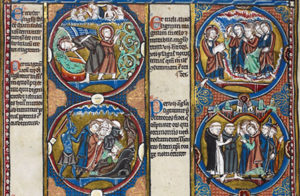
61.a. Moralized Bible (Paris-Oxford-London))
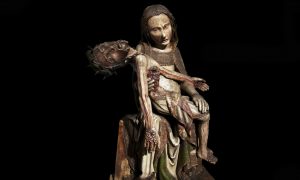
Röttgen Pietà "> 62. Röttgen Pietà
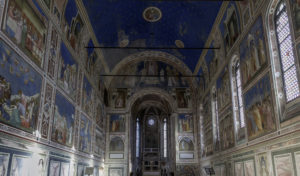
63. Arena (Scrovegni) Chapel, Giotto di Bondone
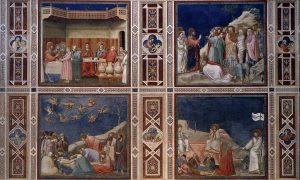
63.a. Introduction
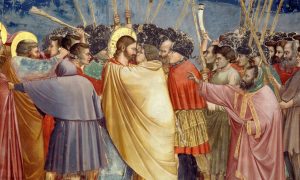
63.b. Fresco cycle
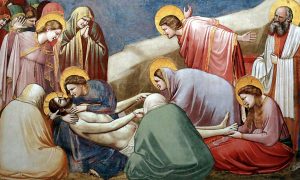
Lamentation "> 63.c. Lamentation
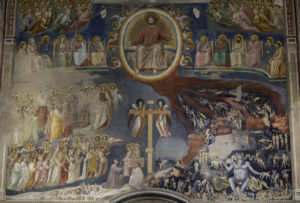
Last Judgment "> 63.d. Last Judgment
63.e. the arena chapel in virtual reality.
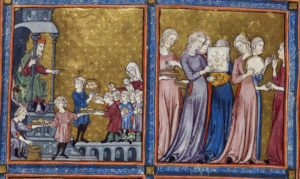
Golden Haggadah (The Plagues of Egypt, Scenes of Liberation, and Preparation for Passover)"> 64. Golden Haggadah (The Plagues of Egypt, Scenes of Liberation, and Preparation for Passover)
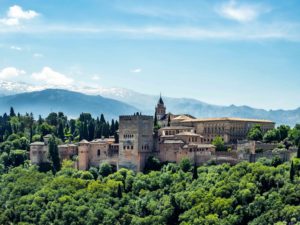
- 65. Alhambra
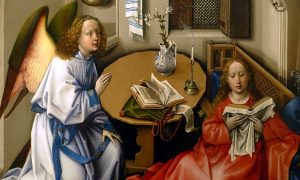
Annunciation Triptych (Merode Altarpiece) , Workshop of Robert Campin"> 66. Annunciation Triptych (Merode Altarpiece) , Workshop of Robert Campin
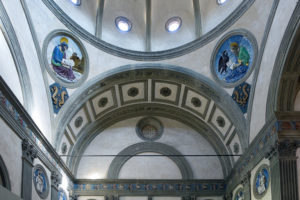
- 67. Pazzi Chapel, Filippo Brunelleschi
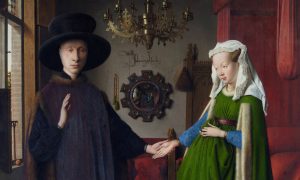
The Arnolfini Portrait , Jan Van Eyck"> 68. The Arnolfini Portrait , Jan Van Eyck
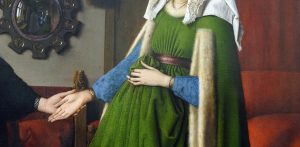
The Arnolfini Portrait "> 68.a. The question of pregnancy in The Arnolfini Portrait
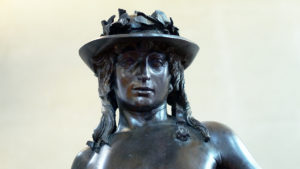
David , Donatello"> 69. David , Donatello
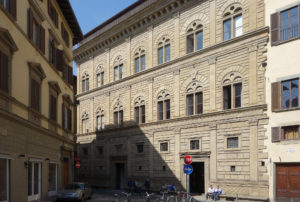
- 70. Palazzo Rucellai, Leon Battista Alberti
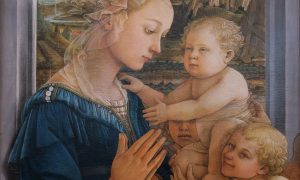
Madonna and Child with Two Angels , Fra Filippo Lippi"> 71. Madonna and Child with Two Angels , Fra Filippo Lippi
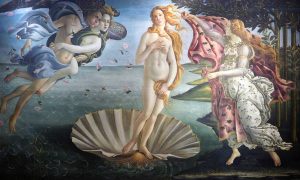
Birth of Venus , Sandro Botticelli"> 72. Birth of Venus , Sandro Botticelli
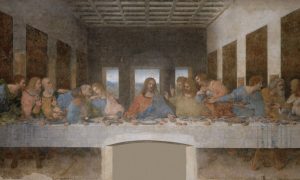
Last Supper , Leonardo da Vinci"> 73. Last Supper , Leonardo da Vinci
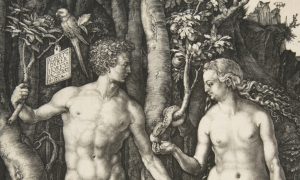
Adam and Eve , Albrecht Dürer"> 74. Adam and Eve , Albrecht Dürer
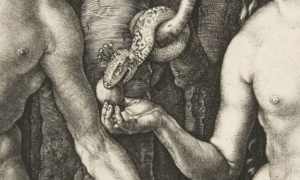
Adam and Eve "> 74.a. More about Adam and Eve
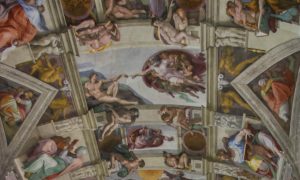
75. Sistine Chapel ceiling and altar wall frescos, Michelangelo
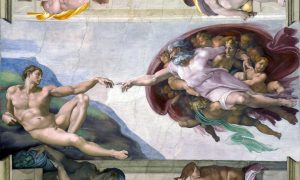
75.a. Ceiling frescoes
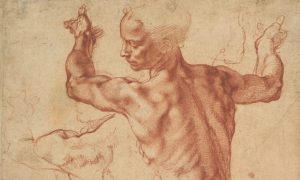
75.a.i. Studies for the Libyan Sibyl (recto); Studies for the Libyan Sibyl and a small Sketch for a Seated Figure (verso), Michelangelo
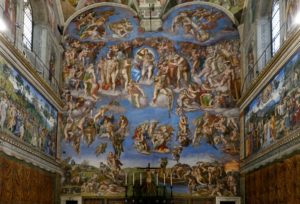
Last Judgment "> 75.b. Altar wall, Last Judgment
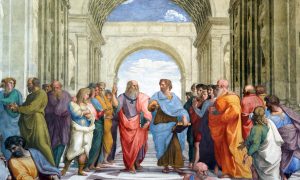
School of Athens , Raphael"> 76. School of Athens , Raphael
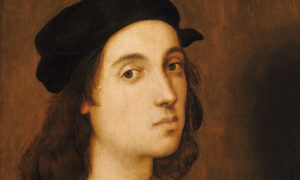
76.a. Raphael, an introduction
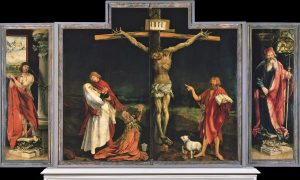
Isenheim Altarpiece , Matthias Grünewald"> 77. Isenheim Altarpiece , Matthias Grünewald
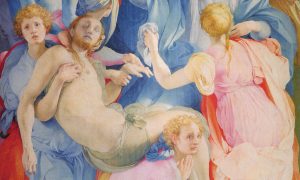
Entombment of Christ , Jacopo da Pontormo"> 78. Entombment of Christ , Jacopo da Pontormo
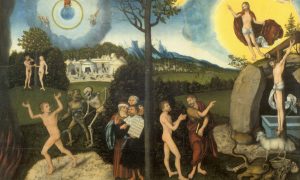
Allegory of Law and Grace , Lucas Cranach the Elder"> 79. Allegory of Law and Grace , Lucas Cranach the Elder
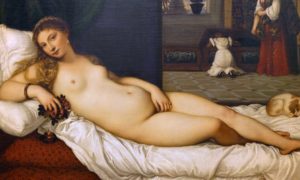
Venus of Urbino , Titian"> 80. Venus of Urbino , Titian
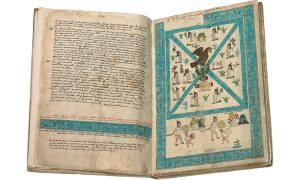
Codex Mendoza "> 81. Frontispiece of the Codex Mendoza
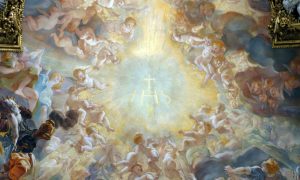
Triumph of the Name of Jesus ceiling fresco"> 82. Il Gesù, including Triumph of the Name of Jesus ceiling fresco
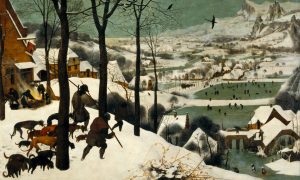
Hunters in the Snow , Pieter Bruegel the Elder"> 83. Hunters in the Snow , Pieter Bruegel the Elder
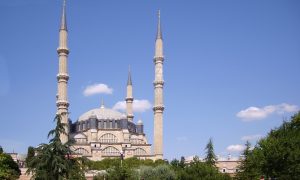
- 84. Mosque of Selim II, Mimar Sinan
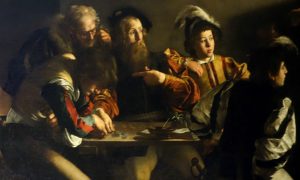
Calling of St. Matthew , Caravaggio"> 85. Calling of St. Matthew , Caravaggio
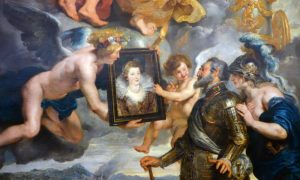
Henri IV Receives the Portrait of of Marie de’Medici , from the Marie de’Medici Cycle, Peter Paul Rubens"> 86. Henri IV Receives the Portrait of of Marie de’Medici , from the Marie de’Medici Cycle, Peter Paul Rubens
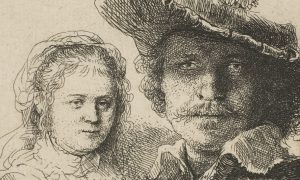
Self-Portrait with Saskia , Rembrandt van Rijn"> 87. Self-Portrait with Saskia , Rembrandt van Rijn
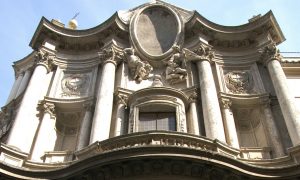
- 88. San Carlo alle Quattro Fontane, Francesco Borromini
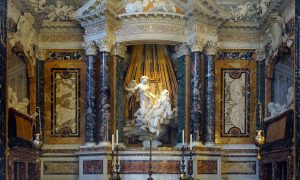
Ecstasy of Saint Teresa , Gian Lorenzo Bernini"> 89. Ecstasy of Saint Teresa , Gian Lorenzo Bernini
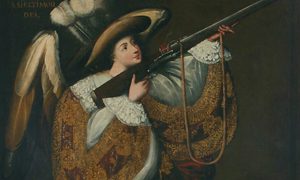
Angel with Arquebus, Asiel Timor Dei , Master of Calamarca"> 90. Angel with Arquebus, Asiel Timor Dei , Master of Calamarca
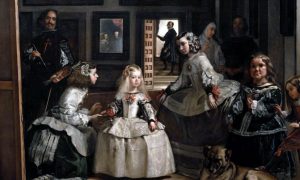
Las Meninas , Diego Velázquez"> 91. Las Meninas , Diego Velázquez
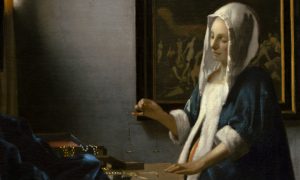
Woman Holding a Balance , Johannes Vermeer"> 92. Woman Holding a Balance , Johannes Vermeer
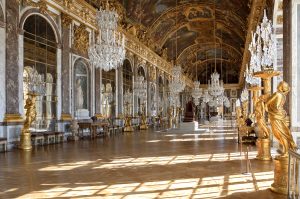
- 93. The Palace at Versailles
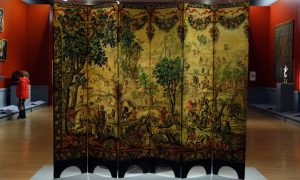
Screen with the Siege of Belgrade and hunting scene "> 94. Screen with the Siege of Belgrade and hunting scene
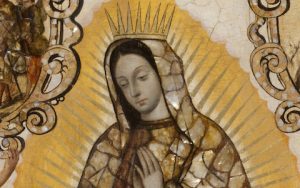
The Virgin of Guadalupe (Virgen de Guadalupe) , Miguel González"> 95. The Virgin of Guadalupe (Virgen de Guadalupe) , Miguel González
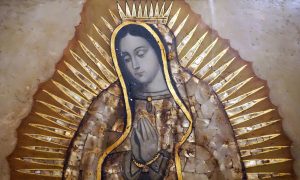
Virgin of Guadalupe "> 95. (related) Virgin of Guadalupe
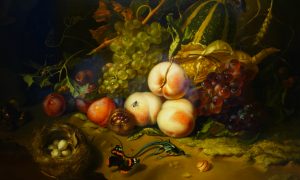
Fruit and Insects , Rachel Ruysch"> 96. Fruit and Insects , Rachel Ruysch
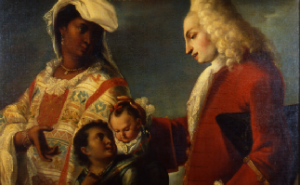
Spaniard and Indian Produce a Mestizo , attributed to Juan Rodríguez Juárez"> 97. Spaniard and Indian Produce a Mestizo , attributed to Juan Rodríguez Juárez
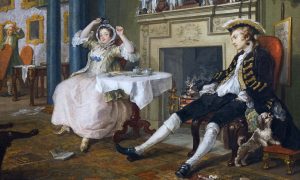
The Tête à Tête , from Marriage a la Mode , William Hogarth"> 98. The Tête à Tête , from Marriage a la Mode , William Hogarth
Content area 4, later europe and americas | 1750–1980 c.e..
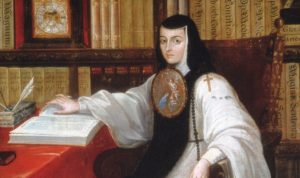
Portrait of Sor Juana Inés de la Cruz , Miguel Cabrera "> 99. Portrait of Sor Juana Inés de la Cruz , Miguel Cabrera
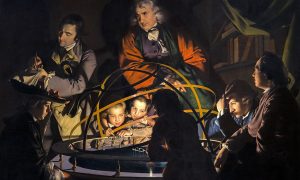
A Philosopher Giving a Lecture on the Orrery , Joseph Wright of Derby"> 100. A Philosopher Giving a Lecture on the Orrery , Joseph Wright of Derby
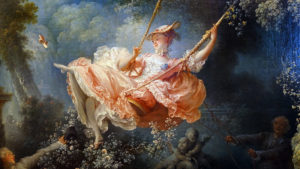
The Swing , Jean-Honoré Fragonard"> 101. The Swing , Jean-Honoré Fragonard
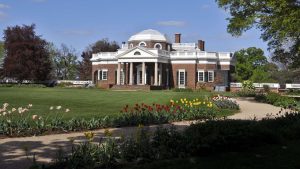
- 102. Monticello, Thomas Jefferson
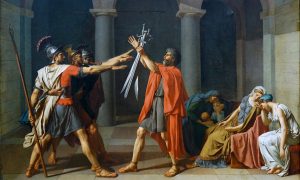
The Oath of the Horatii , Jacques-Louis David"> 103. The Oath of the Horatii , Jacques-Louis David
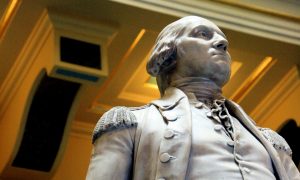
George Washington , Jean-Antoine Houdon"> 104. George Washington , Jean-Antoine Houdon
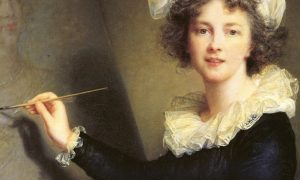
Self-Portrait , Elisabeth Vigée Le Brun"> 105. Self-Portrait , Elisabeth Vigée Le Brun
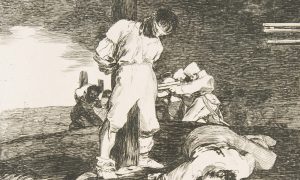
Y no hai remedio (And There’s Nothing to Be Done) , from Los Desastres de la Guerra (The Disasters of War) , plate 15, Francesco de Goya"> 106. Y no hai remedio (And There’s Nothing to Be Done) , from Los Desastres de la Guerra (The Disasters of War) , plate 15, Francesco de Goya
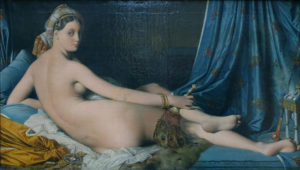
La Grande Odalisque , Jean-Auguste-Dominique Ingres"> 107. La Grande Odalisque , Jean-Auguste-Dominique Ingres
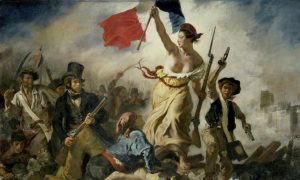
Liberty Leading the People , Eugène Delacroix"> 108. Liberty Leading the People , Eugène Delacroix
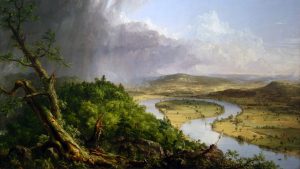
The Oxbow (View from Mount Holyoke, Northampton, Massachusetts, after a Thunderstorm) , Thomas Cole"> 109. The Oxbow (View from Mount Holyoke, Northampton, Massachusetts, after a Thunderstorm) , Thomas Cole
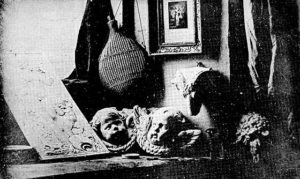
Still Life in Studio , Louis-Jacques-Mandé Daguerre"> 110. Still Life in Studio , Louis-Jacques-Mandé Daguerre
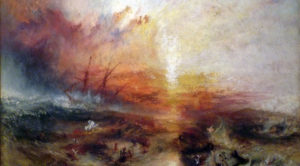
Slave Ship (Slavers Throwing Overboard the Dead and Dying, Typhoon Coming On) , J.M.W. Turner"> 111. Slave Ship (Slavers Throwing Overboard the Dead and Dying, Typhoon Coming On) , J.M.W. Turner
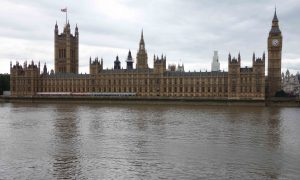
- 112. Palace of Westminster (Houses of Parliament), Charles Barry and A.W.N. Pugin
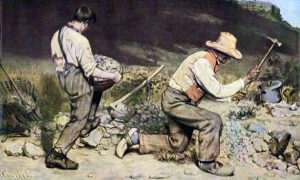
The Stone Breakers , Gustave Courbet"> 113. The Stone Breakers , Gustave Courbet
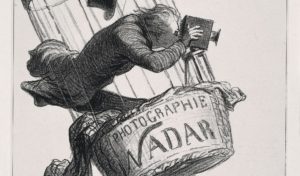
Nadar Raising Photography to the Height of Art , Honoré Daumier"> 114. Nadar Raising Photography to the Height of Art , Honoré Daumier
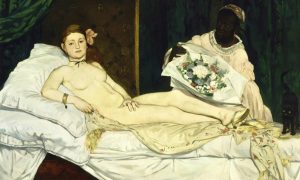
Olympia , Édouard Manet"> 115. Olympia , Édouard Manet
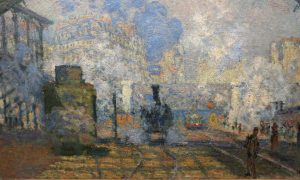
The Saint-Lazare Station , Claude Monet"> 116. The Saint-Lazare Station , Claude Monet
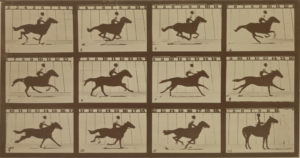
The Horse in Motion , Eadweard Muybridge"> 117. The Horse in Motion , Eadweard Muybridge
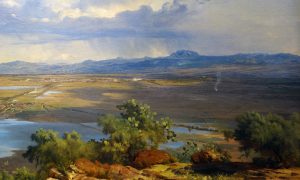
The Valley of Mexico from the Hillside of Santa Isabel (El Valle de México desde el Cerro de Santa Isabel) , José María Velasco"> 118. The Valley of Mexico from the Hillside of Santa Isabel (El Valle de México desde el Cerro de Santa Isabel) , José María Velasco
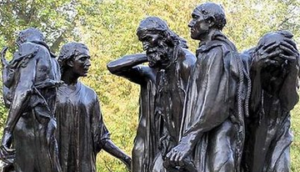
The Burghers of Calais , Auguste Rodin"> 119. The Burghers of Calais , Auguste Rodin
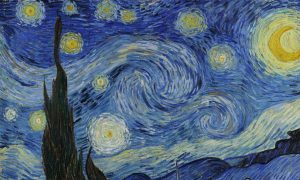
The Starry Night , Vincent van Gogh"> 120. The Starry Night , Vincent van Gogh
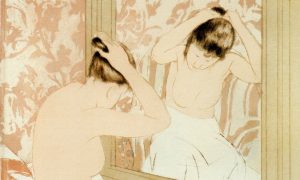
The Coiffure , Mary Cassatt"> 121. The Coiffure , Mary Cassatt
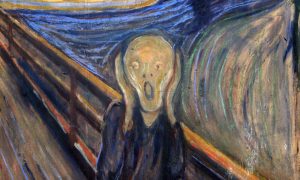
The Scream , Edvard Munch"> 122. The Scream , Edvard Munch
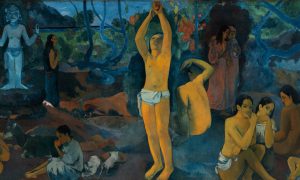
Where do we come from? What are we? Where are we going? , Paul Gauguin"> 123. Where do we come from? What are we? Where are we going? , Paul Gauguin
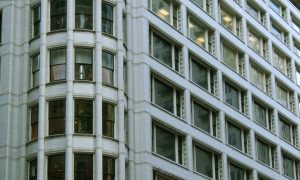
- 124. Carson, Pirie, Scott and Company Building, Louis Sullivan
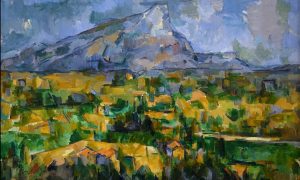
Mont Sainte-Victoire , Paul Cézanne"> 125. Mont Sainte-Victoire , Paul Cézanne
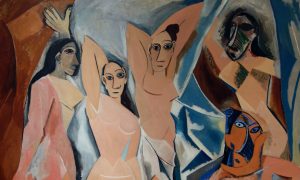
Les Demoiselles d’Avignon , Pablo Picasso"> 126. Les Demoiselles d’Avignon , Pablo Picasso
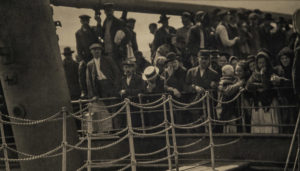
The Steerage , Alfred Stieglitz"> 127. The Steerage , Alfred Stieglitz
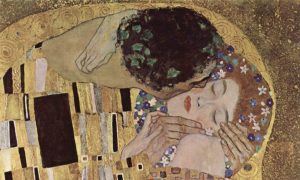
The Kiss , Gustav Klimt"> 128. The Kiss , Gustav Klimt
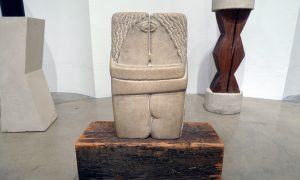
The Kiss , Constantin Brancusi"> 129. The Kiss , Constantin Brancusi
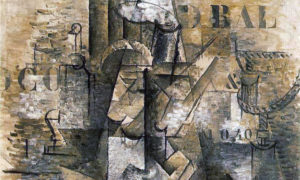
The Portuguese , Georges Braque"> 130. The Portuguese , Georges Braque
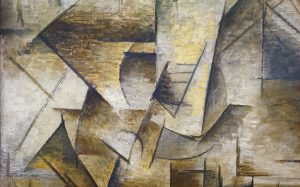
130. related Pablo Picasso and the new language of Cubism
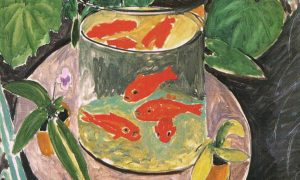
Goldfish , Henri Matisse"> 131. Goldfish , Henri Matisse
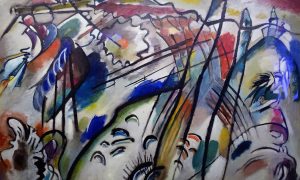
Improvisation 28 (second version) , Vasily Kandinsky"> 132. Improvisation 28 (second version) , Vasily Kandinsky
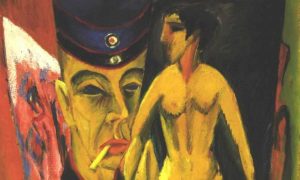
Self-Portrait As a Soldier , Ernst Ludwig Kirchner"> 133. Self-Portrait As a Soldier , Ernst Ludwig Kirchner
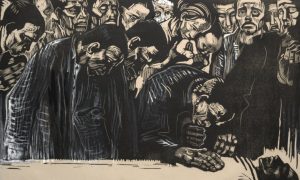
Memorial Sheet of Karl Liebknecht , Käthe Kollwitz"> 134. Memorial Sheet of Karl Liebknecht , Käthe Kollwitz
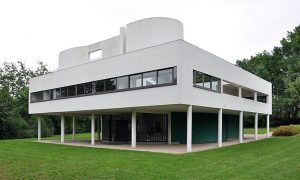
- 135. Villa Savoye, Le Corbusier
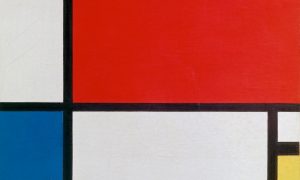
Composition with Red, Blue, and Yellow , Piet Mondrian"> 136. Composition with Red, Blue, and Yellow , Piet Mondrian
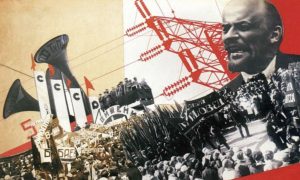
The Results of the First Five-Year Plan , Varvara Stepanova"> 137. Illustration from The Results of the First Five-Year Plan , Varvara Stepanova
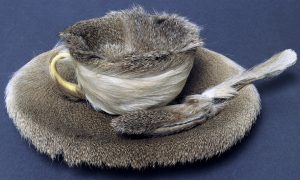
Object (Le Déjeuner en fourrure) , Meret Oppenheim"> 138. Object (Le Déjeuner en fourrure) , Meret Oppenheim
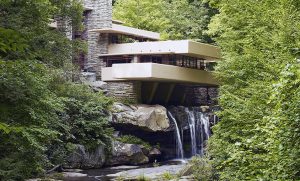
- 139. Fallingwater, Frank Lloyd Wright
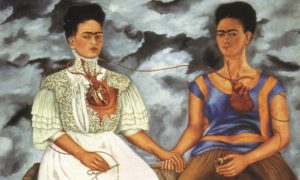
The Two Fridas (Las dos Fridas) , Frida Kahlo"> 140. The Two Fridas (Las dos Fridas) , Frida Kahlo
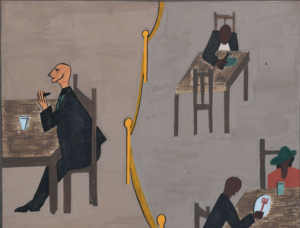
The Migration of the Negro, Panel no. 49 , Jacob Lawrence"> 141. The Migration of the Negro, Panel no. 49 , Jacob Lawrence
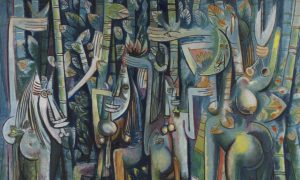
The Jungle , Wilfredo Lam"> 142. The Jungle , Wilfredo Lam
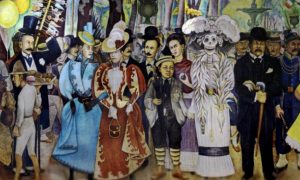
Dream of a Sunday Afternoon in the Alameda Park , Diego Rivera"> 143. Dream of a Sunday Afternoon in the Alameda Park , Diego Rivera
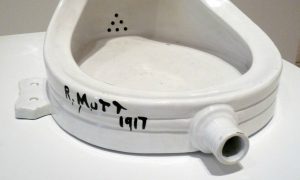
Fountain (second version), Marcel Duchamp"> 144. Fountain (second version), Marcel Duchamp
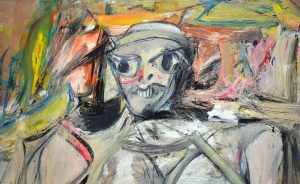
Woman, I , Willem de Kooning"> 145. Woman, I , Willem de Kooning

- 146. Seagram Building, Ludwig Mies van der Rohe, Philip Johnson
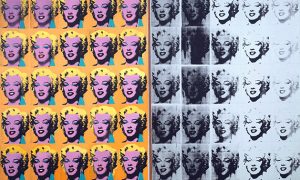
Marilyn Diptych , Andy Warhol"> 147. Marilyn Diptych , Andy Warhol
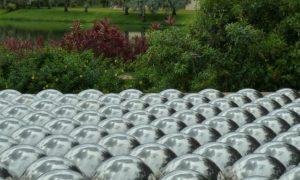
Narcissus Garden , Yayoi Kusama"> 148. Narcissus Garden , Yayoi Kusama
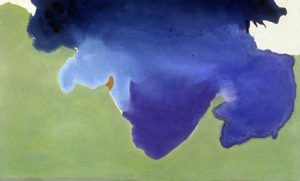
The Bay , Helen Frankenthaler"> 149. The Bay , Helen Frankenthaler
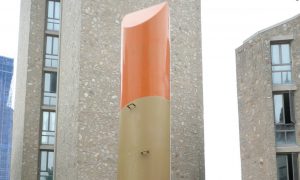
Lipstick (Ascending) on Caterpillar Tracks , Claes Oldenburg"> 150. Lipstick (Ascending) on Caterpillar Tracks , Claes Oldenburg
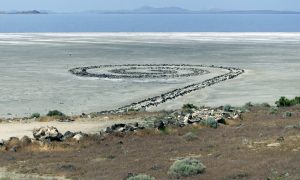
Spiral Jetty , Robert Smithson"> 151. Spiral Jetty , Robert Smithson

- 152. House in New Castle County, Robert Venturi, John Rausch and Denise Scott Brown
Content Area 5
Indigenous americas | 1000 b.c.e.–1980 c.e..
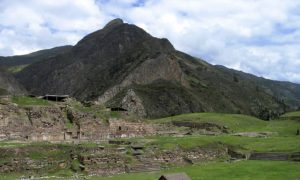
- 153. Chavín de Huántar
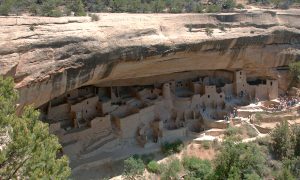
- 154. Mesa Verde cliff dwellings
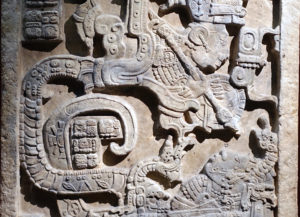
155. Yaxchilán
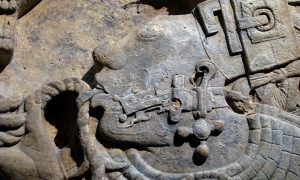

155. (related) Yaxchilán Lintels
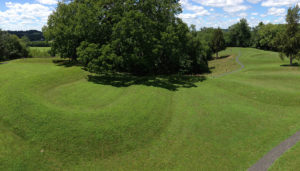
- 156. Great Serpent Mound
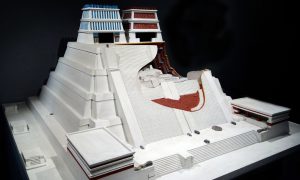
157. Templo Mayor (Main Temple)
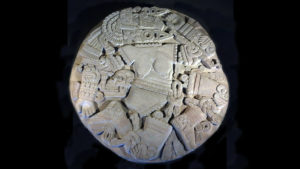
157.a. The Coyolxauhqui Stone
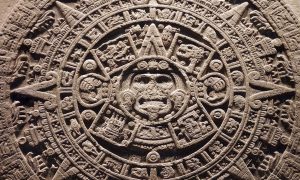
157.b. The Calendar Stone
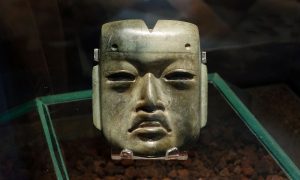
157.c. Olmec-style mask
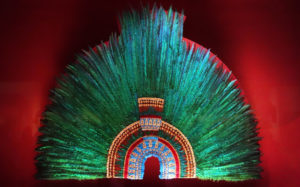
- 158. Ruler’s feather headdress (probably of Motecuhzoma II)
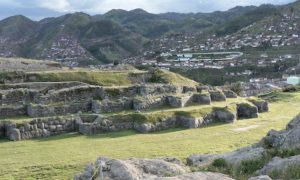
- 159. City of Cusco, including Qorikancha (Inka main temple), Santo Domingo (Spanish colonial convent), and Walls at Saqsa Waman (Sacsayhuaman)
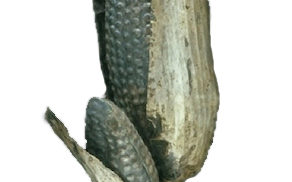
- 160. Maize cobs
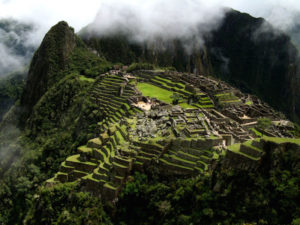
- 161. City of Machu Picchu
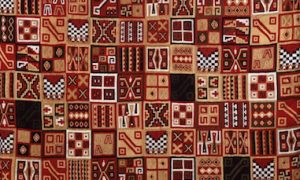
- 162. All-T’oqapu tunic
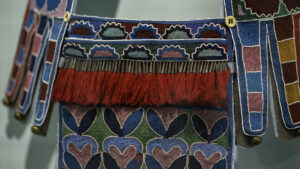
163. Bandolier bag
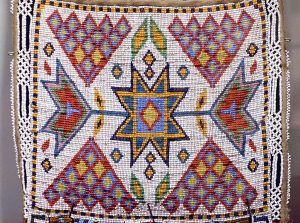
163.a. What is a bandolier bag?
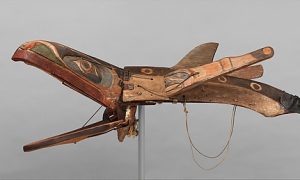
- 164. Transformation mask
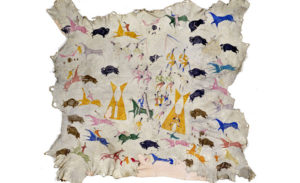
- 165. Painted elk hide, attributed to Cotsiogo (Cadzi Cody)
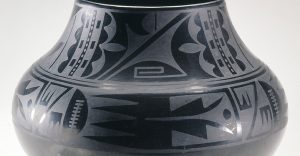
- 166. Black-on-black ceramic vessel, Maria Martínez and Julian Martínez
Content Area 6
Africa | 1100–1980 c.e..
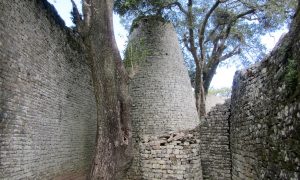
- 167. Conical tower and circular wall of Great Zimbabwe
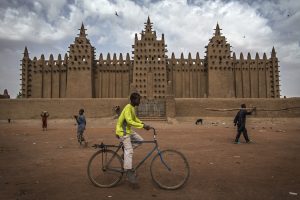
- 168. Great Mosque of Djenné
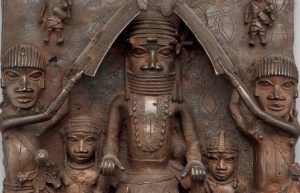
169. Wall plaque, from Oba's palace
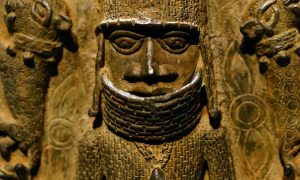
169.a. Benin plaques
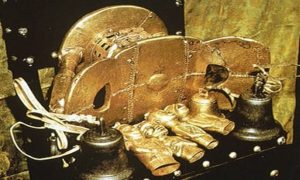
- 170. Sika dwa kofi (Golden Stool)
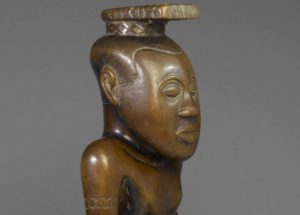
Ndop (portrait figure) of King Mishe miShyaang maMbul"> 171. Ndop (portrait figure) of King Mishe miShyaang maMbul
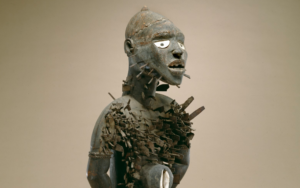
Nkisi n'kondi )"> 172. Power figure ( Nkisi n'kondi )
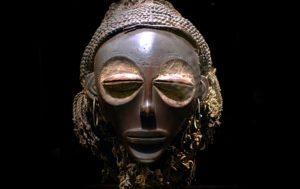
pwo ) mask"> 173. Female ( pwo ) mask
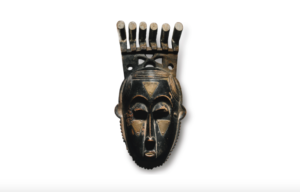
Mblo )"> 174. Portrait mask ( Mblo )
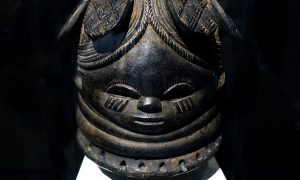
Bundu mask"> 175. Bundu mask
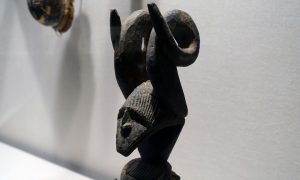
Ikenga (shrine figure)"> 176. Ikenga (shrine figure)
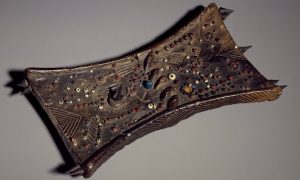
Lukasa (memory board)"> 177. Lukasa (memory board)
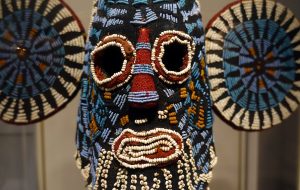
- 178. Aka elephant mask
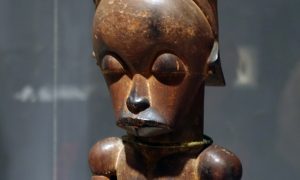
byeri )"> 179. Reliquary figure ( byeri )
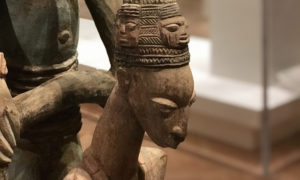
180. Veranda post of enthroned king and senior wife (Opo Ogoga)
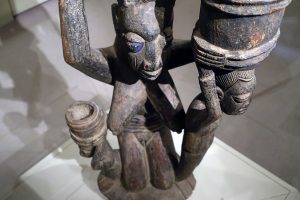
180. (related) Olowe of Ise, veranda post
Content area 7, west and central asia | 500 b.c.e.–1980 c.e..
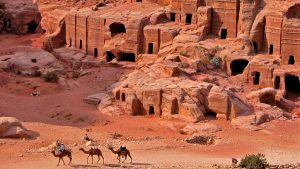
181. Petra, Jordan: Treasury and Great Temple
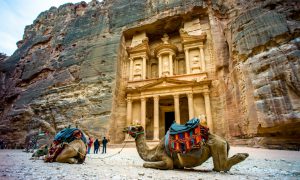
181.a. Petra and the Treasury
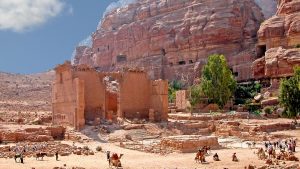
181.b. Petra and the Great Temple
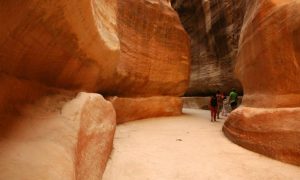
181.c. Petra: UNESCO Siq Project
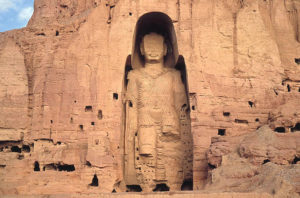
- 182. Buddha, Bamiyan

- 183. The Kaaba
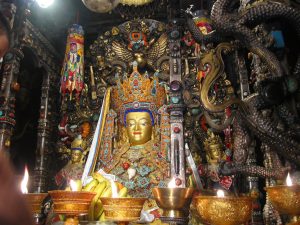
- 184. Jowo Rinpoche, enshrined in the Jokhang Temple
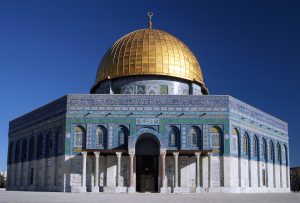
- 185. Dome of the Rock
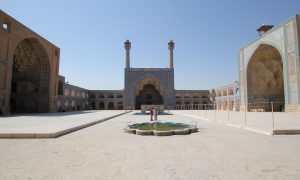
- 186. Great Mosque (Masjid-e Jameh), Isfahan
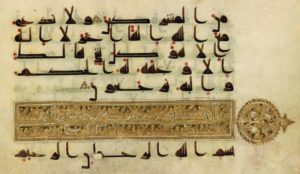
- 187. Folio from a Qur’an
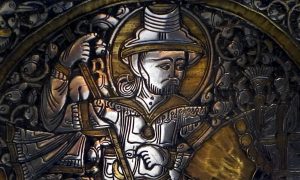
Baptistère de Saint Louis ), Mohammed ibn al-Zain"> 188. Basin ( Baptistère de Saint Louis ), Mohammed ibn al-Zain
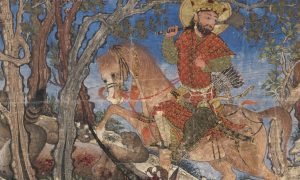
Bahram Gur Fights the Karg , folio from the Great Il-Khanid Shahnama "> 189. Bahram Gur Fights the Karg , folio from the Great Il-Khanid Shahnama
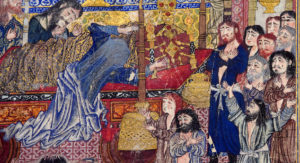
189. related Folio from a Shahnama, The Bier of Iskandar (Alexander the Great)
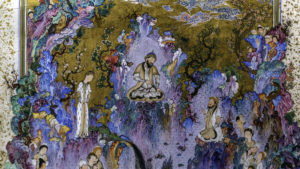
The Court of Gayumars , folio from Shah Tahmasp’s Shahnama "> 190. The Court of Gayumars , folio from Shah Tahmasp’s Shahnama
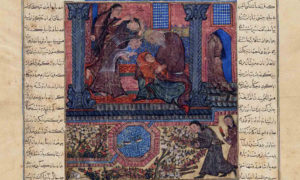
190. (related) Making and Mutilating Manuscripts of the Shahnama
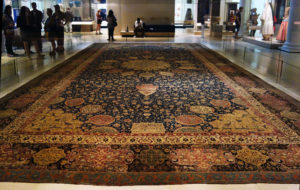
- 191. The Ardabil Carpet
Content Area 8
South, east, and southeast asia | 300 b.c.e.–1980 c.e..
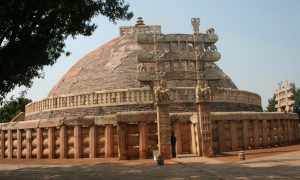
- 192. Great Stupa at Sanchi
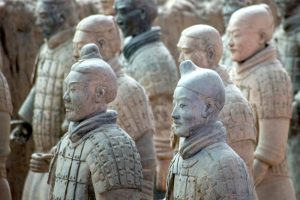
193. Terra cotta warriors from mausoleum of the first Qin emperor of China
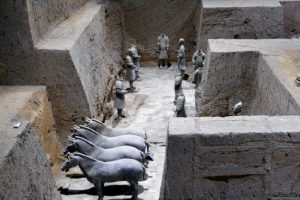
193. (related) The Tomb of the First Emperor
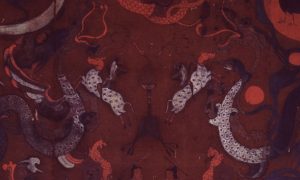
194. Funeral banner of Lady Dai (Xin Zhui)
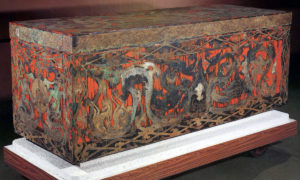
194. (related) The Tomb of Lady Dai
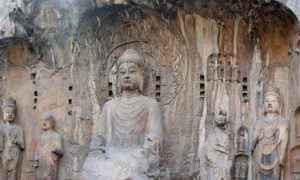
- 195. Longmen caves
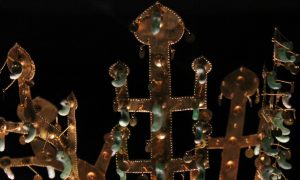
196. Gold and jade crown
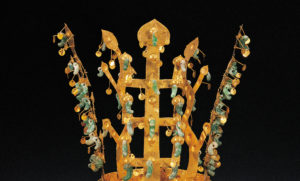
Gold crown and gold belt from the north mound of Hwangnamdaechong Tomb Gold crown and gold belt from the north mound of Hwangnamdaechong Tomb
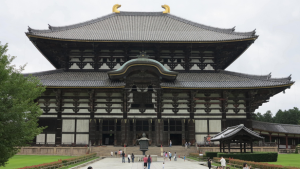
- 197. Tōdai-ji
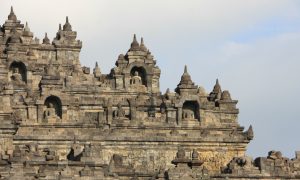
- 198. Borobudur Temple
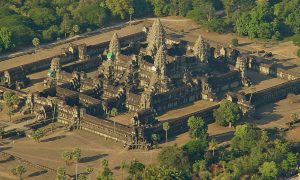
199. Angkor, the temple of Angkor Wat
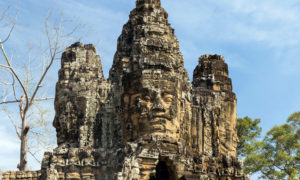
199. The city of Angkor Thom
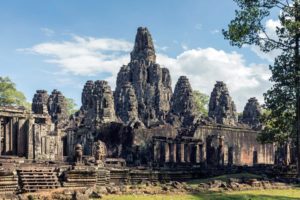
199. Bayon Temple
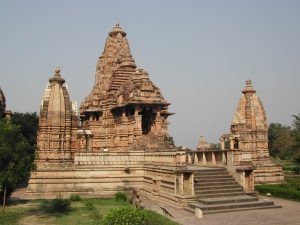
- 200. Lakshmana Temple
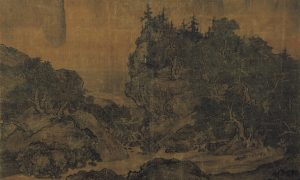
Travelers among Mountains and Streams , Fan Kuan"> 201. Travelers among Mountains and Streams , Fan Kuan
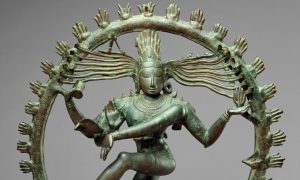
- 202. Shiva as Lord of the Dance (Nataraja)
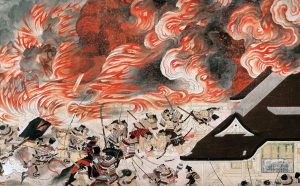
Night Attack on the Sanjô Palace "> 203. Night Attack on the Sanjô Palace
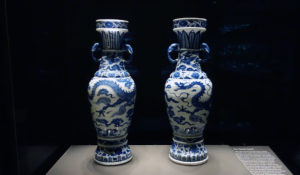
- 204. The David Vases
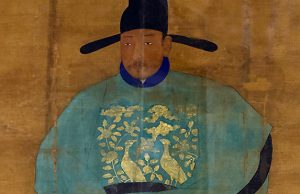
- 205. Portrait of Sin Sukju (1417–1475)
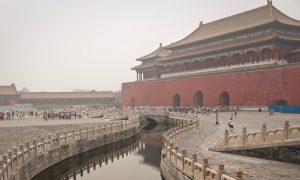
- 206. Forbidden City
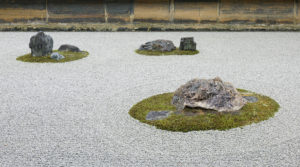
- 207. Ryōan-ji
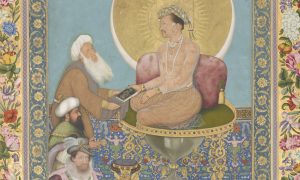
Jahangir Preferring a Sufi Shaikh to Kings , Bichitr"> 208. Jahangir Preferring a Sufi Shaikh to Kings , Bichitr
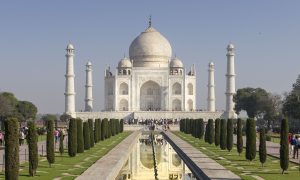
- 209. Taj Mahal
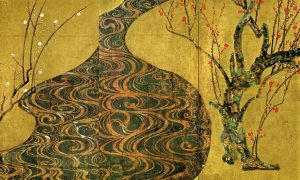
Red and White Plum Blossoms , Ogata Kōrin"> 210. Red and White Plum Blossoms , Ogata Kōrin
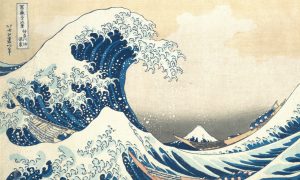
Under the Wave off Kanagawa (Kanagawa oki nami ura) , also known as The Great Wave , from the series Thirty-six Views of Mount Fuji , Katsushika Hokusai"> 211. Under the Wave off Kanagawa (Kanagawa oki nami ura) , also known as The Great Wave , from the series Thirty-six Views of Mount Fuji , Katsushika Hokusai
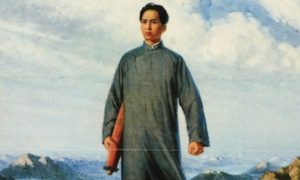
Chairman Mao en Route to Anyuan , Liu Chunhua"> 212. Chairman Mao en Route to Anyuan , Liu Chunhua
Content area 9, the pacific | 700–1980 c.e..
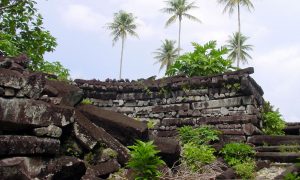
- 213. Nan Madol
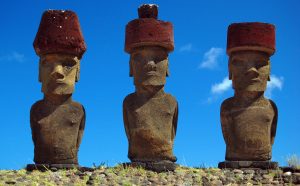
ahu )"> 214. Moai on platform ( ahu )
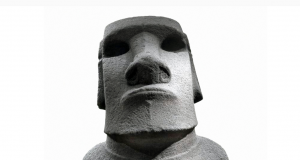
214.a. Easter Island Moai
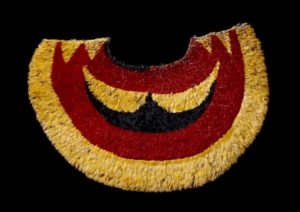
‘Ahu ‘ula (feather cape)"> 215. ‘Ahu ‘ula (feather cape)
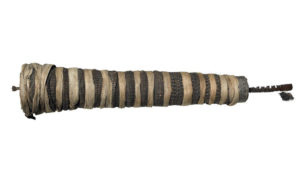
- 216. Staff god
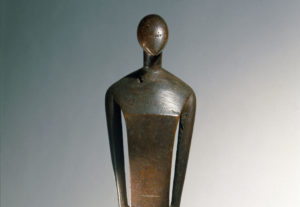
- 217. Female deity
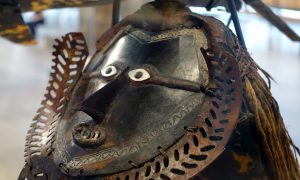
- 218. Buk (mask)
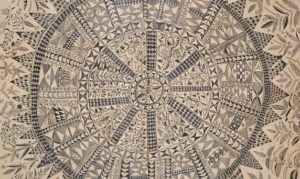
- 219. Hiapo (tapa)
Tamati Waka Nene , Gottfried Lindauer"> 220. Tamati Waka Nene , Gottfried Lindauer
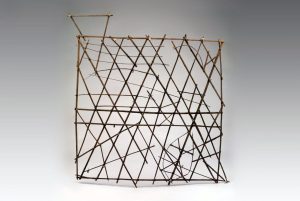
- 221. Navigation chart
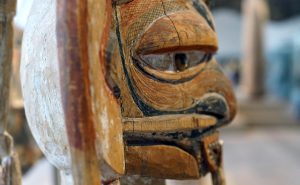
- 222. Malagan display and mask
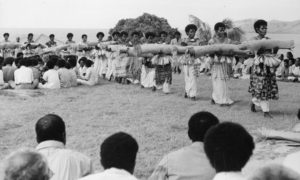
- 223. Presentation of Fijian Mats and Tapa Cloths to Queen Elizabeth II
Content Area 10
Global contemporary | 1980 c.e. to present.
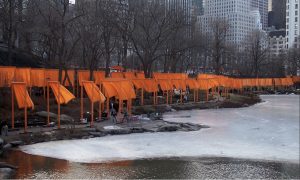
The Gates , Christo and Jeanne-Claude"> 224. The Gates , Christo and Jeanne-Claude

- 225. Vietnam Veterans Memorial, Maya Lin
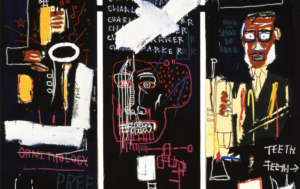
Horn Players , Jean-Michel Basquiat"> 226. Horn Players , Jean-Michel Basquiat
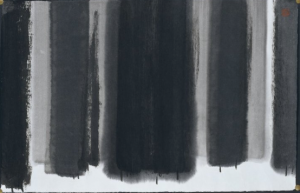
Summer Trees , Song Su-Nam"> 227. Summer Trees , Song Su-Nam
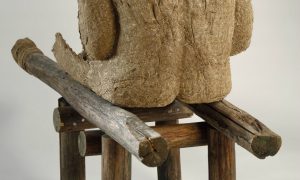
Androgyne III , Magdalena Abakanowicz"> 228. Androgyne III , Magdalena Abakanowicz

A Book from the Sky , Xu Bing"> 229. A Book from the Sky , Xu Bing
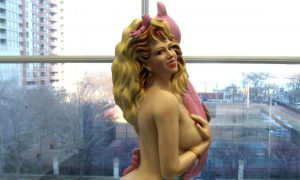
Pink Panther , Jeff Koons"> 230. Pink Panther , Jeff Koons
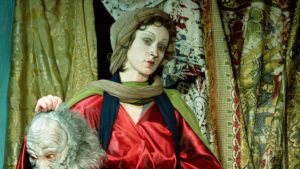
Untitled #228 , Cindy Sherman"> 231. Untitled #228 , Cindy Sherman
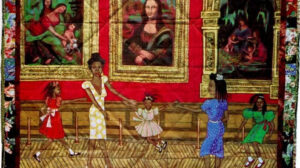
Dancing at the Louvre , from the series The French Collection , part 1; #1, Faith Ringgold"> 232. Dancing at the Louvre , from the series The French Collection , part 1; #1, Faith Ringgold
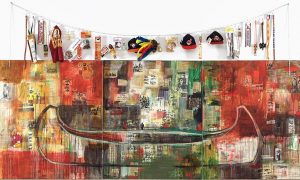
Trade (Gifts for Trading Land with White People) , Jaune Quick-to-See Smith"> 233. Trade (Gifts for Trading Land with White People) , Jaune Quick-to-See Smith
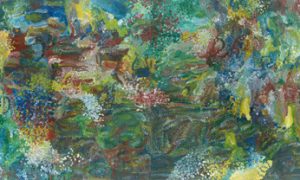
Earth’s Creation , Emily Kame Kngwarreye"> 234. Earth’s Creation , Emily Kame Kngwarreye
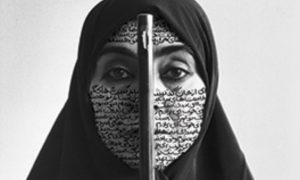
Rebellious Silence , from the Women of Allah series, Shirin Neshat (artist); photo by Cynthia Preston"> 235. Rebellious Silence , from the Women of Allah series, Shirin Neshat (artist); photo by Cynthia Preston
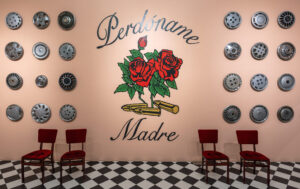
En la barberia no se llora (No Crying Allowed in the Barbershop) , Pepón Osorio"> 236. En la barberia no se llora (No Crying Allowed in the Barbershop) , Pepón Osorio
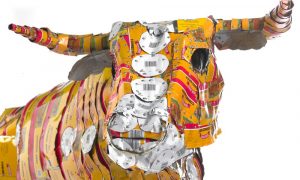
Pisupo Lua Afe (Corned Beef 2000) , Michel Tuffery"> 237. Pisupo Lua Afe (Corned Beef 2000) , Michel Tuffery

Electronic Superhighway , Nam June Paik"> 238. Electronic Superhighway , Nam June Paik

The Crossing , Bill Viola"> 239. The Crossing , Bill Viola
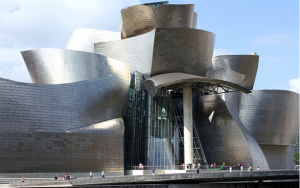
- 240. Guggenheim Museum Bilbao, Frank Gehry
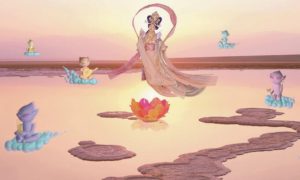
Pure Land , Mariko Mori"> 241. Pure Land , Mariko Mori
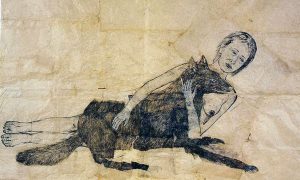
Lying with the Wolf , Kiki Smith"> 242. Lying with the Wolf , Kiki Smith
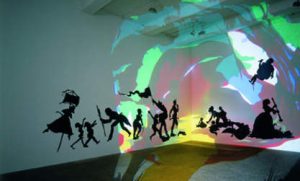
Darkytown Rebellion , Kara Walker"> 243. Darkytown Rebellion , Kara Walker
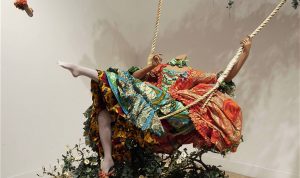
The Swing (After Fragonard) , Yinka Shonibare"> 244. The Swing (After Fragonard) , Yinka Shonibare
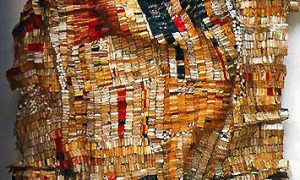
Old Man’s Cloth , El Anatsui"> 245. Old Man’s Cloth , El Anatsui
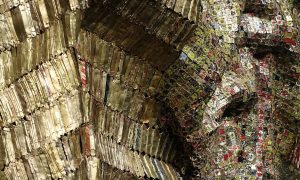
Untitled , El Anatsui"> 245. (related) Untitled , El Anatsui
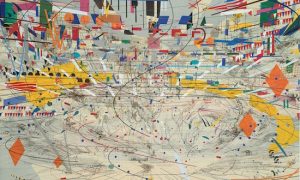
Stadia II , Julie Mehretu"> 246. Stadia II , Julie Mehretu
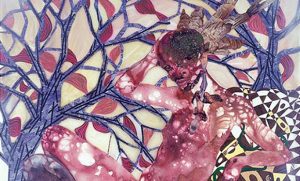
Preying Mantra , Wangechi Mutu"> 247. Preying Mantra , Wangechi Mutu
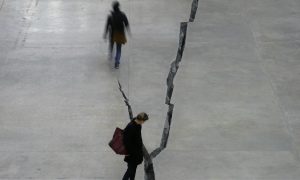
Shibboleth , Doris Salcedo"> 248. Shibboleth , Doris Salcedo
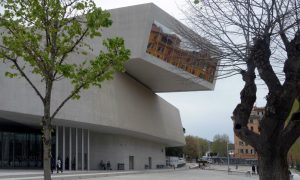
- 249. MAXXI National Museum of XXI Century Arts, Zaha Hadid
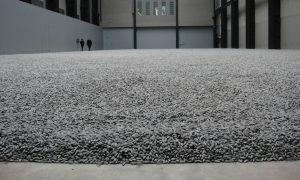
Kui Hua Zi (Sunflower Seeds) , Ai Weiwei"> 250. Kui Hua Zi (Sunflower Seeds) , Ai Weiwei

Apollo 11 Cave Stones c. 25,500–25,300 B.C.E., Namibia (photo: State Museum of Namibia)
- Origins of rock art in Africa
- Running Horned Woman " aria-label="Link to more about Running Horned Woman "> Running Horned Woman ">4. Running Horned Woman
- cong " aria-label="Link to more about Jade cong "> cong ">7. Jade cong

Remains of the Anu Ziggurat, c. 3517–3358 B.C.E., from Uruk (modern Warka) (photo: Geoff Emberling, by permission)
- Seated scribe " aria-label="Link to more about Seated scribe "> Seated scribe ">15. Seated scribe
- Standard of Ur from the Royal Tombs at Ur (modern Tell el-Muqayyar, Iraq)" aria-label="Link to more about Standard of Ur from the Royal Tombs at Ur (modern Tell el-Muqayyar, Iraq)"> Standard of Ur from the Royal Tombs at Ur (modern Tell el-Muqayyar, Iraq)">16. Standard of Ur from the Royal Tombs at Ur (modern Tell el-Muqayyar, Iraq)
- Pyramid of Khufu
- Pyramid of Khafre and the Great Sphinx
- Pyramid of Menkaure
- The Code of Hammurabi " aria-label="Link to more about The Code of Hammurabi "> The Code of Hammurabi ">19. The Code of Hammurabi
- Akhenaten, Nefertiti, and three daughters " aria-label="Link to more about Akhenaten, Nefertiti, and three daughters "> Akhenaten, Nefertiti, and three daughters ">22. Akhenaten, Nefertiti, and three daughters
- Book of the Dead )" aria-label="Link to more about Last judgment of Hunefer, from his tomb (page from the Book of the Dead )"> Book of the Dead )">24. Last judgment of Hunefer, from his tomb (page from the Book of the Dead )
- Anavysos Kouros " aria-label="Link to more about Anavysos Kouros "> Anavysos Kouros ">27. Anavysos Kouros
- Peplos Kore from the Acropolis" aria-label="Link to more about Peplos Kore from the Acropolis"> Peplos Kore from the Acropolis">28. Peplos Kore from the Acropolis
- Sarcophagus of the Spouses " aria-label="Link to more about Sarcophagus of the Spouses "> Sarcophagus of the Spouses ">29. Sarcophagus of the Spouses
- Capital of a column from the audience hall of the palace of Darius I, Susa
- Tomb of the Triclinium " aria-label="Link to more about Tomb of the Triclinium "> Tomb of the Triclinium ">32. Tomb of the Triclinium
- Niobides Krater " aria-label="Link to more about Niobides Krater "> Niobides Krater ">33. Niobides Krater
- Doryphoros (Spear-Bearer) , Polykleitos" aria-label="Link to more about Doryphoros (Spear-Bearer) , Polykleitos"> Doryphoros (Spear-Bearer) , Polykleitos">34. Doryphoros (Spear-Bearer) , Polykleitos
- Parthenon sculptures (pediments, metopes and frieze)
- Who owns the Parthenon sculptures?
- Plaque of the Ergastines , 445–438 B.C.E., Classical Period, fragment from a frieze on the Parthenon, Athens, Greece (photo: Steven Zucker, CC BY-NC-SA 2.0)" target="_blank" aria-label=" Plaque of the Ergastines "> Plaque of the Ergastines
- The Many Lives of the Parthenon
- Nike Adjusting Her Sandal , Temple of Athena Nike, c. 410 B.C.E., Classical Period, from the Temple of Athena Nike, Acropolis, Athens, Greece (photo: Steven Zucker, CC BY-NC-SA 2.0)" target="_blank" aria-label="Link to more about Nike Adjusting Her Sandal from the Temple of Athena Nike"> Nike Adjusting Her Sandal from the Temple of Athena Nike
- Grave stele of Hegeso " aria-label="Link to more about Grave stele of Hegeso "> Grave stele of Hegeso ">36. Grave stele of Hegeso
- Winged Victory of Samothrace " aria-label="Link to more about Winged Victory of Samothrace "> Winged Victory of Samothrace ">37. Winged Victory of Samothrace
- Alexander Mosaic from the House of Faun, Pompeii" aria-label="Link to more about Alexander Mosaic from the House of Faun, Pompeii"> Alexander Mosaic from the House of Faun, Pompeii">40. Alexander Mosaic from the House of Faun, Pompeii
- Seated Boxer " aria-label="Link to more about Seated Boxer "> Seated Boxer ">41. Seated Boxer
- Veristic male portrait
- Augustus of Prima Porta " aria-label="Link to more about Augustus of Prima Porta "> Augustus of Prima Porta ">43. Augustus of Prima Porta
- Column of Trajan
- Ludovisi Battle Sarcophagus " aria-label="Link to more about Ludovisi Battle Sarcophagus "> Ludovisi Battle Sarcophagus ">47. Ludovisi Battle Sarcophagus

Detail of the Cubiculum of the Veiled Woman, Catacomb of Priscilla, late 2nd century–4th century C.E., Late Antique Europe, Rome, Italy
- Vienna Genesis , folio 12v, early 6th century, Early Byzantine Europe" target="_blank" aria-label="Link to more about Jacob Wrestling the Angel"> Jacob Wrestling the Angel
- Vienna Genesis , folio 7 recto, early 6th century, Early Byzantine Europe" target="_blank" aria-label="Link to more about Rebecca and Eliezer at the Well"> Rebecca and Eliezer at the Well
- Empress Theodora, rhetoric, and Byzantine primary sources
- Theotokos mosaic , 867, Middle Byzantine Europe, apse of the Hagia Sophia, Istanbul (photo: Steven Zucker, CC BY-NC-SA 2.0)" target="_blank" aria-label="Link to more about Theotokos mosaic "> Theotokos mosaic
- Deësis (Christ with the Virgin Mary and John the Baptist) , c. 1261, Late Byzantine Europe, at the Hagia Sophia, Istanbul (photo: Steven Zucker, CC BY-NC-SA 2.0)" target="_blank" aria-label="Link to more about Deësis mosaic "> Deësis mosaic
- Hagia Sophia as a mosque
- Virgin (Theotokos) and Child between Saints Theodore and George " aria-label="Link to more about Virgin (Theotokos) and Child between Saints Theodore and George "> Virgin (Theotokos) and Child between Saints Theodore and George ">54. Virgin (Theotokos) and Child between Saints Theodore and George
- Lindisfarne Gospels : St. Matthew, cross-carpet page; St. Luke portrait page; St. Luke incipit page" aria-label="Link to more about Lindisfarne Gospels : St. Matthew, cross-carpet page; St. Luke portrait page; St. Luke incipit page"> Lindisfarne Gospels : St. Matthew, cross-carpet page; St. Luke portrait page; St. Luke incipit page">55. Lindisfarne Gospels : St. Matthew, cross-carpet page; St. Luke portrait page; St. Luke incipit page
- Bayeux Tapestry " aria-label="Link to more about Bayeux Tapestry "> Bayeux Tapestry ">59. Bayeux Tapestry
- Moralized Bible (Paris-Oxford-London))
- Röttgen Pietà " aria-label="Link to more about Röttgen Pietà "> Röttgen Pietà ">62. Röttgen Pietà
- Introduction
- Fresco cycle
- Lamentation "> Lamentation
- Last Judgment "> Last Judgment
- The Arena Chapel in virtual reality
- Golden Haggadah (The Plagues of Egypt, Scenes of Liberation, and Preparation for Passover)" aria-label="Link to more about Golden Haggadah (The Plagues of Egypt, Scenes of Liberation, and Preparation for Passover)"> Golden Haggadah (The Plagues of Egypt, Scenes of Liberation, and Preparation for Passover)">64. Golden Haggadah (The Plagues of Egypt, Scenes of Liberation, and Preparation for Passover)
- Annunciation Triptych (Merode Altarpiece) , Workshop of Robert Campin" aria-label="Link to more about Annunciation Triptych (Merode Altarpiece) , Workshop of Robert Campin"> Annunciation Triptych (Merode Altarpiece) , Workshop of Robert Campin">66. Annunciation Triptych (Merode Altarpiece) , Workshop of Robert Campin
- The Arnolfini Portrait , 1434, Northern Renaissance (photo: Steven Zucker, CC BY-NC-SA 2.0)" target="_blank" aria-label="Link to more about The question of pregnancy in The Arnolfini Portrait "> The question of pregnancy in The Arnolfini Portrait
- David , Donatello" aria-label="Link to more about David , Donatello"> David , Donatello">69. David , Donatello
- Madonna and Child with Two Angels , Fra Filippo Lippi" aria-label="Link to more about Madonna and Child with Two Angels , Fra Filippo Lippi"> Madonna and Child with Two Angels , Fra Filippo Lippi">71. Madonna and Child with Two Angels , Fra Filippo Lippi
- Birth of Venus , Sandro Botticelli" aria-label="Link to more about Birth of Venus , Sandro Botticelli"> Birth of Venus , Sandro Botticelli">72. Birth of Venus , Sandro Botticelli
- Last Supper , Leonardo da Vinci" aria-label="Link to more about Last Supper , Leonardo da Vinci"> Last Supper , Leonardo da Vinci">73. Last Supper , Leonardo da Vinci
- Adam and Eve , 1504, Renaissance, Germany" target="_blank" aria-label="Link to more about More about Adam and Eve "> More about Adam and Eve
- Studies for the Libyan Sibyl (recto); Studies for the Libyan Sibyl and a small Sketch for a Seated Figure (verso), Michelangelo
- Last Judgment , 1534–1541, High Renaissance, altar wall, Sistine Chapel, Vatican City, Rome (photo: Richard Mortel, CC BY 2.0)" target="_blank" aria-label="Link to more about Altar wall, Last Judgment "> Altar wall, Last Judgment
- Self Portrait , 1504–05" target="_blank" aria-label="Link to more about Raphael, an introduction"> Raphael, an introduction
- Isenheim Altarpiece , Matthias Grünewald" aria-label="Link to more about Isenheim Altarpiece , Matthias Grünewald"> Isenheim Altarpiece , Matthias Grünewald">77. Isenheim Altarpiece , Matthias Grünewald
- Entombment of Christ , Jacopo da Pontormo" aria-label="Link to more about Entombment of Christ , Jacopo da Pontormo"> Entombment of Christ , Jacopo da Pontormo">78. Entombment of Christ , Jacopo da Pontormo
- Allegory of Law and Grace , Lucas Cranach the Elder" aria-label="Link to more about Allegory of Law and Grace , Lucas Cranach the Elder"> Allegory of Law and Grace , Lucas Cranach the Elder">79. Allegory of Law and Grace , Lucas Cranach the Elder
- Venus of Urbino , Titian" aria-label="Link to more about Venus of Urbino , Titian"> Venus of Urbino , Titian">80. Venus of Urbino , Titian
- Codex Mendoza " aria-label="Link to more about Frontispiece of the Codex Mendoza "> Codex Mendoza ">81. Frontispiece of the Codex Mendoza
- Triumph of the Name of Jesus ceiling fresco" aria-label="Link to more about Il Gesù, including Triumph of the Name of Jesus ceiling fresco"> Triumph of the Name of Jesus ceiling fresco">82. Il Gesù, including Triumph of the Name of Jesus ceiling fresco
- Hunters in the Snow , Pieter Bruegel the Elder" aria-label="Link to more about Hunters in the Snow , Pieter Bruegel the Elder"> Hunters in the Snow , Pieter Bruegel the Elder">83. Hunters in the Snow , Pieter Bruegel the Elder
- Calling of St. Matthew , Caravaggio" aria-label="Link to more about Calling of St. Matthew , Caravaggio"> Calling of St. Matthew , Caravaggio">85. Calling of St. Matthew , Caravaggio
- Henri IV Receives the Portrait of of Marie de’Medici , from the Marie de’Medici Cycle, Peter Paul Rubens" aria-label="Link to more about Henri IV Receives the Portrait of of Marie de’Medici , from the Marie de’Medici Cycle, Peter Paul Rubens"> Henri IV Receives the Portrait of of Marie de’Medici , from the Marie de’Medici Cycle, Peter Paul Rubens">86. Henri IV Receives the Portrait of of Marie de’Medici , from the Marie de’Medici Cycle, Peter Paul Rubens
- Self-Portrait with Saskia , Rembrandt van Rijn" aria-label="Link to more about Self-Portrait with Saskia , Rembrandt van Rijn"> Self-Portrait with Saskia , Rembrandt van Rijn">87. Self-Portrait with Saskia , Rembrandt van Rijn
- Ecstasy of Saint Teresa , Gian Lorenzo Bernini" aria-label="Link to more about Ecstasy of Saint Teresa , Gian Lorenzo Bernini"> Ecstasy of Saint Teresa , Gian Lorenzo Bernini">89. Ecstasy of Saint Teresa , Gian Lorenzo Bernini
- Angel with Arquebus, Asiel Timor Dei , Master of Calamarca" aria-label="Link to more about Angel with Arquebus, Asiel Timor Dei , Master of Calamarca"> Angel with Arquebus, Asiel Timor Dei , Master of Calamarca">90. Angel with Arquebus, Asiel Timor Dei , Master of Calamarca
- Las Meninas , Diego Velázquez" aria-label="Link to more about Las Meninas , Diego Velázquez"> Las Meninas , Diego Velázquez">91. Las Meninas , Diego Velázquez
- Woman Holding a Balance , Johannes Vermeer" aria-label="Link to more about Woman Holding a Balance , Johannes Vermeer"> Woman Holding a Balance , Johannes Vermeer">92. Woman Holding a Balance , Johannes Vermeer
- Screen with the Siege of Belgrade and hunting scene " aria-label="Link to more about Screen with the Siege of Belgrade and hunting scene "> Screen with the Siege of Belgrade and hunting scene ">94. Screen with the Siege of Belgrade and hunting scene
- Virgin of Guadalupe , late 17th century, New Spain (photo: Steven Zucker, CC BY-NC-SA 2.0)" target="_blank" aria-label="Link to more about Virgin of Guadalupe "> Virgin of Guadalupe
- Fruit and Insects , Rachel Ruysch" aria-label="Link to more about Fruit and Insects , Rachel Ruysch"> Fruit and Insects , Rachel Ruysch">96. Fruit and Insects , Rachel Ruysch
- Spaniard and Indian Produce a Mestizo , attributed to Juan Rodríguez Juárez" aria-label="Link to more about Spaniard and Indian Produce a Mestizo , attributed to Juan Rodríguez Juárez"> Spaniard and Indian Produce a Mestizo , attributed to Juan Rodríguez Juárez">97. Spaniard and Indian Produce a Mestizo , attributed to Juan Rodríguez Juárez
- The Tête à Tête , from Marriage a la Mode , William Hogarth" aria-label="Link to more about The Tête à Tête , from Marriage a la Mode , William Hogarth"> The Tête à Tête , from Marriage a la Mode , William Hogarth">98. The Tête à Tête , from Marriage a la Mode , William Hogarth
Miguel Cabrera, Portrait of Sor Juana Inés de la Cruz (detail), c. 1750, New Spain
- Portrait of Sor Juana Inés de la Cruz , Miguel Cabrera " aria-label="Link to more about Portrait of Sor Juana Inés de la Cruz , Miguel Cabrera "> Portrait of Sor Juana Inés de la Cruz , Miguel Cabrera ">99. Portrait of Sor Juana Inés de la Cruz , Miguel Cabrera
- A Philosopher Giving a Lecture on the Orrery , Joseph Wright of Derby" aria-label="Link to more about A Philosopher Giving a Lecture on the Orrery , Joseph Wright of Derby"> A Philosopher Giving a Lecture on the Orrery , Joseph Wright of Derby">100. A Philosopher Giving a Lecture on the Orrery , Joseph Wright of Derby
- The Swing , Jean-Honoré Fragonard" aria-label="Link to more about The Swing , Jean-Honoré Fragonard"> The Swing , Jean-Honoré Fragonard">101. The Swing , Jean-Honoré Fragonard
- The Oath of the Horatii , Jacques-Louis David" aria-label="Link to more about The Oath of the Horatii , Jacques-Louis David"> The Oath of the Horatii , Jacques-Louis David">103. The Oath of the Horatii , Jacques-Louis David
- George Washington , Jean-Antoine Houdon" aria-label="Link to more about George Washington , Jean-Antoine Houdon"> George Washington , Jean-Antoine Houdon">104. George Washington , Jean-Antoine Houdon
- Self-Portrait , Elisabeth Vigée Le Brun" aria-label="Link to more about Self-Portrait , Elisabeth Vigée Le Brun"> Self-Portrait , Elisabeth Vigée Le Brun">105. Self-Portrait , Elisabeth Vigée Le Brun
- Y no hai remedio (And There’s Nothing to Be Done) , from Los Desastres de la Guerra (The Disasters of War) , plate 15, Francesco de Goya" aria-label="Link to more about Y no hai remedio (And There’s Nothing to Be Done) , from Los Desastres de la Guerra (The Disasters of War) , plate 15, Francesco de Goya"> Y no hai remedio (And There’s Nothing to Be Done) , from Los Desastres de la Guerra (The Disasters of War) , plate 15, Francesco de Goya">106. Y no hai remedio (And There’s Nothing to Be Done) , from Los Desastres de la Guerra (The Disasters of War) , plate 15, Francesco de Goya
- La Grande Odalisque , Jean-Auguste-Dominique Ingres" aria-label="Link to more about La Grande Odalisque , Jean-Auguste-Dominique Ingres"> La Grande Odalisque , Jean-Auguste-Dominique Ingres">107. La Grande Odalisque , Jean-Auguste-Dominique Ingres
- Liberty Leading the People , Eugène Delacroix" aria-label="Link to more about Liberty Leading the People , Eugène Delacroix"> Liberty Leading the People , Eugène Delacroix">108. Liberty Leading the People , Eugène Delacroix
- The Oxbow (View from Mount Holyoke, Northampton, Massachusetts, after a Thunderstorm) , Thomas Cole" aria-label="Link to more about The Oxbow (View from Mount Holyoke, Northampton, Massachusetts, after a Thunderstorm) , Thomas Cole"> The Oxbow (View from Mount Holyoke, Northampton, Massachusetts, after a Thunderstorm) , Thomas Cole">109. The Oxbow (View from Mount Holyoke, Northampton, Massachusetts, after a Thunderstorm) , Thomas Cole
- Still Life in Studio , Louis-Jacques-Mandé Daguerre" aria-label="Link to more about Still Life in Studio , Louis-Jacques-Mandé Daguerre"> Still Life in Studio , Louis-Jacques-Mandé Daguerre">110. Still Life in Studio , Louis-Jacques-Mandé Daguerre
- Slave Ship (Slavers Throwing Overboard the Dead and Dying, Typhoon Coming On) , J.M.W. Turner" aria-label="Link to more about Slave Ship (Slavers Throwing Overboard the Dead and Dying, Typhoon Coming On) , J.M.W. Turner"> Slave Ship (Slavers Throwing Overboard the Dead and Dying, Typhoon Coming On) , J.M.W. Turner">111. Slave Ship (Slavers Throwing Overboard the Dead and Dying, Typhoon Coming On) , J.M.W. Turner
- The Stone Breakers , Gustave Courbet" aria-label="Link to more about The Stone Breakers , Gustave Courbet"> The Stone Breakers , Gustave Courbet">113. The Stone Breakers , Gustave Courbet
- Nadar Raising Photography to the Height of Art , Honoré Daumier" aria-label="Link to more about Nadar Raising Photography to the Height of Art , Honoré Daumier"> Nadar Raising Photography to the Height of Art , Honoré Daumier">114. Nadar Raising Photography to the Height of Art , Honoré Daumier
- Olympia , Édouard Manet" aria-label="Link to more about Olympia , Édouard Manet"> Olympia , Édouard Manet">115. Olympia , Édouard Manet
- The Saint-Lazare Station , Claude Monet" aria-label="Link to more about The Saint-Lazare Station , Claude Monet"> The Saint-Lazare Station , Claude Monet">116. The Saint-Lazare Station , Claude Monet
- The Horse in Motion , Eadweard Muybridge" aria-label="Link to more about The Horse in Motion , Eadweard Muybridge"> The Horse in Motion , Eadweard Muybridge">117. The Horse in Motion , Eadweard Muybridge
- The Valley of Mexico from the Hillside of Santa Isabel (El Valle de México desde el Cerro de Santa Isabel) , José María Velasco" aria-label="Link to more about The Valley of Mexico from the Hillside of Santa Isabel (El Valle de México desde el Cerro de Santa Isabel) , José María Velasco"> The Valley of Mexico from the Hillside of Santa Isabel (El Valle de México desde el Cerro de Santa Isabel) , José María Velasco">118. The Valley of Mexico from the Hillside of Santa Isabel (El Valle de México desde el Cerro de Santa Isabel) , José María Velasco
- The Burghers of Calais , Auguste Rodin" aria-label="Link to more about The Burghers of Calais , Auguste Rodin"> The Burghers of Calais , Auguste Rodin">119. The Burghers of Calais , Auguste Rodin
- The Starry Night , Vincent van Gogh" aria-label="Link to more about The Starry Night , Vincent van Gogh"> The Starry Night , Vincent van Gogh">120. The Starry Night , Vincent van Gogh
- The Coiffure , Mary Cassatt" aria-label="Link to more about The Coiffure , Mary Cassatt"> The Coiffure , Mary Cassatt">121. The Coiffure , Mary Cassatt
- The Scream , Edvard Munch" aria-label="Link to more about The Scream , Edvard Munch"> The Scream , Edvard Munch">122. The Scream , Edvard Munch
- Where do we come from? What are we? Where are we going? , Paul Gauguin" aria-label="Link to more about Where do we come from? What are we? Where are we going? , Paul Gauguin"> Where do we come from? What are we? Where are we going? , Paul Gauguin">123. Where do we come from? What are we? Where are we going? , Paul Gauguin
- Mont Sainte-Victoire , Paul Cézanne" aria-label="Link to more about Mont Sainte-Victoire , Paul Cézanne"> Mont Sainte-Victoire , Paul Cézanne">125. Mont Sainte-Victoire , Paul Cézanne
- Les Demoiselles d’Avignon , Pablo Picasso" aria-label="Link to more about Les Demoiselles d’Avignon , Pablo Picasso"> Les Demoiselles d’Avignon , Pablo Picasso">126. Les Demoiselles d’Avignon , Pablo Picasso
- The Steerage , Alfred Stieglitz" aria-label="Link to more about The Steerage , Alfred Stieglitz"> The Steerage , Alfred Stieglitz">127. The Steerage , Alfred Stieglitz
- The Kiss , Gustav Klimt" aria-label="Link to more about The Kiss , Gustav Klimt"> The Kiss , Gustav Klimt">128. The Kiss , Gustav Klimt
- The Kiss , Constantin Brancusi" aria-label="Link to more about The Kiss , Constantin Brancusi"> The Kiss , Constantin Brancusi">129. The Kiss , Constantin Brancusi
- The Guitarist , 1910, Cubism (photo: Steven Zucker, CC BY-NC-SA 2.0)" target="_blank" aria-label="Link to more about Pablo Picasso and the new language of Cubism"> Pablo Picasso and the new language of Cubism
- Goldfish , Henri Matisse" aria-label="Link to more about Goldfish , Henri Matisse"> Goldfish , Henri Matisse">131. Goldfish , Henri Matisse
- Improvisation 28 (second version) , Vasily Kandinsky" aria-label="Link to more about Improvisation 28 (second version) , Vasily Kandinsky"> Improvisation 28 (second version) , Vasily Kandinsky">132. Improvisation 28 (second version) , Vasily Kandinsky
- Self-Portrait As a Soldier , Ernst Ludwig Kirchner" aria-label="Link to more about Self-Portrait As a Soldier , Ernst Ludwig Kirchner"> Self-Portrait As a Soldier , Ernst Ludwig Kirchner">133. Self-Portrait As a Soldier , Ernst Ludwig Kirchner
- Memorial Sheet of Karl Liebknecht , Käthe Kollwitz" aria-label="Link to more about Memorial Sheet of Karl Liebknecht , Käthe Kollwitz"> Memorial Sheet of Karl Liebknecht , Käthe Kollwitz">134. Memorial Sheet of Karl Liebknecht , Käthe Kollwitz
- Composition with Red, Blue, and Yellow , Piet Mondrian" aria-label="Link to more about Composition with Red, Blue, and Yellow , Piet Mondrian"> Composition with Red, Blue, and Yellow , Piet Mondrian">136. Composition with Red, Blue, and Yellow , Piet Mondrian
- The Results of the First Five-Year Plan , Varvara Stepanova" aria-label="Link to more about Illustration from The Results of the First Five-Year Plan , Varvara Stepanova"> The Results of the First Five-Year Plan , Varvara Stepanova">137. Illustration from The Results of the First Five-Year Plan , Varvara Stepanova
- Object (Le Déjeuner en fourrure) , Meret Oppenheim" aria-label="Link to more about Object (Le Déjeuner en fourrure) , Meret Oppenheim"> Object (Le Déjeuner en fourrure) , Meret Oppenheim">138. Object (Le Déjeuner en fourrure) , Meret Oppenheim
- The Two Fridas (Las dos Fridas) , Frida Kahlo" aria-label="Link to more about The Two Fridas (Las dos Fridas) , Frida Kahlo"> The Two Fridas (Las dos Fridas) , Frida Kahlo">140. The Two Fridas (Las dos Fridas) , Frida Kahlo
- The Migration of the Negro, Panel no. 49 , Jacob Lawrence" aria-label="Link to more about The Migration of the Negro, Panel no. 49 , Jacob Lawrence"> The Migration of the Negro, Panel no. 49 , Jacob Lawrence">141. The Migration of the Negro, Panel no. 49 , Jacob Lawrence
- The Jungle , Wilfredo Lam" aria-label="Link to more about The Jungle , Wilfredo Lam"> The Jungle , Wilfredo Lam">142. The Jungle , Wilfredo Lam
- Dream of a Sunday Afternoon in the Alameda Park , Diego Rivera" aria-label="Link to more about Dream of a Sunday Afternoon in the Alameda Park , Diego Rivera"> Dream of a Sunday Afternoon in the Alameda Park , Diego Rivera">143. Dream of a Sunday Afternoon in the Alameda Park , Diego Rivera
- Fountain (second version), Marcel Duchamp" aria-label="Link to more about Fountain (second version), Marcel Duchamp"> Fountain (second version), Marcel Duchamp">144. Fountain (second version), Marcel Duchamp
- Woman, I , Willem de Kooning" aria-label="Link to more about Woman, I , Willem de Kooning"> Woman, I , Willem de Kooning">145. Woman, I , Willem de Kooning
- Marilyn Diptych , Andy Warhol" aria-label="Link to more about Marilyn Diptych , Andy Warhol"> Marilyn Diptych , Andy Warhol">147. Marilyn Diptych , Andy Warhol
- Narcissus Garden , Yayoi Kusama" aria-label="Link to more about Narcissus Garden , Yayoi Kusama"> Narcissus Garden , Yayoi Kusama">148. Narcissus Garden , Yayoi Kusama
- The Bay , Helen Frankenthaler" aria-label="Link to more about The Bay , Helen Frankenthaler"> The Bay , Helen Frankenthaler">149. The Bay , Helen Frankenthaler
- Lipstick (Ascending) on Caterpillar Tracks , Claes Oldenburg" aria-label="Link to more about Lipstick (Ascending) on Caterpillar Tracks , Claes Oldenburg"> Lipstick (Ascending) on Caterpillar Tracks , Claes Oldenburg">150. Lipstick (Ascending) on Caterpillar Tracks , Claes Oldenburg
- Spiral Jetty , Robert Smithson" aria-label="Link to more about Spiral Jetty , Robert Smithson"> Spiral Jetty , Robert Smithson">151. Spiral Jetty , Robert Smithson

Chavín de Huántar, 900–200 B.C.E., Peru (photo: Sharon odb, CC BY-SA 3.0)
- Yaxchilán Lintels
- The Coyolxauhqui Stone
- The Calendar Stone
- Olmec-style mask
- What is a bandolier bag?

Conical Tower, Great Zimbabwe, c. 1000–1400 C.E., Shona people, Southeastern Zimbabwe (photo: Mandy, CC BY 2.0)
- Benin plaques
- Ndop (portrait figure) of King Mishe miShyaang maMbul" aria-label="Link to more about Ndop (portrait figure) of King Mishe miShyaang maMbul"> Ndop (portrait figure) of King Mishe miShyaang maMbul">171. Ndop (portrait figure) of King Mishe miShyaang maMbul
- Nkisi n'kondi )" aria-label="Link to more about Power figure ( Nkisi n'kondi )"> Nkisi n'kondi )">172. Power figure ( Nkisi n'kondi )
- pwo ) mask" aria-label="Link to more about Female ( pwo ) mask"> pwo ) mask">173. Female ( pwo ) mask
- Mblo )" aria-label="Link to more about Portrait mask ( Mblo )"> Mblo )">174. Portrait mask ( Mblo )
- Bundu mask" aria-label="Link to more about Bundu mask"> Bundu mask">175. Bundu mask
- Ikenga (shrine figure)" aria-label="Link to more about Ikenga (shrine figure)"> Ikenga (shrine figure)">176. Ikenga (shrine figure)
- Lukasa (memory board)" aria-label="Link to more about Lukasa (memory board)"> Lukasa (memory board)">177. Lukasa (memory board)
- byeri )" aria-label="Link to more about Reliquary figure ( byeri )"> byeri )">179. Reliquary figure ( byeri )
- Olowe of Ise, veranda post

Tombs at Petra (Jordan), c. 400 B.C.E–100 C.E., Nabataean (photo: Dennis Jarvis, CC BY-SA 2.0)
- Petra and the Treasury
- Petra and the Great Temple
- Petra: UNESCO Siq Project
- Baptistère de Saint Louis ), Mohammed ibn al-Zain" aria-label="Link to more about Basin ( Baptistère de Saint Louis ), Mohammed ibn al-Zain"> Baptistère de Saint Louis ), Mohammed ibn al-Zain">188. Basin ( Baptistère de Saint Louis ), Mohammed ibn al-Zain
- Folio from a Shahnama, The Bier of Iskandar (Alexander the Great)
- Making and Mutilating Manuscripts of the Shahnama

Great Stupa at Sanchi, 3rd century B.C.E.–1st century C.E., Sanchi, Madhya Pradesh, India (photo: AyushDwivedi1947, CC BY-SA 4.0)
- The Tomb of the First Emperor
- The Tomb of Lady Dai
- Gold crown and gold belt from the north mound of Hwangnamdaechong Tomb
- The city of Angkor Thom
- Bayon Temple
- Travelers among Mountains and Streams , Fan Kuan" aria-label="Link to more about Travelers among Mountains and Streams , Fan Kuan"> Travelers among Mountains and Streams , Fan Kuan">201. Travelers among Mountains and Streams , Fan Kuan
- Night Attack on the Sanjô Palace " aria-label="Link to more about Night Attack on the Sanjô Palace "> Night Attack on the Sanjô Palace ">203. Night Attack on the Sanjô Palace
- Jahangir Preferring a Sufi Shaikh to Kings , Bichitr" aria-label="Link to more about Jahangir Preferring a Sufi Shaikh to Kings , Bichitr"> Jahangir Preferring a Sufi Shaikh to Kings , Bichitr">208. Jahangir Preferring a Sufi Shaikh to Kings , Bichitr
- Red and White Plum Blossoms , Ogata Kōrin" aria-label="Link to more about Red and White Plum Blossoms , Ogata Kōrin"> Red and White Plum Blossoms , Ogata Kōrin">210. Red and White Plum Blossoms , Ogata Kōrin
- Under the Wave off Kanagawa (Kanagawa oki nami ura) , also known as The Great Wave , from the series Thirty-six Views of Mount Fuji , Katsushika Hokusai" aria-label="Link to more about Under the Wave off Kanagawa (Kanagawa oki nami ura) , also known as The Great Wave , from the series Thirty-six Views of Mount Fuji , Katsushika Hokusai"> Under the Wave off Kanagawa (Kanagawa oki nami ura) , also known as The Great Wave , from the series Thirty-six Views of Mount Fuji , Katsushika Hokusai">211. Under the Wave off Kanagawa (Kanagawa oki nami ura) , also known as The Great Wave , from the series Thirty-six Views of Mount Fuji , Katsushika Hokusai
- Chairman Mao en Route to Anyuan , Liu Chunhua" aria-label="Link to more about Chairman Mao en Route to Anyuan , Liu Chunhua"> Chairman Mao en Route to Anyuan , Liu Chunhua">212. Chairman Mao en Route to Anyuan , Liu Chunhua

Nan Madol, 13th-17th century C.E., Pohnpei, The Federated States of Micronesia (photo: CT Snow, CC BY 2.0)
- Hoa Hakananai’a (‘lost or stolen friend’), Moai (ancestor figure), c. 1200 C.E., likely made in Rano Kao, Easter Island (Rapa Nui), found in the ceremonial center Orongo © Trustees of the British Museum" target="_blank" aria-label="Link to more about Easter Island Moai"> Easter Island Moai
- ‘Ahu ‘ula (feather cape)" aria-label="Link to more about ‘Ahu ‘ula (feather cape)"> ‘Ahu ‘ula (feather cape)">215. ‘Ahu ‘ula (feather cape)
- Tamati Waka Nene , Gottfried Lindauer" aria-label="Link to more about Tamati Waka Nene , Gottfried Lindauer"> Tamati Waka Nene , Gottfried Lindauer">220. Tamati Waka Nene , Gottfried Lindauer

Christo and Jeanne-Claude, The Gates , 1979-2005 (view across the pond looking southeast) (photo: © 2005 Christo and Jeanne-Claude
- The Gates , Christo and Jeanne-Claude" aria-label="Link to more about The Gates , Christo and Jeanne-Claude"> The Gates , Christo and Jeanne-Claude">224. The Gates , Christo and Jeanne-Claude
- Horn Players , Jean-Michel Basquiat" aria-label="Link to more about Horn Players , Jean-Michel Basquiat"> Horn Players , Jean-Michel Basquiat">226. Horn Players , Jean-Michel Basquiat
- Summer Trees , Song Su-Nam" aria-label="Link to more about Summer Trees , Song Su-Nam"> Summer Trees , Song Su-Nam">227. Summer Trees , Song Su-Nam
- Androgyne III , Magdalena Abakanowicz" aria-label="Link to more about Androgyne III , Magdalena Abakanowicz"> Androgyne III , Magdalena Abakanowicz">228. Androgyne III , Magdalena Abakanowicz
- A Book from the Sky , Xu Bing" aria-label="Link to more about A Book from the Sky , Xu Bing"> A Book from the Sky , Xu Bing">229. A Book from the Sky , Xu Bing
- Pink Panther , Jeff Koons" aria-label="Link to more about Pink Panther , Jeff Koons"> Pink Panther , Jeff Koons">230. Pink Panther , Jeff Koons
- Untitled #228 , Cindy Sherman" aria-label="Link to more about Untitled #228 , Cindy Sherman"> Untitled #228 , Cindy Sherman">231. Untitled #228 , Cindy Sherman
- Dancing at the Louvre , from the series The French Collection , part 1; #1, Faith Ringgold" aria-label="Link to more about Dancing at the Louvre , from the series The French Collection , part 1; #1, Faith Ringgold"> Dancing at the Louvre , from the series The French Collection , part 1; #1, Faith Ringgold">232. Dancing at the Louvre , from the series The French Collection , part 1; #1, Faith Ringgold
- Trade (Gifts for Trading Land with White People) , Jaune Quick-to-See Smith" aria-label="Link to more about Trade (Gifts for Trading Land with White People) , Jaune Quick-to-See Smith"> Trade (Gifts for Trading Land with White People) , Jaune Quick-to-See Smith">233. Trade (Gifts for Trading Land with White People) , Jaune Quick-to-See Smith
- Earth’s Creation , Emily Kame Kngwarreye" aria-label="Link to more about Earth’s Creation , Emily Kame Kngwarreye"> Earth’s Creation , Emily Kame Kngwarreye">234. Earth’s Creation , Emily Kame Kngwarreye
- Rebellious Silence , from the Women of Allah series, Shirin Neshat (artist); photo by Cynthia Preston" aria-label="Link to more about Rebellious Silence , from the Women of Allah series, Shirin Neshat (artist); photo by Cynthia Preston"> Rebellious Silence , from the Women of Allah series, Shirin Neshat (artist); photo by Cynthia Preston">235. Rebellious Silence , from the Women of Allah series, Shirin Neshat (artist); photo by Cynthia Preston
- En la barberia no se llora (No Crying Allowed in the Barbershop) , Pepón Osorio" aria-label="Link to more about En la barberia no se llora (No Crying Allowed in the Barbershop) , Pepón Osorio"> En la barberia no se llora (No Crying Allowed in the Barbershop) , Pepón Osorio">236. En la barberia no se llora (No Crying Allowed in the Barbershop) , Pepón Osorio
- Pisupo Lua Afe (Corned Beef 2000) , Michel Tuffery" aria-label="Link to more about Pisupo Lua Afe (Corned Beef 2000) , Michel Tuffery"> Pisupo Lua Afe (Corned Beef 2000) , Michel Tuffery">237. Pisupo Lua Afe (Corned Beef 2000) , Michel Tuffery
- Electronic Superhighway , Nam June Paik" aria-label="Link to more about Electronic Superhighway , Nam June Paik"> Electronic Superhighway , Nam June Paik">238. Electronic Superhighway , Nam June Paik
- The Crossing , Bill Viola" aria-label="Link to more about The Crossing , Bill Viola"> The Crossing , Bill Viola">239. The Crossing , Bill Viola
- Pure Land , Mariko Mori" aria-label="Link to more about Pure Land , Mariko Mori"> Pure Land , Mariko Mori">241. Pure Land , Mariko Mori
- Lying with the Wolf , Kiki Smith" aria-label="Link to more about Lying with the Wolf , Kiki Smith"> Lying with the Wolf , Kiki Smith">242. Lying with the Wolf , Kiki Smith
- Darkytown Rebellion , Kara Walker" aria-label="Link to more about Darkytown Rebellion , Kara Walker"> Darkytown Rebellion , Kara Walker">243. Darkytown Rebellion , Kara Walker
- The Swing (After Fragonard) , Yinka Shonibare" aria-label="Link to more about The Swing (After Fragonard) , Yinka Shonibare"> The Swing (After Fragonard) , Yinka Shonibare">244. The Swing (After Fragonard) , Yinka Shonibare
- Untitled , 2009 (photo: Steven Zucker, CC BY-NC-SA 2.0)" target="_blank" aria-label="Link to more about Untitled , El Anatsui"> Untitled , El Anatsui
- Stadia II , Julie Mehretu" aria-label="Link to more about Stadia II , Julie Mehretu"> Stadia II , Julie Mehretu">246. Stadia II , Julie Mehretu
- Preying Mantra , Wangechi Mutu" aria-label="Link to more about Preying Mantra , Wangechi Mutu"> Preying Mantra , Wangechi Mutu">247. Preying Mantra , Wangechi Mutu
- Shibboleth , Doris Salcedo" aria-label="Link to more about Shibboleth , Doris Salcedo"> Shibboleth , Doris Salcedo">248. Shibboleth , Doris Salcedo
- Kui Hua Zi (Sunflower Seeds) , Ai Weiwei" aria-label="Link to more about Kui Hua Zi (Sunflower Seeds) , Ai Weiwei"> Kui Hua Zi (Sunflower Seeds) , Ai Weiwei">250. Kui Hua Zi (Sunflower Seeds) , Ai Weiwei
Your donations help make art history free and accessible to everyone!
- Library News Online
American Artists and the Legacy of the Grand Tour, 1880-1960
June 15 – august 26, 2017.
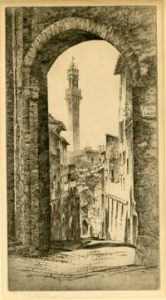
In a historical sense, the Grand Tour was a seventeenth- to eighteenth-century phenomenon in which the young, usually male and aristocratic, members of English and Northern European families visited great cities and societies of the European continent. It was an educational trip, meant largely for cultural exposure and refinement. Art was central to this travel in a number of ways, from visiting masterpieces of painting and architecture, to commissioning portraits, buying art to bring home, and engaging an artist for the journey who would paint the sublime beauty of each destination. This exhibition explores a time from approximately 1880 to 1960 when American artists endeavored to follow in the footsteps of this tradition and trek to Europe for a variety of reasons: study and opportunities to exhibit, illustration on commission, war, and leisure. At the center of their journeys was also the goal of education, for themselves through the process of travel and study and for others through the skills, cultural enlightenment, and artwork they would bring home. The works included in the exhibition represent a range of media, from printmaking to painting, and the work documents the architecture, scenery, and people of Italy, the Netherlands, Spain, Greece, England, and France as the artists saw them.
American Artists and the Legacy of the Grand Tour, 1880–1960 is organized by the Vanderbilt University Fine Arts Gallery and curated by Margaret F. M. Walker, assistant curator, with support provided by the Fine Arts Gallery Gift Fund and the Sullivan Art Collection Fund.
Share This Story
18th Century Grand Tour of Europe
The Travels of European Twenty-Somethings
Print Collector/Getty Images
- Key Figures & Milestones
- Physical Geography
- Political Geography
- Country Information
- Urban Geography
- M.A., Geography, California State University - Northridge
- B.A., Geography, University of California - Davis
The French Revolution marked the end of a spectacular period of travel and enlightenment for European youth, particularly from England. Young English elites of the seventeenth and eighteenth centuries often spent two to four years touring around Europe in an effort to broaden their horizons and learn about language , architecture , geography, and culture in an experience known as the Grand Tour.
The Grand Tour, which didn't come to an end until the close of the eighteenth century, began in the sixteenth century and gained popularity during the seventeenth century. Read to find out what started this event and what the typical Tour entailed.
Origins of the Grand Tour
Privileged young graduates of sixteenth-century Europe pioneered a trend wherein they traveled across the continent in search of art and cultural experiences upon their graduation. This practice, which grew to be wildly popular, became known as the Grand Tour, a term introduced by Richard Lassels in his 1670 book Voyage to Italy . Specialty guidebooks, tour guides, and other aspects of the tourist industry were developed during this time to meet the needs of wealthy 20-something male and female travelers and their tutors as they explored the European continent.
These young, classically-educated Tourists were affluent enough to fund multiple years abroad for themselves and they took full advantage of this. They carried letters of reference and introduction with them as they departed from southern England in order to communicate with and learn from people they met in other countries. Some Tourists sought to continue their education and broaden their horizons while abroad, some were just after fun and leisurely travels, but most desired a combination of both.
Navigating Europe
A typical journey through Europe was long and winding with many stops along the way. London was commonly used as a starting point and the Tour was usually kicked off with a difficult trip across the English Channel.
Crossing the English Channel
The most common route across the English Channel, La Manche, was made from Dover to Calais, France—this is now the path of the Channel Tunnel. A trip from Dover across the Channel to Calais and finally into Paris customarily took three days. After all, crossing the wide channel was and is not easy. Seventeenth- and eighteenth-century Tourists risked seasickness, illness, and even shipwreck on this first leg of travel.
Compulsory Stops
Grand Tourists were primarily interested in visiting cities that were considered major centers of culture at the time, so Paris, Rome, and Venice were not to be missed. Florence and Naples were also popular destinations but were regarded as more optional than the aforementioned cities.
The average Grand Tourist traveled from city to city, usually spending weeks in smaller cities and up to several months in the three major ones. Paris, France was the most popular stop of the Grand Tour for its cultural, architectural, and political influence. It was also popular because most young British elite already spoke French, a prominent language in classical literature and other studies, and travel through and to this city was relatively easy. For many English citizens, Paris was the most impressive place visited.
Getting to Italy
From Paris, many Tourists proceeded across the Alps or took a boat on the Mediterranean Sea to get to Italy, another essential stopping point. For those who made their way across the Alps, Turin was the first Italian city they'd come to and some remained here while others simply passed through on their way to Rome or Venice.
Rome was initially the southernmost point of travel. However, when excavations of Herculaneum (1738) and Pompeii (1748) began, these two sites were added as major destinations on the Grand Tour.
Features of the Grand Tour
The vast majority of Tourists took part in similar activities during their exploration with art at the center of it all. Once a Tourist arrived at a destination, they would seek housing and settle in for anywhere from weeks to months, even years. Though certainly not an overly trying experience for most, the Grand Tour presented a unique set of challenges for travelers to overcome.
While the original purpose of the Grand Tour was educational, a great deal of time was spent on much more frivolous pursuits. Among these were drinking, gambling, and intimate encounters—some Tourists regarded their travels as an opportunity to indulge in promiscuity with little consequence. Journals and sketches that were supposed to be completed during the Tour were left blank more often than not.
Visiting French and Italian royalty as well as British diplomats was a common recreation during the Tour. The young men and women that participated wanted to return home with stories to tell and meeting famous or otherwise influential people made for great stories.
The study and collection of art became almost a nonoptional engagement for Grand Tourists. Many returned home with bounties of paintings, antiques, and handmade items from various countries. Those that could afford to purchase lavish souvenirs did so in the extreme.
Arriving in Paris, one of the first destinations for most, a Tourist would usually rent an apartment for several weeks or months. Day trips from Paris to the French countryside or to Versailles (the home of the French monarchy) were common for less wealthy travelers that couldn't pay for longer outings.
The homes of envoys were often utilized as hotels and food pantries. This annoyed envoys but there wasn't much they could do about such inconveniences caused by their citizens. Nice apartments tended to be accessible only in major cities, with harsh and dirty inns the only options in smaller ones.
Trials and Challenges
A Tourist would not carry much money on their person during their expeditions due to the risk of highway robberies. Instead, letters of credit from reputable London banks were presented at major cities of the Grand Tour in order to make purchases. In this way, tourists spent a great deal of money abroad.
Because these expenditures were made outside of England and therefore did not bolster England's economy, some English politicians were very much against the institution of the Grand Tour and did not approve of this rite of passage. This played minimally into the average person's decision to travel.
Returning to England
Upon returning to England, tourists were meant to be ready to assume the responsibilities of an aristocrat. The Grand Tour was ultimately worthwhile as it has been credited with spurring dramatic developments in British architecture and culture, but many viewed it as a waste of time during this period because many Tourists did not come home more mature than when they had left.
The French Revolution in 1789 halted the Grand Tour—in the early nineteenth century, railroads forever changed the face of tourism and foreign travel.
- Burk, Kathleen. "The Grand Tour of Europe". Gresham College, 6 Apr. 2005.
- Knowles, Rachel. “The Grand Tour.” Regency History , 30 Apr. 2013.
- Sorabella, Jean. “The Grand Tour.” Heilbrunn Timeline of Art History , The Met Museum, Oct. 2003.
- A Beginner's Guide to the Enlightenment
- Architecture in France: A Guide For Travelers
- The History of Venice
- A Brief History of Rome
- A Beginner's Guide to the Renaissance
- The Best Books on Early Modern European History (1500 to 1700)
- Renaissance Architecture and Its Influence
- What Is a Monarchy?
- The Top 10 Major Cities in France
- William Turner, English Romantic Landscape Painter
- Architecture in Italy for the Lifelong Learner
- Female European Historical Figures: 1500 - 1945
- How Many Enslaved People Were Taken from Africa?
- Biography of Marco Polo, Merchant and Explorer
- Hispanic Surnames: Meanings, Origins and Naming Practices
- The Arrival and Spread of the Black Plague in Europe
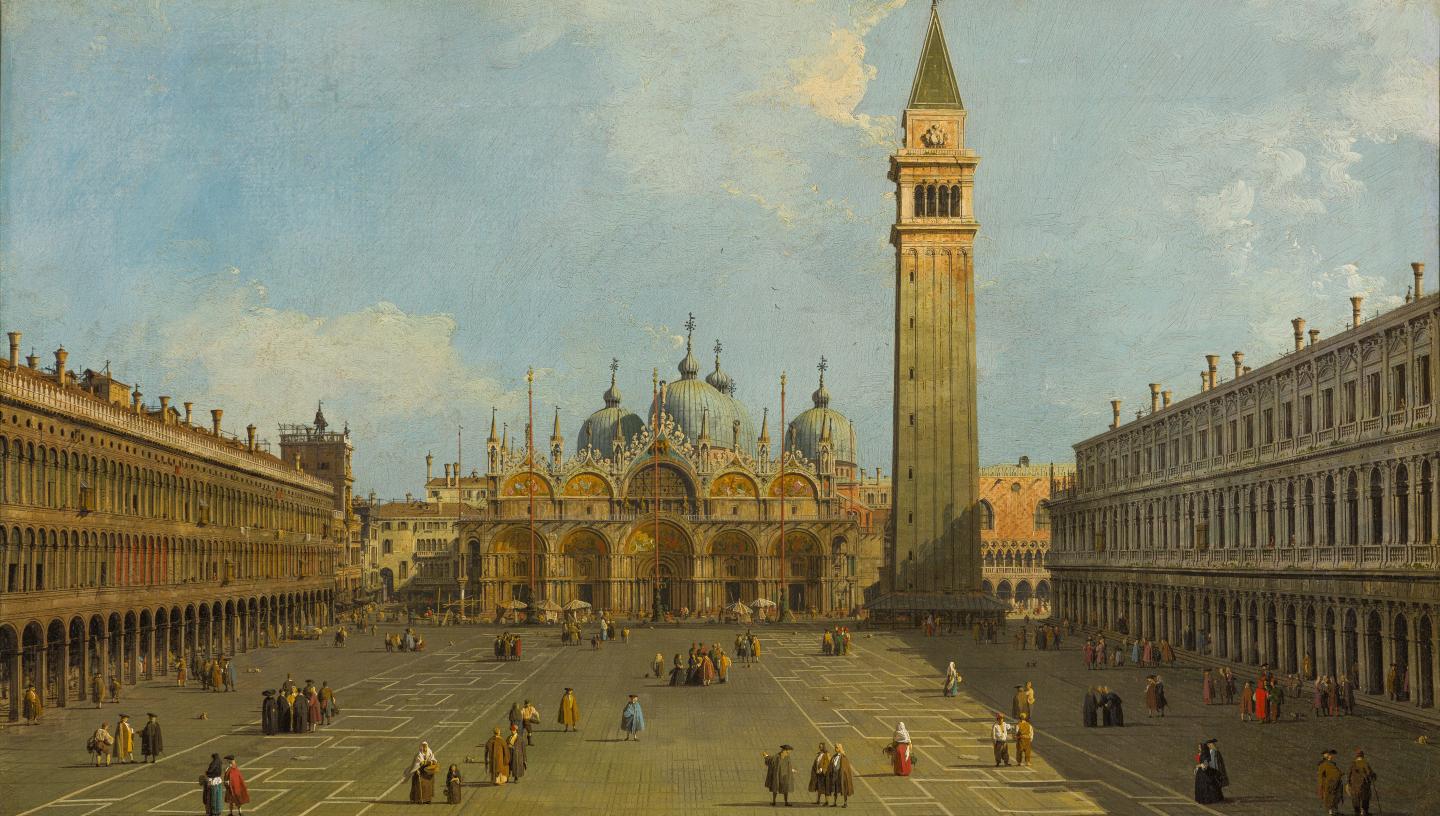
What was the Grand Tour?
Find out about the travel phenomenon that became popular amongst the young nobility of England
Art, antiquity and architecture: the Grand Tour provided an opportunity to discover the cultural wonders of Europe and beyond.
Popular throughout the 18th century, this extended journey was seen as a rite of passage for mainly young, aristocratic English men.
As well as marvelling at artistic masterpieces, Grand Tourists brought back souvenirs to commemorate and display their journeys at home.
One exceptional example forms the subject of a new exhibition at the National Maritime Museum. Canaletto’s Venice Revisited brings together 24 of Canaletto’s Venetian views, commissioned in 1731 by Lord John Russell following his visit to Venice.
Find out more about this travel phenomenon – and uncover its rich cultural legacy.
Canaletto's Venice Revisited
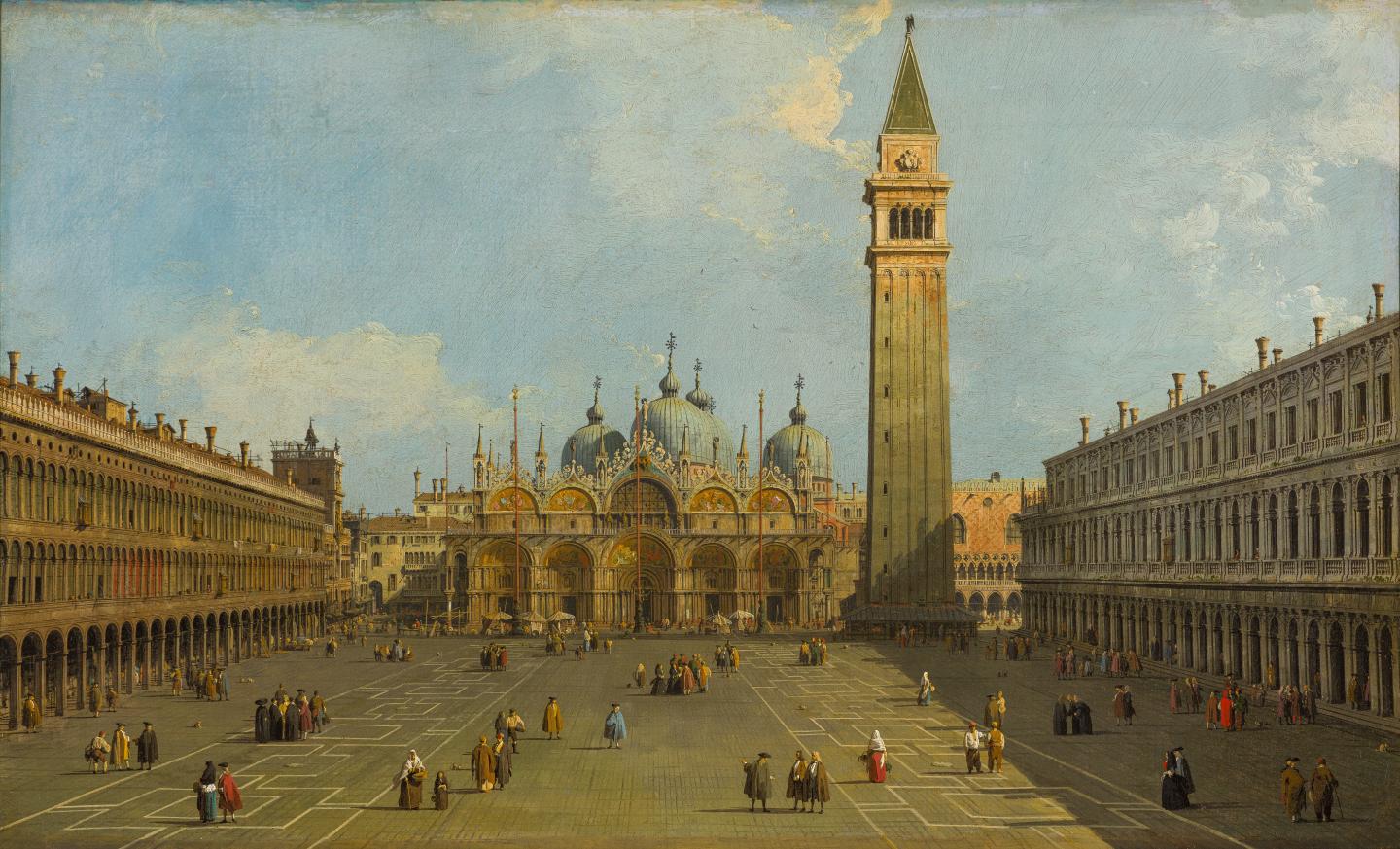
The origins of the Grand Tour
The development of the Grand Tour dates back to the 16th century.
One of the earliest Grand Tourists was the architect Inigo Jones , who embarked on a tour of Italy in 1613-14 with his patron Thomas Howard, 14th Earl of Arundel.
Jones visited cities such as Parma, Venice and Rome. However, it was Naples that proved the high point of his travels.
Jones was particularly fascinated by the San Paolo Maggiore, describing the church as “one of the best things that I have ever seen.”
Jones’s time in Italy shaped his architectural style. In 1616, Jones was commissioned to design the Queen’s House in Greenwich for Queen Anne of Denmark , the wife of King James I. Completed in around 1636, the house was the first classical building in England.
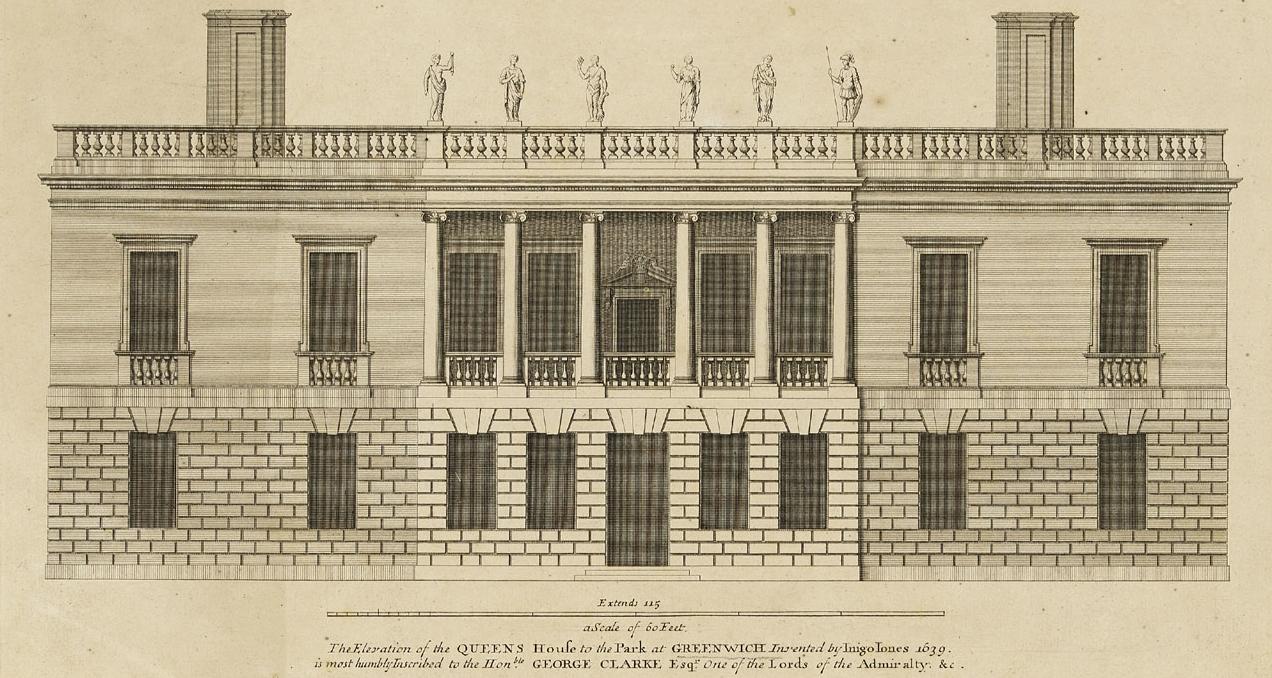
The expression ‘Grand Tour’ itself comes from 17th century travel writer and Roman Catholic priest Richard Lassels, who used it in his guidebook The Voyage of Italy, published in 1670.
By the 18th century, the Grand Tour had reached its zenith. Despite Anglo-French wars in 1689-97 and 1702-13, this was a time of relative stability in Europe, which made travelling across the continent easier.
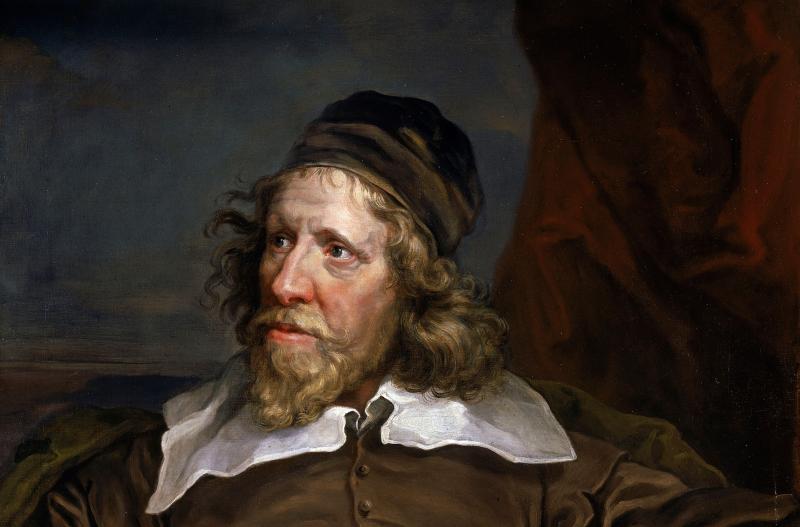
The Grand Tour route
For young English aristocrats, embarking on the Grand Tour was seen as an important rite of passage.
Accompanied by a tutor, a Grand Tourist’s route typically involved taking a ship across the English Channel before travelling in a carriage through France, stopping at Paris and other major cities.
Italy was also a popular destination thanks to the art and architecture of places such as Venice, Florence, Rome, Milan and Naples. More adventurous travellers ventured to Sicily or even sailed across to Greece. The average Grand Tour lasted for at least a year.
As Katherine Gazzard, Curator of Art at Royal Museums Greenwich explains, this extended journey marked the culmination of a Grand Tourist’s education.
“The Grand Tourists would have received an education that was grounded in the Classics,” she says. “During their travels to the continent, they would have seen classical ruins and read Latin and Greek texts. The Grand Tour was also an opportunity to take in more recent culture, such as Renaissance paintings, and see contemporary artists at work.”
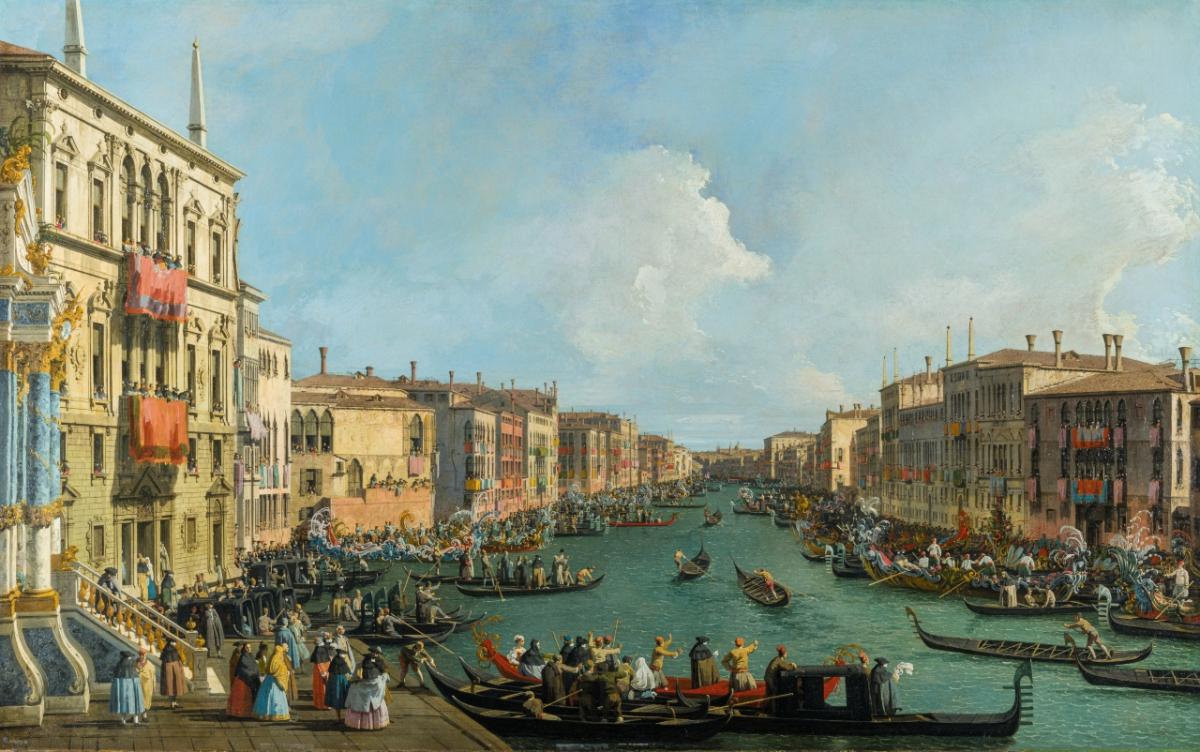
As well as educational opportunities, the Grand Tour was linked with independence. Places such as Venice were popular with pleasure seekers, boasting gambling houses and occasions for drinking and partying.
“On the Grand Tour, there’s a sense that travellers are gaining some of their independence and having a lesson in the ways of the world,” Gazzard explains. “For visitors to Venice, there were opportunities to behave beyond the social norms, with the masquerade and the carnival.”
Art and the Grand Tour
Bound up with the idea of independence was the need to collect souvenirs, which the Grand Tourists could display in their homes.
“The ownership of property was tied to status, so creating a material legacy was really important for the Grand Tourists in order to solidify their social standing amongst their peers,” says Gazzard. “They were looking to spend money and buy mementos to prove they went on the trip.”
The works of artists such as those of the 18th century view painter Giovanni Antonio Canal (known as Canaletto ) were especially popular with Grand Tourists. Prized for their detail, Canaletto’s artworks captured the landmarks and scenes of everyday Venetian life, from festive scenes to bustling traffic on the Grand Canal .
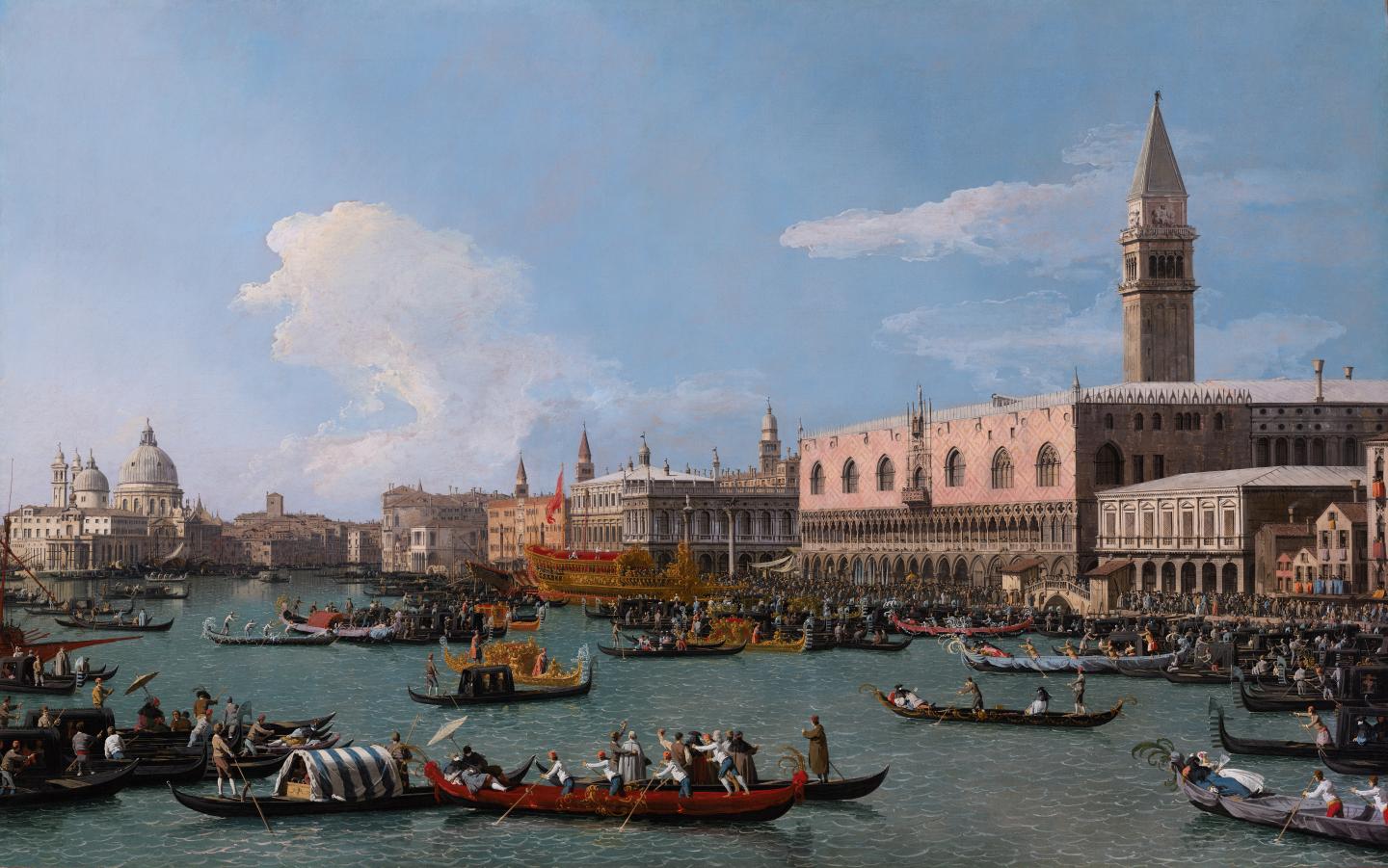
In 1731, Lord John Russell, the future 4th Duke of Bedford, commissioned Canaletto to create 24 Venetian views following his visit to the city.
Lord John Russell is known to have paid at least £188 for the set – over five times the annual earnings of a skilled tradesperson at the time.
“Canaletto’s work was portable and collectible,” says Gazzard. “He adopted a smaller size for his canvases so they could be rolled up and shipped easily.”
These detailed works, now part of the world famous collection at Woburn Abbey, form the centrepiece of Canaletto’s Venice Revisited at the National Maritime Museum .
Who was Canaletto?
The legacy of the Grand Tour
The start of the French Revolution in 1789 marked the end of the Grand Tour. However, its legacy is still keenly felt.
The desire to explore and learn about different places and cultures through travel continues to endure. The legacy of the Grand Tour can also be seen in the artworks and objects that adorn the walls of stately homes and museums, and the many cultural influences that travellers brought back to Britain.
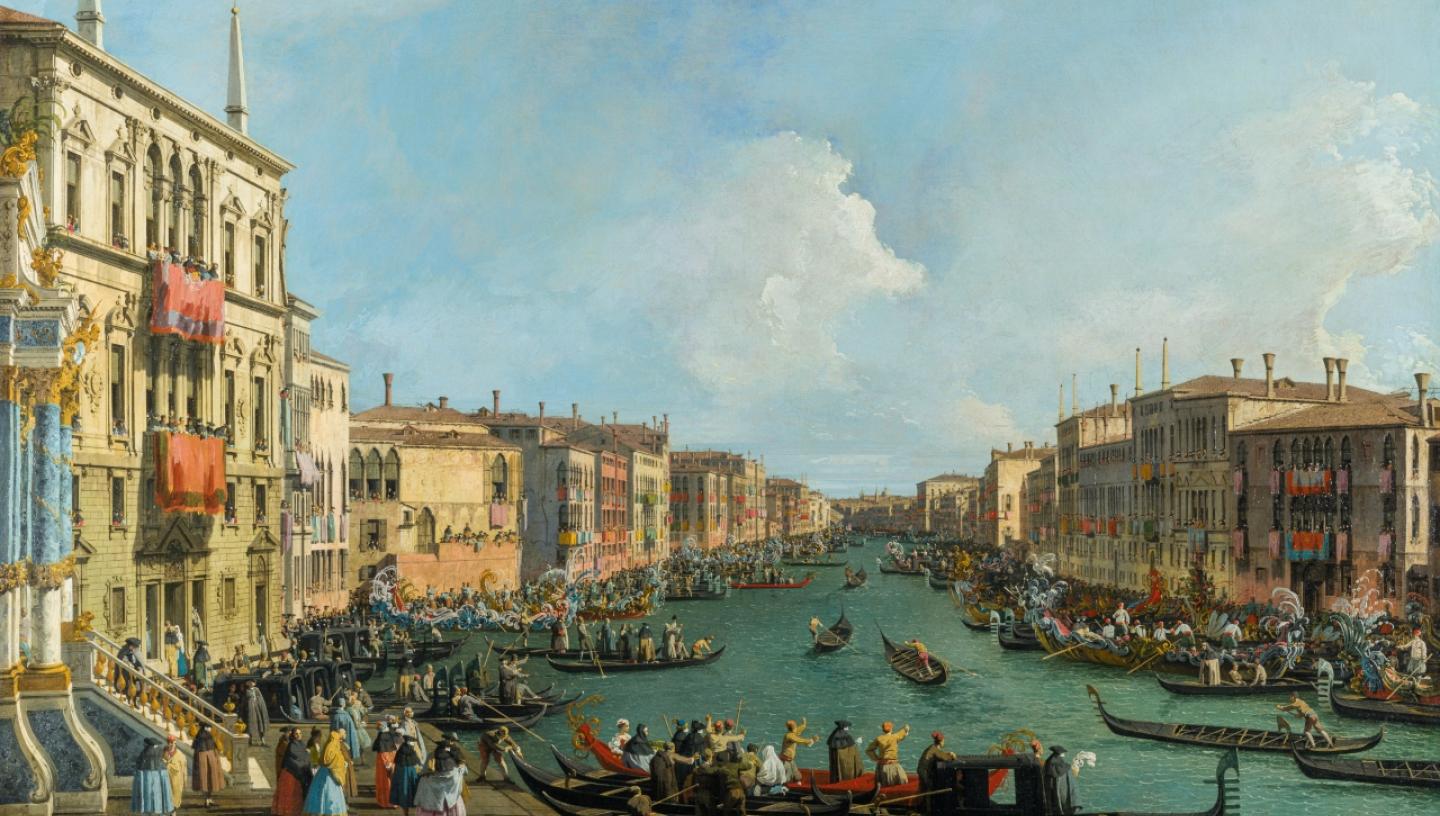
Canaletto's Venice Revisited

Main image: The Piazza San Marco looking towards the Basilica San Marco and the Campanile by Canaletto . From the Woburn Abbey Collection . Canaletto painting in body copy: Regatta on Grand Canal by Canaletto From the Woburn Abbey Collection
The Grand Tour
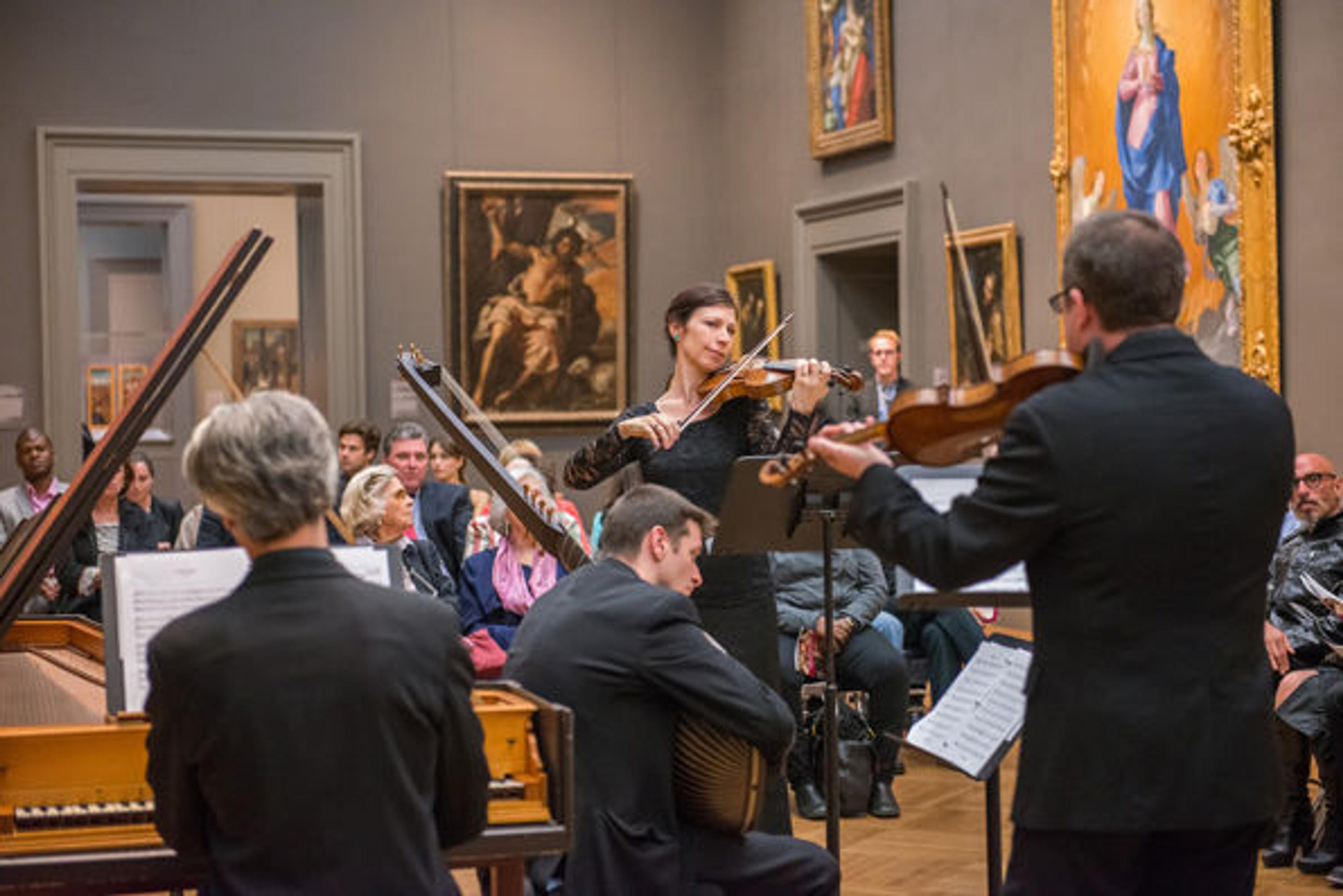
Opening Fanfare, The Grand Tour. Photograph by Stephanie Berger
«In celebration of the New European Paintings Galleries, 1250–1800 , the Museum hosted two special evenings of concerts on September 17 and 18. Music and art came together to illuminate the time period represented by the galleries, creating a resonant cultural experience.» The Grand Tour offered four distinct programs performed in the galleries by leading early music ensembles, with audiences seated right beside works of art. There were so many transcendent moments—and so many revelations. While enjoying the sights and sounds of sixteenth-century Venice or eighteenth-century France, audiences were also able to understand how this music was actually performed, appreciated, and observed in its time. Join us for future programs!
Details of the Program
Gallery 601—Baroque Painting in Italy Performers: Quicksilver (violins, harpsichord, theorbo, guitar)
Quicksilver in Gallery 601. Photograph by Stephanie Berger
In this gallery, the painting Marcantonio Pasqualini (1614–1691) Crowned by Apollo by Andrea Sacchi celebrates a famed male soprano who performed in operas, in the Sistine Choir, and in private solo performances.
Andrea Sacchi (Italian, ca. 1599–1661). Marcantonio Pasqualini (1614–1691) Crowned by Apollo , ca 1641. Oil on Canvas; 96 x 76 1/2 in. (243.8 x 194.3 cm). The Metropolitan Museum of Art, New York, Purchase, Enid A. Haupt Gift and Gwynne Andrews Fund, 1981 (1981.317)
The painting depicts Pasqualini as he is championed by Apollo, the god of music. Pasqualini is seen playing the upright harpsichord (Clavicytherium), and the bagpipes appear beside Marsyas, a reference to the musical battle between Apollo and Marsyas—a story resulting in the hierarchy of instruments (string above wind).
In the seventeenth century, stile moderno (explored in this Grand Tour program) utilized specific instruments for their sound or for their ability to provide the continuo part. The continuo part is the bass line of the score, played by one or more instruments simultaneously. Continuo parts were played by bowed bass (baroque cello, violin), or bassoon, or by instruments that can play chords (harpsichord, organ, lute, theorbo, and harp). Sonatas composed for multiple instruments were performed by smaller chamber groups and during church services.
Gallery 634—Dutch Paintings in the Altman Collection Performers: Dark Horse Consort (cornetto, sackbut)
Dark Horse Consort in Gallery 634. Photograph by Stephanie Berger
While the program of music selected for this setting honored the early Netherlandish composers of the 1500s, the works on view date to nearly a century later, the age of Rembrandt and Hals. The piety of the Netherlands during the seventeenth century put certain limits on musical expression, and any music heard in the Calvinist Republic would have been within a religious setting. Having been previously forbidden, organ music was slowly reintroduced beginning in the mid-1600s and reintegrated into services, and churches became the cornerstone of "concerts." The cornetto (a wooden pipe covered by leather) and sackbut (much like a trumpet, but featuring a telescoping slide so as to vary and control length, and a narrower bell) regularly accompanied choral music. These church concerts were thought to keep people out of the inns and taverns and curb scuffles and dissention. Ah, the power of music!
In many paintings of this time period, the instrument acts as a barometer of social standing. The upper class is represented alongside a string instrument like the lute, viola da gamba and virginal, while the lower classes are seen with wind instruments such as bagpipes.
Gallery 607—Venetian Sixteenth-Century Painting Performers: Tenet (soprano, alto, tenor, and baritone voices; theorbo)
Tenet in Gallery 607. Photograph by Stephanie Berger
In the early sixteenth century, solo voices accompanied by instruments become fashionable. Madrigals were often performed by gentlemen, as music was an important and distinctive discipline among the upper class and especially the educated man. These performances were a highlight of private banquets and informal gatherings hosted by the elite. Musical concerts were also a regular accompaniment to more elaborate parties. These events could include a full day of festivities with hunting and full-length comedies containing musical interludes.
Entering the 1600s, the theorbo gained popularity, and it became more in style for a singer to be accompanied by the theorbo or guitar (rather than the lute). Instruments like the lute and theorbo often serve as a symbol of love, and it is no wonder—the instruments seem to instantly create a gentle intimacy—although, the theorbo does give off a deeper, bass volume.
Titian and Workshop (Italian, ca. 1485/90?–1576). Venus and the Lute Player , ca. 1565–70. The Metropolitan Museum of Art, New York, Munsey Fund, 1936 (36.29)
This gallery has some of the most striking representations of love, art, and music. Here, the convergence of romance and attraction in art usually manifests itself in the form of the goddess Venus, a favorite subject of Titian. When truly observing his paintings we see a whole love story unfold, one in which there is a thread linking the beauty of music (sound) to physical beauty (sight). Many art historians have theorized that these paintings are a statement on perceiving beauty, while others consider that an overly philosophical analysis and say the paintings are purely decorative, even a bit suggestive. The answer may be a little of both. In Titian's paintings and depictions of Venus alone we see her as both a paragon of love, possessing a mature reserve, and in other instances a figure of sexuality and provocativeness.
Gallery 615—History, Portraits, and Genre in Eighteenth-Century France Perfomer: Jory Vinikour (harpsichord)
Jory Vinikour in Gallery 615. Photograph by Stephanie Berger
A harpsichordist held a prominent place in the opulent French courts of the late seventeenth and eighteenth century. A court harpsichordist or music director composed music for the king's entertainment and daily church masses. During the reign of King Louis XIV (1643–1715), a work was often performed each morning in the Royal Chapel.
Outside of the court, and especially in the declining years of King Louis XIV, the theaters were bustling with wit. Lightheartedness prevailed on the stage. The courtiers ran off to urban Paris at night to delight in theater, opera, and ballet, slinking back to Versailles in the early morning hours. These public theaters were one of the only places where different social classes could mix and mingle, as ticket prices were the only barrier to entry and keeper of the social structure. Audiences developed an increasing taste for opera-ballets at theaters like the Royal Academy of Music in the 1700s. They craved slim plots, elegant scenery and costuming, and themes of absolute pleasure rather than staunch heroes.
Comedic theater found its way into seasonal fairs, and what began as a lower class form of diversion soon attracted the upper classes. Theater at these fairs traditionally sampled well-known opera tunes (think vaudevilles), but later became more sophisticated as it cultivated a courtier clientele. This is mainly due to a relaxation on the monopolies of the opera houses of the time. However, fairs remained the stomping grounds of comedic favorites such as Pierrot, Harlequin, and Puchinello.
After the death of King Louis XIV, public balls were inaugurated at the opera. At these extravagant events there was a sense of social leveling as guests were asked to arrive masked. The price of a ticket was the same for everyone and the costume mask became a great equalizer in the world of entertainment.
Related Links Concerts and Performances New European Paintings Galleries
Further Reading
Katharine Baetjer, ed. Watteau, Music, and Theater (The Metropolitan Museum of Art, New York, 2009). Andrea Bayer, ed. Art and Love in the Age of Renaissance Italy (The Metropolitan Museum of Art, New York, 2008). Edwin Buijsen, ed. The Hoogsteder Exhibition of: Music & Painting in the Golden Age (Hague: Hoogsteder & Hoogsteder; Zwolle: Waanders, 1994) Keith Christiansen, A Caravaggio Rediscovered: The Lute Player (The Metropolitan Museum of Art, New York, 1990)
Meryl Cates
Meryl Cates is a senior publicist in the Communications Department.

Sign Up Today
Start your 14 day free trial today
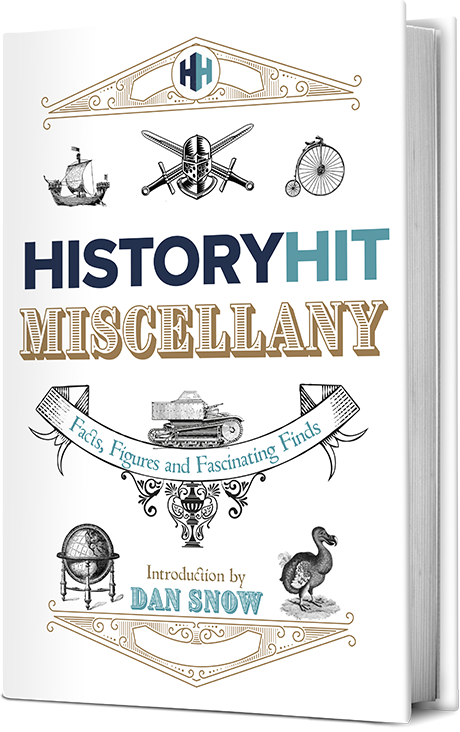
The History Hit Miscellany of Facts, Figures and Fascinating Finds
What Was the Grand Tour of Europe?

Lucy Davidson
26 jan 2022, @lucejuiceluce.
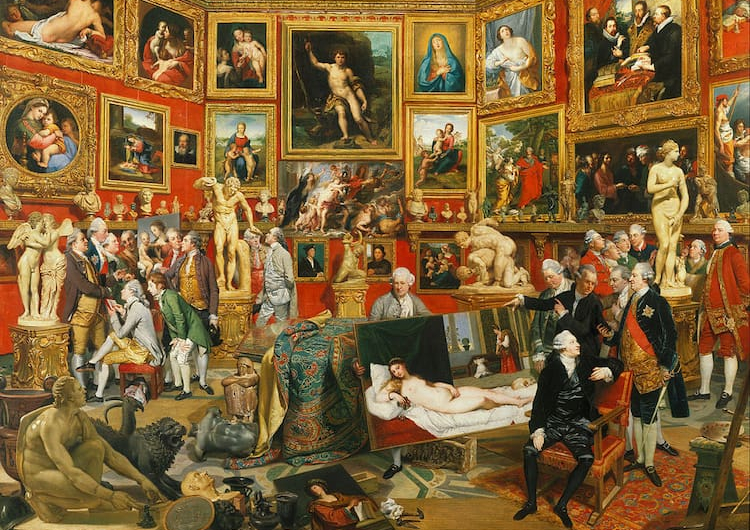
In the 18th century, a ‘Grand Tour’ became a rite of passage for wealthy young men. Essentially an elaborate form of finishing school, the tradition saw aristocrats travel across Europe to take in Greek and Roman history, language and literature, art, architecture and antiquity, while a paid ‘cicerone’ acted as both a chaperone and teacher.
Grand Tours were particularly popular amongst the British from 1764-1796, owing to the swathes of travellers and painters who flocked to Europe, the large number of export licenses granted to the British from Rome and a general period of peace and prosperity in Europe.
However, this wasn’t forever: Grand Tours waned in popularity from the 1870s with the advent of accessible rail and steamship travel and the popularity of Thomas Cook’s affordable ‘Cook’s Tour’, which made mass tourism possible and traditional Grand Tours less fashionable.
Here’s the history of the Grand Tour of Europe.
Who went on the Grand Tour?
In his 1670 guidebook The Voyage of Italy , Catholic priest and travel writer Richard Lassells coined the term ‘Grand Tour’ to describe young lords travelling abroad to learn about art, culture and history. The primary demographic of Grand Tour travellers changed little over the years, though primarily upper-class men of sufficient means and rank embarked upon the journey when they had ‘come of age’ at around 21.
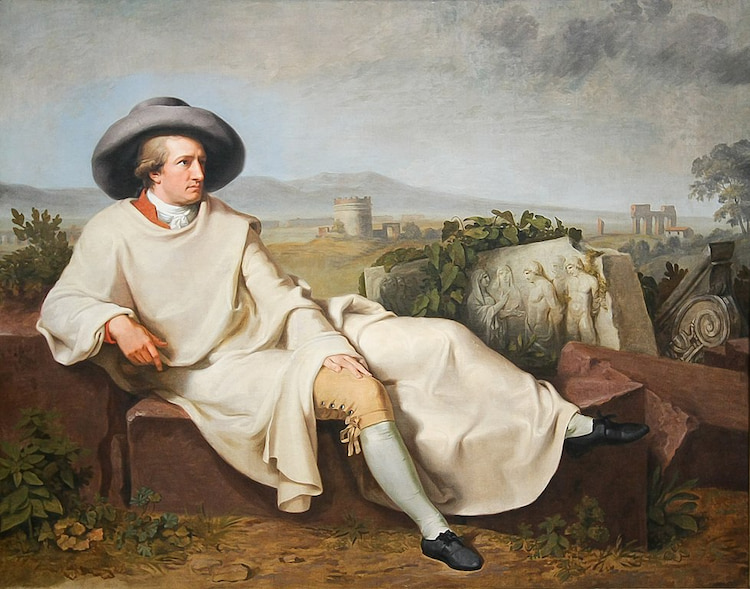
‘Goethe in the Roman Campagna’ by Johann Heinrich Wilhelm Tischbein. Rome 1787.
Image Credit: Wikimedia Commons
In the late 18th and early 19th centuries, Grand Tours also became fashionable for women who might be accompanied by a spinster aunt as a chaperone. Novels such as E. M. Forster’s A Room With a View reflected the role of the Grand Tour as an important part of a woman’s education and entrance into elite society.
Increasing wealth, stability and political importance led to a more broad church of characters undertaking the journey. Prolonged trips were also taken by artists, designers, collectors, art trade agents and large numbers of the educated public.
What was the route?
The Grand Tour could last anything from several months to many years, depending on an individual’s interests and finances, and tended to shift across generations. The average British tourist would start in Dover before crossing the English Channel to Ostend in Belgium or Le Havre and Calais in France. From there the traveller (and if wealthy enough, group of servants) would hire a French-speaking guide before renting or acquiring a coach that could be both sold on or disassembled. Alternatively, they would take the riverboat as far as the Alps or up the Seine to Paris .
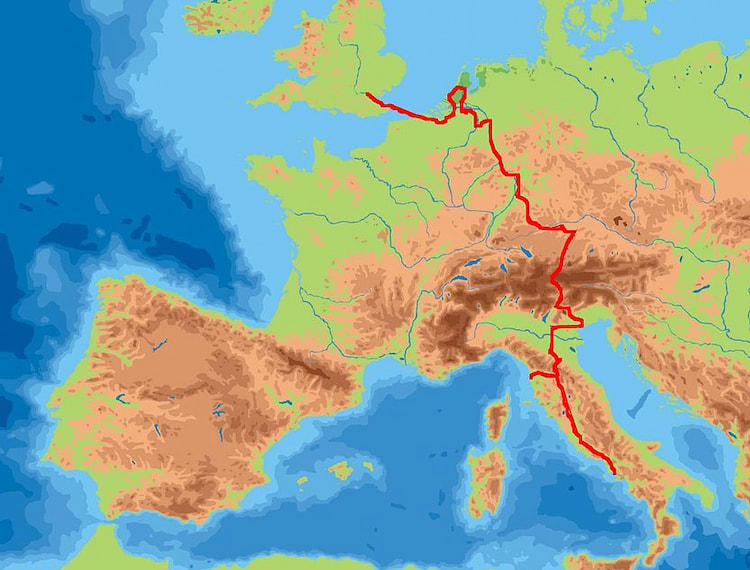
Map of grand tour taken by William Thomas Beckford in 1780.
From Paris, travellers would normally cross the Alps – the particularly wealthy would be carried in a chair – with the aim of reaching festivals such as the Carnival in Venice or Holy Week in Rome. From there, Lucca, Florence, Siena and Rome or Naples were popular, as were Venice, Verona, Mantua, Bologna, Modena, Parma, Milan, Turin and Mont Cenis.
What did people do on the Grand Tour?
A Grand Tour was both an educational trip and an indulgent holiday. The primary attraction of the tour lay in its exposure of the cultural legacy of classical antiquity and the Renaissance, such as the excavations at Herculaneum and Pompeii, as well as the chance to enter fashionable and aristocratic European society.
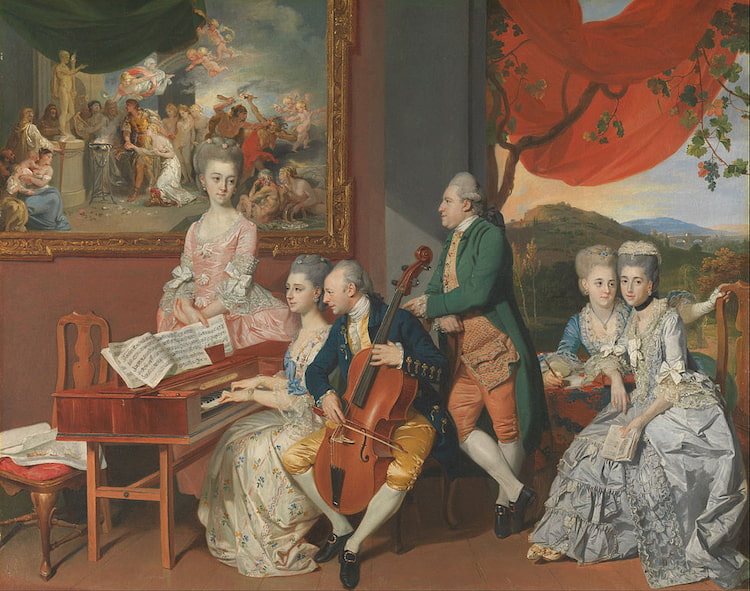
Johann Zoffany: The Gore Family with George, third Earl Cowper, c. 1775.
In addition, many accounts wrote of the sexual freedom that came with being on the continent and away from society at home. Travel abroad also provided the only opportunity to view certain works of art and potentially the only chance to hear certain music.
The antiques market also thrived as lots of Britons, in particular, took priceless antiquities from abroad back with them, or commissioned copies to be made. One of the most famous of these collectors was the 2nd Earl of Petworth, who gathered or commissioned some 200 paintings and 70 statues and busts – mainly copies of Greek originals or Greco-Roman pieces – between 1750 and 1760.
It was also fashionable to have your portrait painted towards the end of the trip. Pompeo Batoni painted over 175 portraits of travellers in Rome during the 18th century.
Others would also undertake formal study in universities, or write detailed diaries or accounts of their experiences. One of the most famous of these accounts is that of US author and humourist Mark Twain, whose satirical account of his Grand Tour in Innocents Abroad became both his best selling work in his own lifetime and one of the best-selling travel books of the age.
Why did the popularity of the Grand Tour decline?
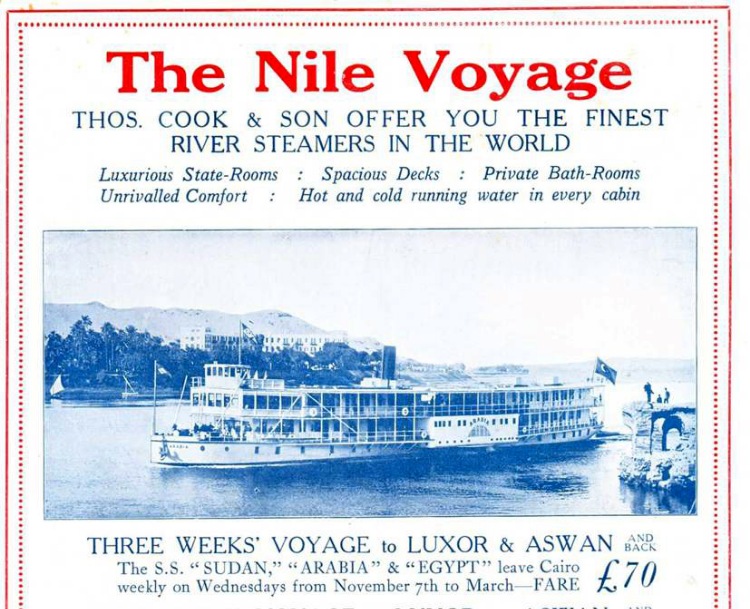
A Thomas Cook flyer from 1922 advertising cruises down the Nile. This mode of tourism has been immortalised in works such as Death on the Nile by Agatha Christie.
The popularity of the Grand Tour declined for a number of reasons. The Napoleonic Wars from 1803-1815 marked the end of the heyday of the Grand Tour, since the conflict made travel difficult at best and dangerous at worst.
The Grand Tour finally came to an end with the advent of accessible rail and steamship travel as a result of Thomas Cook’s ‘Cook’s Tour’, a byword of early mass tourism, which started in the 1870s. Cook first made mass tourism popular in Italy, with his train tickets allowing travel over a number of days and destinations. He also introduced travel-specific currencies and coupons which could be exchanged at hotels, banks and ticket agencies which made travelling easier and also stabilised the new Italian currency, the lira.
As a result of the sudden potential for mass tourism, the Grand Tour’s heyday as a rare experience reserved for the wealthy came to a close.
Can you go on a Grand Tour today?
Echoes of the Grand Tour exist today in a variety of forms. For a budget, multi-destination travel experience, interrailing is your best bet; much like Thomas Cook’s early train tickets, travel is permitted along many routes and tickets are valid for a certain number of days or stops.
For a more upmarket experience, cruising is a popular choice, transporting tourists to a number of different destinations where you can disembark to enjoy the local culture and cuisine.
Though the days of wealthy nobles enjoying exclusive travel around continental Europe and dancing with European royalty might be over, the cultural and artistic imprint of a bygone Grand Tour era is very much alive.
To plan your own Grand Tour of Europe, take a look at History Hit’s guides to the most unmissable heritage sites in Paris , Austria and, of course, Italy .
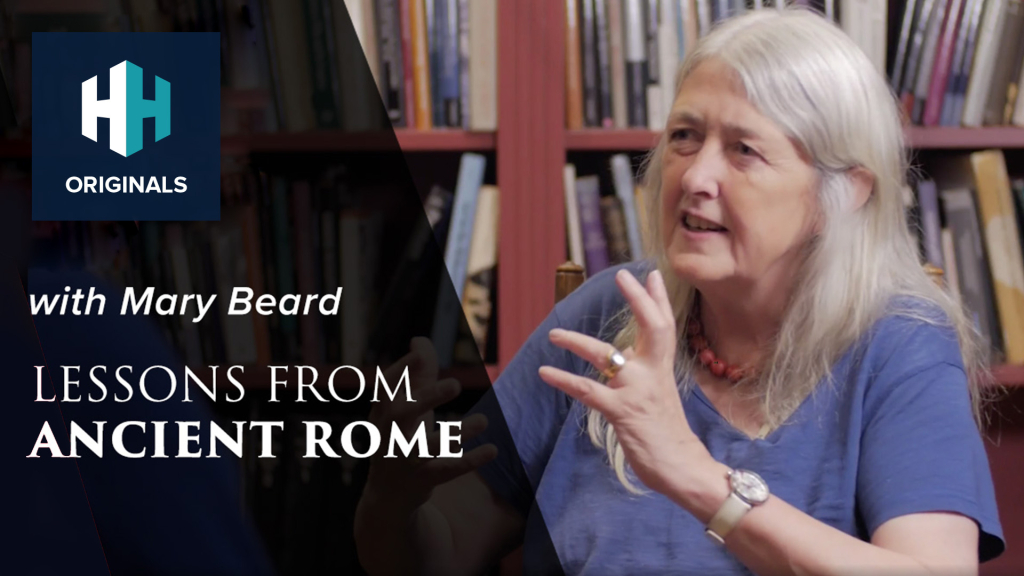
You May Also Like
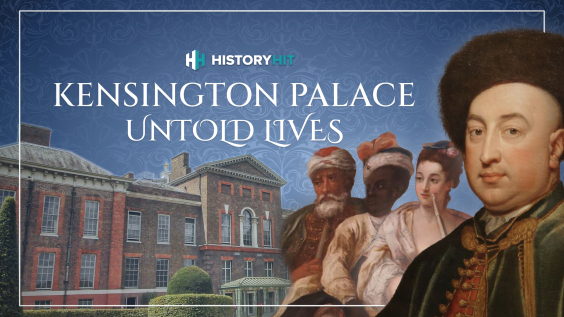
Mac and Cheese in 1736? The Stories of Kensington Palace’s Servants
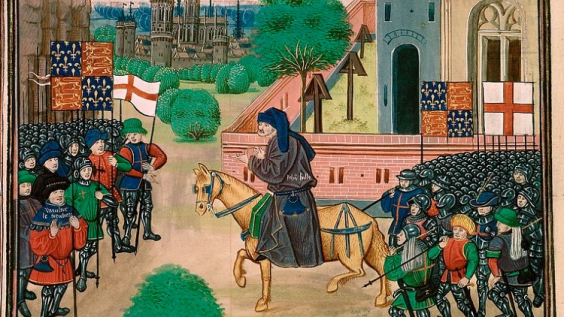
The Peasants’ Revolt: Rise of the Rebels
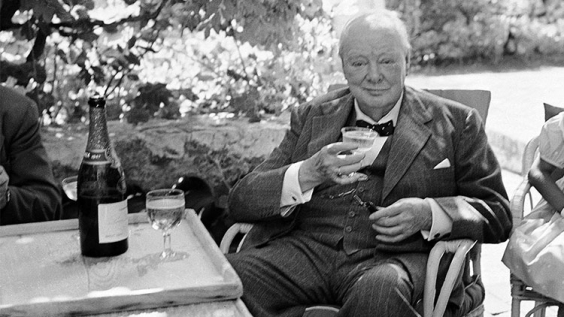
10 Myths About Winston Churchill
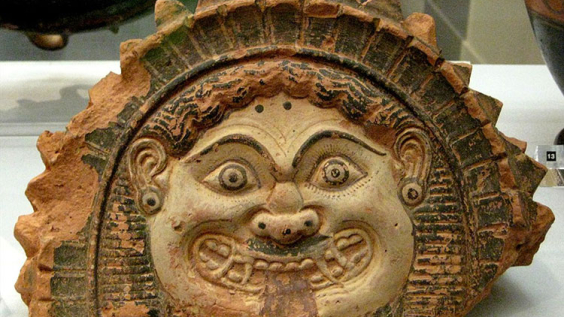
Medusa: What Was a Gorgon?
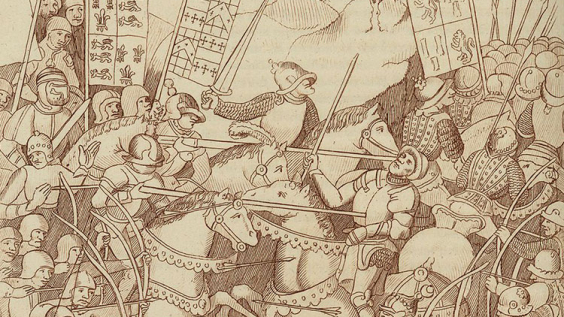
10 Facts About the Battle of Shrewsbury
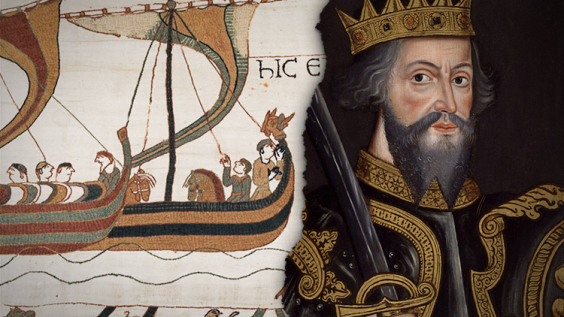
5 of Our Top Podcasts About the Norman Conquest of 1066
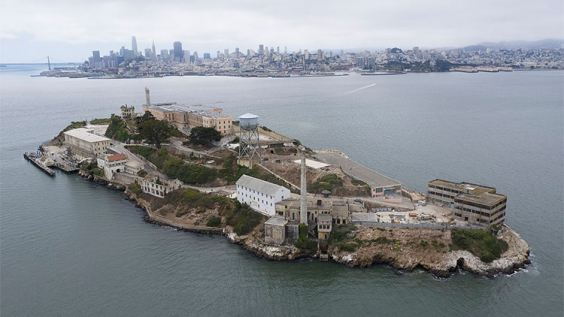
How Did 3 People Seemingly Escape From Alcatraz?
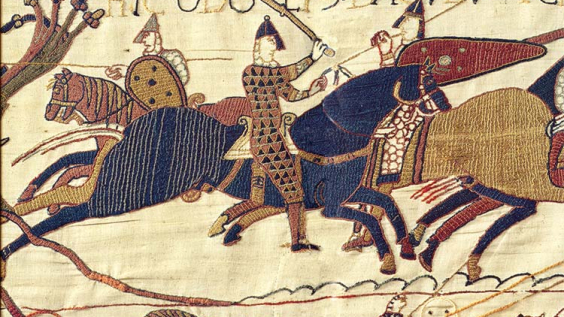
5 of Our Top Documentaries About the Norman Conquest of 1066
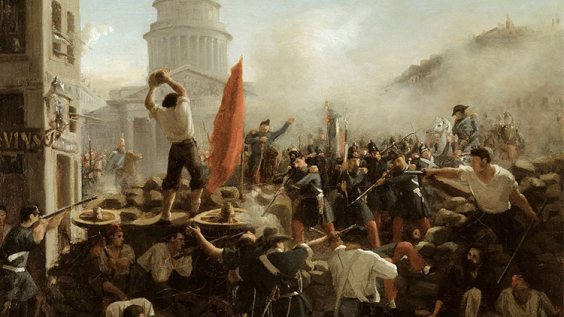
1848: The Year of Revolutions
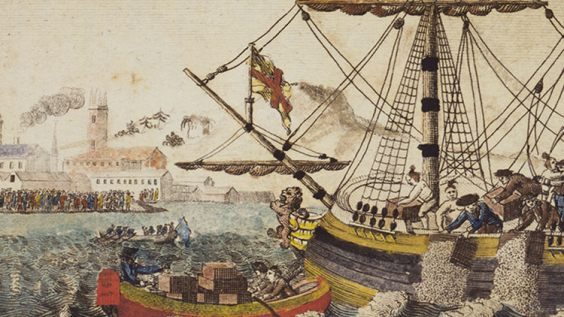
What Prompted the Boston Tea Party?

15 Quotes by Nelson Mandela
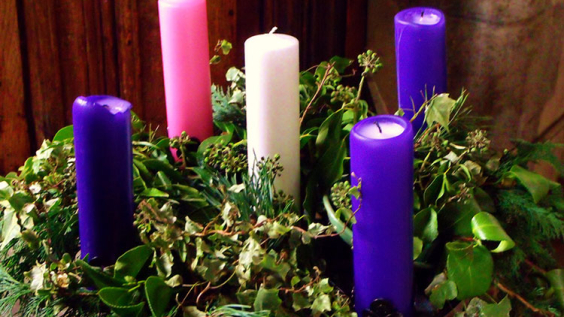
The History of Advent
The story of the trip to the Valley of the Temples
Valley of the temples.
Grand Tour Valley of the Temples
Following the emotional wave provoked by the first sensational discoveries at Pompeii and Herculaneum in the mid-eighteenth century, a growing number of travellers from Europe came to Italy to admire the vestiges of the past. Thanks to the sensitivity of the Bourbon kings, the cities buried by the eruption of Vesuvius in 79 AD were brought back to the light, along with their beautiful paintings, images of a world that was believed to have disappeared forever. The Grand Tour, the journey to discover ancient Italian sites, was a real cultural movement, which developed alongside the emergence of neoclassicism in literature and art. Antiquity dictated tastes and became an inescapable model of beauty and harmony. The offspring of the noble European families used this trip to complete their education, sometimes dangerous and exhausting, which could last for years. Certainly an experience full of emotion, in the name of learning and knowledge on the one hand, and in the name of escapism and delight on the other. Sicily was one of the preferred destinations, drawing visitors with the irresistible charm of its ruins. Sicilian monumental heritage also offered the unique opportunity to encounter Greek civilisation without having to face a dangerous trip to Greece, then under Turkish rule. Many travellers filled notebooks with their experiences of contact with antiquity, and sometimes accompanied their impressions with illustrations. Art students, engravers and painters offer valuable evidence through their 'ancient visions' of Italian artistic sites.
R. De Saint Non, Voyage pittoresque ou description des Royame de Naples et de Sicile vol.IV, Paris 1785. View of the Agrigento countryside.
R. De Saint Non, Voyage pittoresque ou description des Royame de Naples et de Sicile vol.IV, Paris 1785. Temple of Juno
G.M. Pancrazi, Antiquities of Sicily, Naples 1751-1752. Temple of Juno
R. De Saint Non, Voyage pittoresque ou description des Royame de Naples et de Sicile vol.IV, Paris 1785. Temple of Asclepius
Pancrazi, Giuseppe Maria. Antiquities of Sicily, Naples 1751-1752. Hypogea
R. De Saint Non, Voyage pittoresque ou description des Royame de Naples et de Sicile vol.IV, Paris 1785. Temple of Castor and Pollux
J.P.J.L. Houel, Voyage pittoresque des isles de Sicile, Malte et de Lipari, Paris 1784 Temple of Olympian Zeus
The Grand Tour in Agrigento
On the Sicilian journey, a stop in Agrigento, at the time still called Girgenti, was a must, earning enthusiastic praise from visitors, who dedicated wonderful paintings to Agrigentine monuments. In particular, the Olympieion with its telamons aroused great curiosity among the travellers, impressed by the size of the ruins of one of the largest temples. Among the images dedicated to Akragas those illustrating the work by the Parisian abbot Richard de Saint Non (1785), and those of the Voyage pittoresque (1787) by Jean Pierre Louis Laurent Houel, painter to the King of France, are particularly striking. The ruined temples are depicted in a lush landscape, often populated by shepherds with their goats. The monuments of ancient Akragas are portrayed with clear and decisive strokes by the engraver Salvatore Ettore, who illustrated the volumes of the Theatine Giuseppe Maria Pancratii in 1751.
R. De Saint Non, Voyage pittoresque ou description des Royame de Naples et de Sicile vol.IV, Paris 1785. Temple of the Giants of Agrigento
J.P.J.L. Houel, Voyage pittoresque des isles de Sicile, Malte et de Lipari, Paris 1784. The Oratory of Phalaris
G.M. Pancrazi, Antiquities of Sicily, Naples 1751-1752. Temple of Ceres
J.P.J.L. Houel, Voyage pittoresque des isles de Sicile, Malte et de Lipari, Paris 1784. Temple of Castor and Pollux
J.P.J.L. Houel, Voyage pittoresque des isles de Sicile, Malte et de Lipari, Paris 1784
Andrea Pigonati, Present State of Ancient Sicilian Monuments, Naples 1767. Tomb of Theron.
In his Italian Journey (1817), the German poet recounts his sentimental journey made between 1786 and 1788, and describes his intellectual rebirth in contact with history. He enthused about the valley in the spring dawn light: I've never seen in my entire life such a splendour of spring as this morning at sunrise... From the window we see the vast and gentle slope around the ancient city of gardens and vineyards; under the thick green a few traces of the great and populous districts of the long ago city can be glimpsed. Only at the southern end of this verdant and flowery slope rises the Temple of Concordia, in the east the few remains of the Temple of Juno; but from above the eye does not see the ruins of temples... instead it runs south towards the sea.
R. De Saint Non, Voyage pittoresque ou description des Royame de Naples et de Sicile vol.IV, Paris 1785. Temple of Concordia
J.P.J.L. Houel, Voyage pittoresque des isles de Sicile, Malte et de Lipari, Paris 1784. Temple of Asclepius
J.P.J.L. Houel, Voyage pittoresque des isles de Sicile, Malte et de Lipari, Paris 1784. Burial caves of the ancient city of Agrigento
R. De Saint Non, Voyage pittoresque ou description des Royame de Naples et de Sicile vol.IV, Paris 1785. Temple of Hercules
G.M. Pancrazi, Antiquities of Sicily, Naples 1751-1752. Aqueducts
G.M. Pancrazi, Antiquities of Sicily, Naples 1751-1752. The city from the east side
G.M. Pancrazi, Antiquities of Sicily, Naples 1751-1752
J.P.J.L. Houel, Voyage pittoresque des isles de Sicile, Malte et de Lipari, Paris 1784 Plan of ancient Akragas
The exhibition was curated by Giusi Messina. General Coordination: Giuseppe Parello, Director of Archaeological Park and Landscape of the Valley of the Temples. Texts: Maria Serena Rizzo and Valentina Caminneci Photos: Emanuele Simonaro, Fabio Florio, Angelo Pitrone.
Valley of the Temples - Agrigento
Gods and cults, great doric temples, temple of zeus, sport in akragas, living in agrigentum, early christian agrigento, the cultural landscape, living museum of the almond tree, the kolymbetra garden.
The Grand Tour: Everything You Need to Know
Gokce Dyson 28 November 2022 min Read
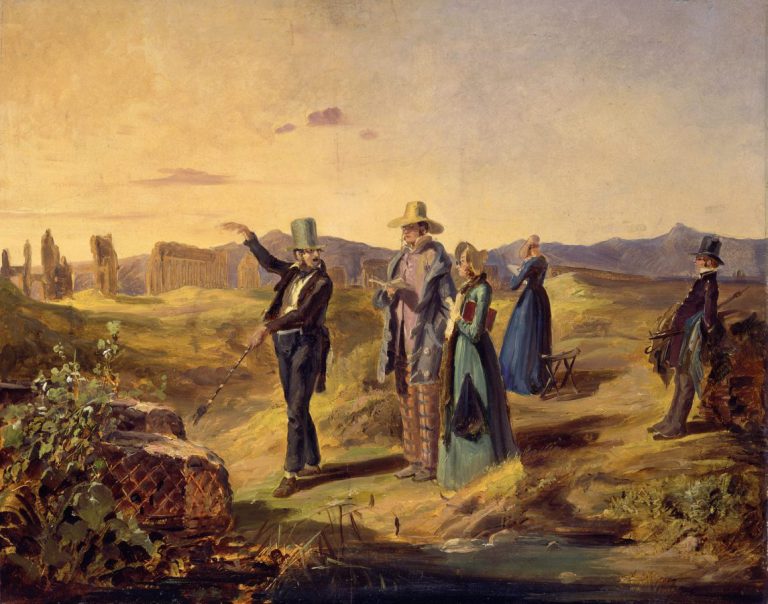
Carl Spitzweg, Englishmen in Campania , ca. 1835, Alte Nationalgalerie, Berlin, Germany.
Recommended
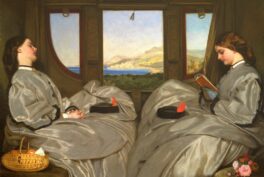
Art Travels
On the Road: Best Traveling Paintings
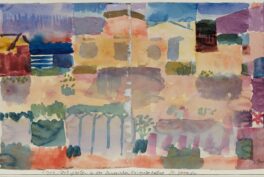
Artists’ Beloved Travel Destinations as Seen Through Their Art
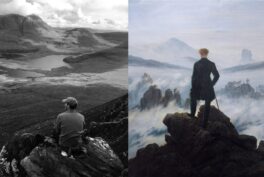
How to Do a 21st-Century Grand Tour According to Mr. Bacchus
Nowadays, it is very common to take a gap year before or after university studies to travel and expand your horizons. Dedicating a year or two before committing to a full-time job means you can experience different cultures, learn languages, and enjoy having a bit of fun before settling down. Back in the day, with similar objectives, many noblemen embarked on a journey across Europe before entering adulthood. It was called the Grand Tour.
The Grand Tour evolved between the 17th and 18th centuries as a custom of a traditional trip. The purpose of the Grand Tour was to provide male members of upper-class families with a formative experience. The term was first used by the Catholic priest and travel writer Richard Lassels in his guidebook The Voyage of Italy . The book came out in 1670 and described young lords traveling to Italy to see art, architecture, and antiquity. Lassels completed the Grand Tour five times during his lifetime.
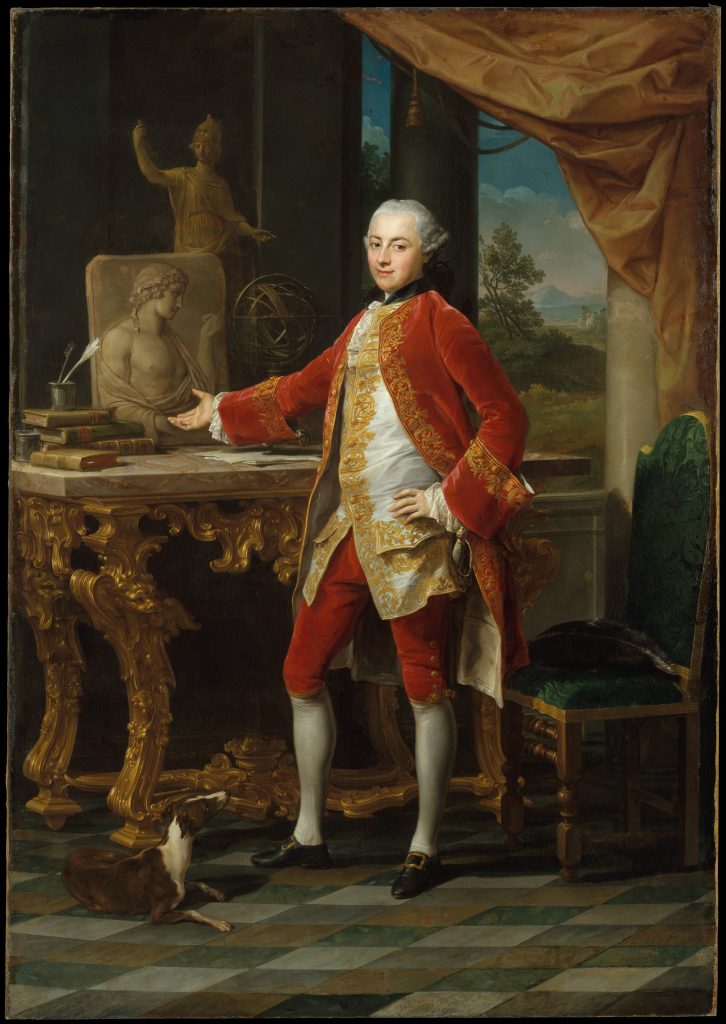
In England, for example, the general view held by the aristocrats was that foreign travel completed the education of an English gentleman. However, some people were also quite skeptical about the tour. They feared the amount of money spent to make the Grand Tour possible could ruin the young nobility.
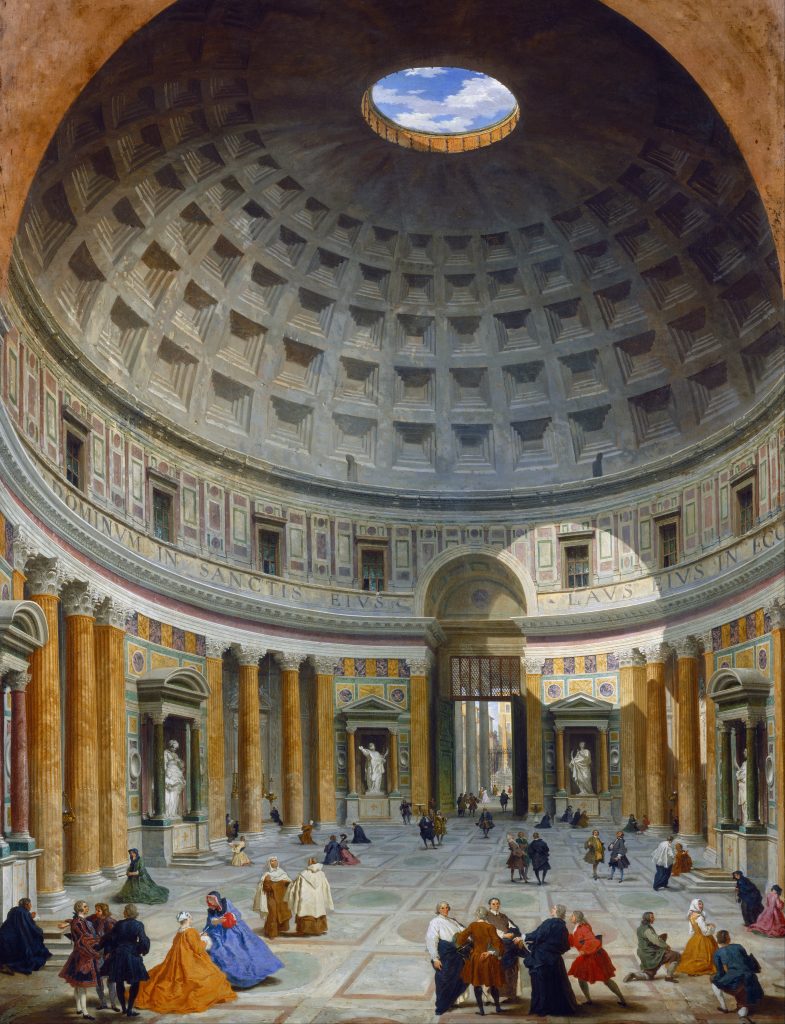
Although the Grand Tour was largely associated with English travelers, they were far from being the only ones on the road. On the contrary, wealthy families in France, Germany, Netherlands, Sweden, and Denmark also saw traveling as an ideal way to finish the education of their societies’ future leaders.
Itinerary of the Grand Tour
The traditional route of the Grand Tour usually began in Dover, England. Grand tourists would cross the English Channel to Le Havre in France. Upon arrival in Paris , the young men tended to hire a French-speaking guide as French was the dominant language of the elite during the 17th and 18th centuries. In Paris, they spent some time taking lessons in fencing, riding, and perhaps dancing. There, they became accustomed to the sophisticated manners of French society in courtly behavior and fashion. Paris was a crucial step in preparing for their positions to be fulfilled in government or diplomacy waiting back in England.

From there, tourists would buy transport, and if they were prosperous enough, they would hire a tutor to accompany them. The travelers would then get back on the road and cross the Alps, carried in a chair at Mont Cenis before moving on to Turin.
Italy was exceedingly the most traveled country on the Grand Tour. A Grand tourist’s list of must-see cities in Italy included Florence , Venice , and Naples . And then, there was Rome . Each Italian city offered immense importance in experiencing art and architecture, and Rome had it all.
Touring Italy
Once arriving in Italy, noblemen traveled to Florence followed by Venice, Rome, and Naples. Florence was popular for its Renaissance art, magnificent country villas, and beautiful gardens. Young aristocrats were able to gain entry to private collections where they could observe the legacy of the Medici family. Venice , on the other hand, was the party city. There was, however, a second reason to visit Venice. During their travels, grand tourists often commissioned art to take back home with them. Wealthy ones brought sketch artists along with them. Others purchased ready-made artworks instead. Giovanni Battista Piranesi created numerous prints and sketches depicting the ancient ruins in Rome. The works of the Venetian artist were popular among noblemen.
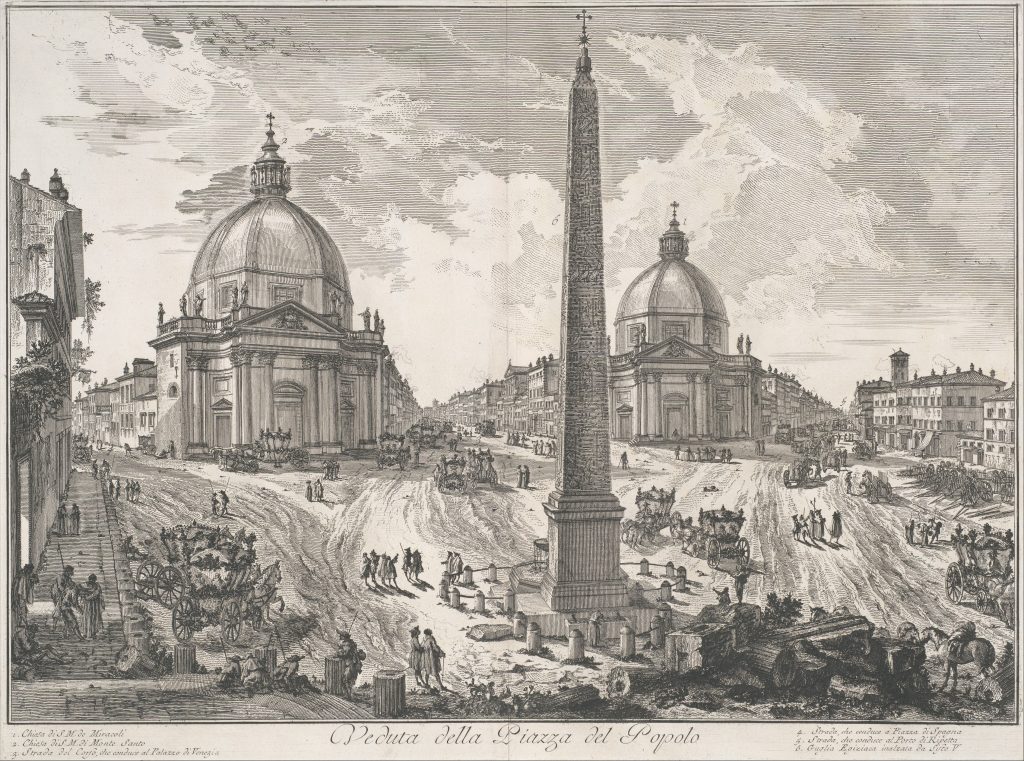
Rome was considered the ultimate stop during the Grand Tour. The city had a harmonious mixture of past and present. One could experience modern-day Baroque art and architecture and ancient ruins , dating back thousands of years at the same time. It was lauded as home to Michelangelo’s and Bernini’s most prized works. Gentlemen visited spots like the Pantheon, the Colosseum, and Porta del Popolo. William Beckford described his feelings in a letter when he was on his Grand Tour:
Shall I ever forget the sensations I experienced upon slowly descending the hills, and crossing the bridge over the Tiber; when I entered an avenue between terraces and ornamented gates of villas, which leads to the Porto del Popolo… William Beckford, letter from the Grand Tour, 1780.
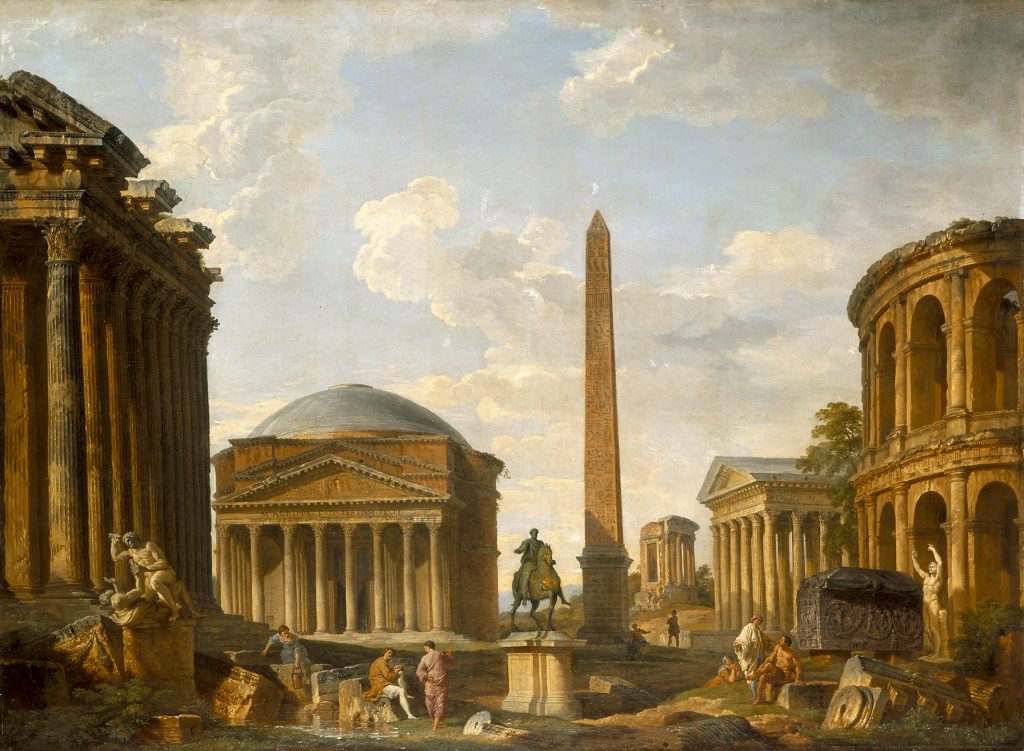
The next stop on the route was Naples. When Italian authorities began excavations in Herculaneum and Pompeii in the 1730s, grand tourists flocked there to delve into the mysteries of the ancient past. Naples became a popular retreat for the British who wanted to enjoy the coastal sun. Travelers such as J. W. Goethe praised the city’s glories:
Naples is a Paradise: everyone lives in a state of intoxicated self-forgetfulness, myself included. I seem to be a completely different person whom I hardly recognize. Yesterday I thought to myself: Either you were mad before, or you are mad now. J. W. Goethe, Google Arts& Culture .
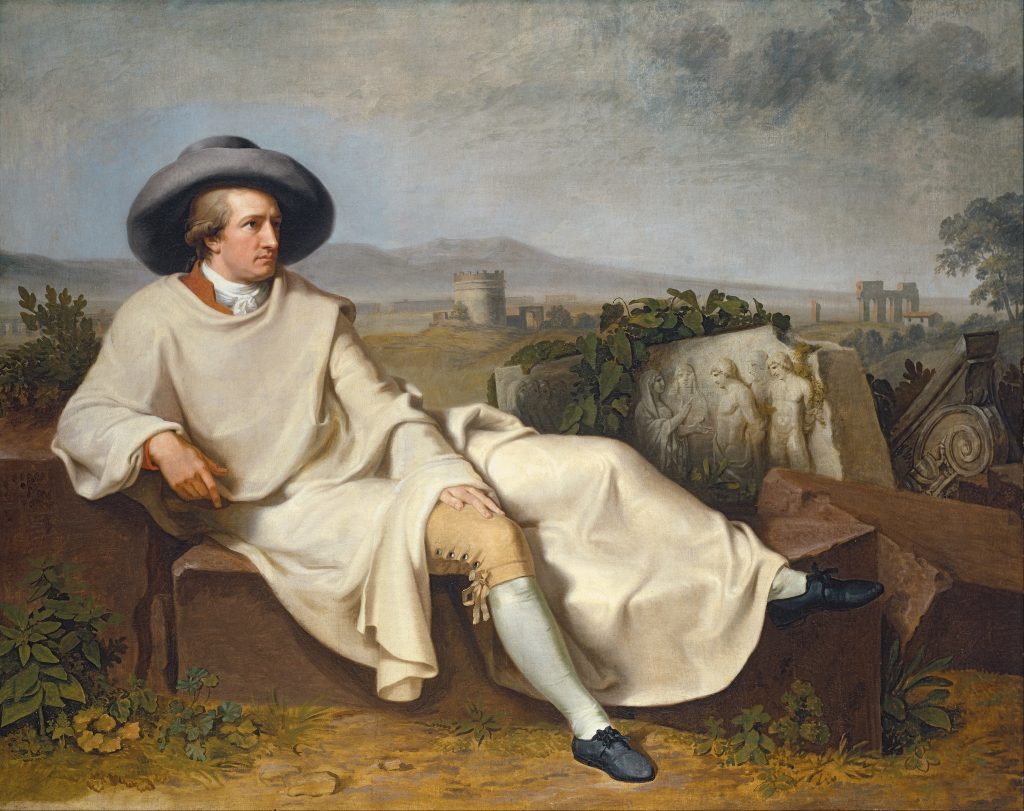
Returning home, young gentlemen crossed the Alps to the German-speaking parts of Europe and visited Innsbruck, Vienna , Dresden, and Berlin . From there, they stopped in Holland and Flanders before returning to England.
With the introduction of steam railways in Europe around 1825, travel became safer, cheaper, and easier to undertake. The Grand Tour custom continued; however, it was not limited to the members of wealthy families. During the 19th century, many educated men had undertaken the Grand Tour. It also became more popular for women to travel across Europe with chaperones. A Room with A View, written by English novelist E. M. Forster, tells the story of a young woman who embarks on a journey to Italy in the 1900s.
Legacy of the Grand Tour
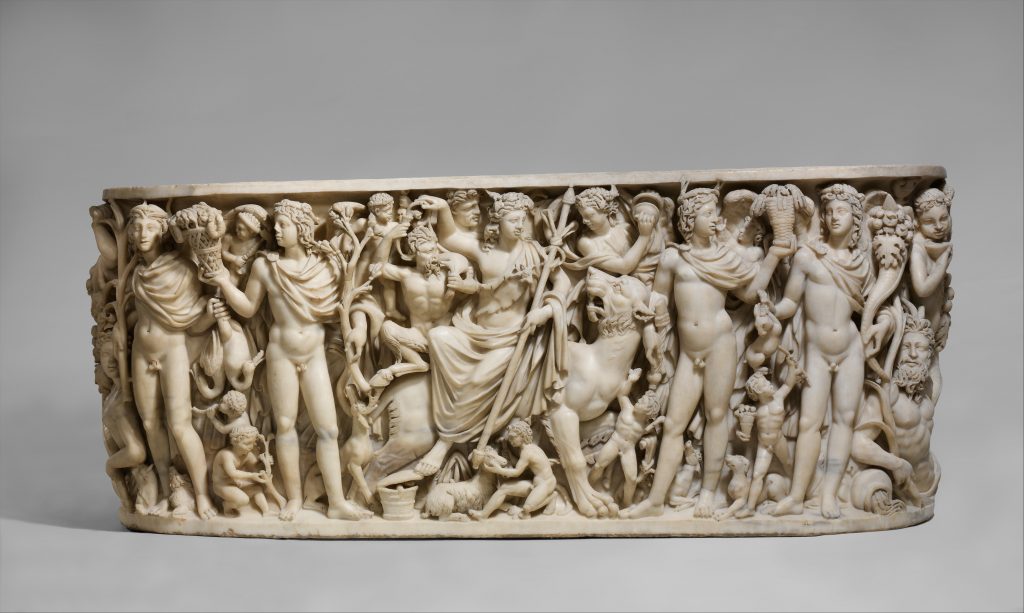
Grand tourists would return with crates full of books, oil paintings, medals, coins, and antique artifacts to be displayed in libraries, cabinets, drawing rooms, and galleries built for that purpose. The marble sarcophagus shown above was brought back from Italy to England by the third duke of Beaufort who found this item during his Grand Tour stop in Pompeii. Impressed by the European art academies on his Grand Tour, Joshua Reynolds founded the Royal Academy of Arts in London upon his return in 1768. The Grand Tour inspired many travelers to take a greater interest in ancient art. The British School in Rome was established to learn more about the Roman ruins and it still exists today.
Get your daily dose of art
Click and follow us on Google News to stay updated all the time
We love art history and writing about it. Your support helps us to sustain DailyArt Magazine and keep it running.
DailyArt Magazine needs your support. Every contribution, however big or small, is very valuable for our future. Thanks to it, we will be able to sustain and grow the Magazine. Thank you for your help!
Gokce Dyson
Based in Canterbury, Gokce holds a bachelor's degree in History and Archaeological Studies and a master's degree in Museum and Gallery Studies. She firmly believes that art enables us to find ourselves and lose ourselves at the same time. If Gokce is not tucked into a cosy corner with a medieval history book, she can be found spending her evenings doing jigsaw puzzles.
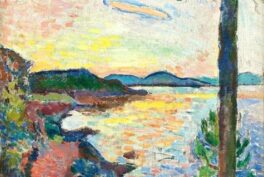
Top 5 Artsy Travel Destinations in 2024 Through Paintings
We suggest you a selection of the best tourist destinations and festivals by the hand of great artists!
Andra Patricia Ritisan 11 March 2024
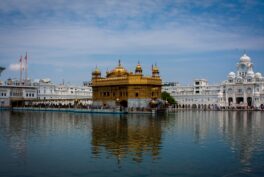
Art Travels: Golden Temple of Amritsar
Nestled in the city of Amritsar in Northwestern India is the iconic Harmandir Sahib or Darbar Sahib, better known as the Golden Temple. This sublime...
Maya M. Tola 8 January 2024
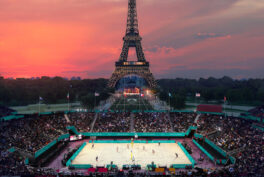
Art and Sports: En Route to the Paris 2024 Olympics
The forthcoming Paris 2024 Summer Olympics will bridge the worlds of art and sport, with equestrian competitions at the Palace of Versailles, fencing...
Ledys Chemin 9 April 2024
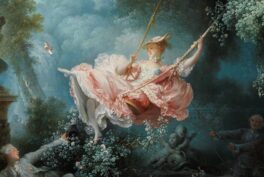
10 Masterpieces You Need To See in London
London is a city full of masterpieces. It is not only one of the biggest art hubs but also one of the most multicultural places in the entire world.
Sandra Juszczyk 23 February 2024
Never miss DailyArt Magazine's stories. Sign up and get your dose of art history delivered straight to your inbox!
- What Was The Grand Tour...
What Was the Grand Tour and Where Did People Go?

Freelance Travel and Music Writer
Nowadays, it’s so easy to pack a bag and hop on a flight or interrail across Europe’s railway at your own leisure. But what if it was known as a right of passage, made no easier by the fact that there was no such modern luxury? Welcome to the Grand Tour – and we’re not talking about Jeremy Clarkson’s TV series …
What was the grand tour all about.
The Grand Tour was a trip of Europe, typically undertaken by young men, which begun in the 17th century and went through to the mid-19th. Women over the age of 21 would occasionally partake, providing they were accompanied by a chaperone from their family. The Grand Tour was seen as an educational trip across Europe, usually starting in Dover, and would see young, wealthy travellers search for arts and culture. Though travelling was not as easy back then, mostly thanks to no rail routes like today, those on The Grand Tour would often have a healthy supply of funds in order to enjoy themselves freely.

What did travellers get up to?
Of course, in the 17th century, there was no such thing as the internet, making discovering things while sat on the other side of the world near impossible. Cultural integration was not yet fully-fledged and nothing like we experience today, so the only way to understand different ways of life was to experience them yourself. Hence why so many people set off for the Grand Tour – the ultimate trip across Europe!
Typical routes taken on the Grand Tour
Travellers (occompanied by a tutor) would often start around the South East region and head in to France, where a coach would often be rented should the party be wealthy enough. Occasionally, the coaches would need to be disassembled in order to cross difficult terrain such as the Alps.
Once passing through Calais and Paris, a typical journey would include a stop-off in Switzerland before crossing the Alps in to Northern Italy. Here’s where the wealth really comes in to play – as luggage and methods of transport would need to be dismantled and carried manually – as really rich travellers would often employ servants to carry everything for them.
Of course, Italy is a highly cultural country and famous for its art and historic buildings, so travellers would spend longer here. Turin, Florence, Rome, Pompeii and Venice would be amongst the cities visited, generally enticing those in to extended stays.
On the return leg, travellers would visit Germany and occasionally Austria, including study time at universities such as Munich, before heading to Holland and Flanders, ahead of crossing the Channel back to Dover.

Since you are here, we would like to share our vision for the future of travel - and the direction Culture Trip is moving in.
Culture Trip launched in 2011 with a simple yet passionate mission: to inspire people to go beyond their boundaries and experience what makes a place, its people and its culture special and meaningful — and this is still in our DNA today. We are proud that, for more than a decade, millions like you have trusted our award-winning recommendations by people who deeply understand what makes certain places and communities so special.
Increasingly we believe the world needs more meaningful, real-life connections between curious travellers keen to explore the world in a more responsible way. That is why we have intensively curated a collection of premium small-group trips as an invitation to meet and connect with new, like-minded people for once-in-a-lifetime experiences in three categories: Culture Trips, Rail Trips and Private Trips. Our Trips are suitable for both solo travelers, couples and friends who want to explore the world together.
Culture Trips are deeply immersive 5 to 16 days itineraries, that combine authentic local experiences, exciting activities and 4-5* accommodation to look forward to at the end of each day. Our Rail Trips are our most planet-friendly itineraries that invite you to take the scenic route, relax whilst getting under the skin of a destination. Our Private Trips are fully tailored itineraries, curated by our Travel Experts specifically for you, your friends or your family.
We know that many of you worry about the environmental impact of travel and are looking for ways of expanding horizons in ways that do minimal harm - and may even bring benefits. We are committed to go as far as possible in curating our trips with care for the planet. That is why all of our trips are flightless in destination, fully carbon offset - and we have ambitious plans to be net zero in the very near future.

Guides & Tips
The best places in europe to visit in 2024.

The Best Places to Travel in May 2024

The Best Private Trips to Book for Your Religious Studies Class

The Best European Trips for Foodies

The Best Private Trips to Book in Europe

The Best Private Trips to Book With Your Support Group

Five Places That Look Even More Beautiful Covered in Snow

The Best Places to Travel in August 2024

The Best Private Trips to Book in Southern Europe

The Best Rail Trips to Take in Europe

Places to Stay
The best private trips to book for your classical studies class.

The Best Trips for Sampling Amazing Mediterranean Food
Culture trip spring sale, save up to $1,100 on our unique small-group trips limited spots..

- Post ID: 1702695
- Sponsored? No
- View Payload

IMAGES
VIDEO
COMMENTS
Englishmen abroad. At its height, from around 1660-1820, the Grand Tour was considered to be the best way to complete a gentleman's education. After leaving school or university, young noblemen from northern Europe left for France to start the tour. After acquiring a coach in Calais, they would ride on to Paris - their first major stop.
A c. 1760 painting of James Grant, John Mytton, Thomas Robinson and Thomas Wynne on the Grand Tour by Nathaniel Dance-Holland. The Grand Tour was the principally 17th- to early 19th-century custom of a traditional trip through Europe, with Italy as a key destination, undertaken by upper-class young European men of sufficient means and rank (typically accompanied by a tutor or family member ...
Beginning in the late sixteenth century, it became fashionable for young aristocrats to visit Paris, Venice, Florence, and above all Rome, as the culmination of their classical education. Thus was born the idea of the Grand Tour, a practice that introduced Englishmen, Germans, Scandinavians, and also Americans to the art and culture of France ...
Required works of art for AP®︎ Art History. by Smarthistory. Below are short videos, essays, high-resolution photographs, and additional resources for each of the 250 required works of art that form the central curriculum for the AP®︎ Art History course. These works of art were selected by the College Board because they "represent ...
This exhibition explores a time from approximately 1880 to 1960 when American artists endeavored to follow in the footsteps of this tradition and trek to Europe for a variety of reasons: study and opportunities to exhibit, illustration on commission, war, and leisure. At the center of their journeys was also the goal of education, for ...
18th Century Grand Tour of Europe. The Travels of European Twenty-Somethings. Venice was not to be missed on the Grand Tour. Grand Canal circa 1740 painting by Canaletto. The French Revolution marked the end of a spectacular period of travel and enlightenment for European youth, particularly from England. Young English elites of the seventeenth ...
Art, antiquity and architecture: the Grand Tour provided an opportunity to discover the cultural wonders of Europe and beyond. Popular throughout the 18th century, this extended journey was seen as a rite of passage for mainly young, aristocratic English men. As well as marvelling at artistic masterpieces, Grand Tourists brought back souvenirs ...
The Grand Tour. Meryl Cates. October 2, 2013. Opening Fanfare, The Grand Tour. Photograph by Stephanie Berger. «In celebration of the New European Paintings Galleries, 1250-1800, the Museum hosted two special evenings of concerts on September 17 and 18. Music and art came together to illuminate the time period represented by the galleries ...
The AP Art History framework is organized into 10 commonly taught units of study that provide one possible sequence for the course. As always, you have the flexibility to organize the course content as you like. Unit. Exam Weighting (Multiple-Choice Section) Unit 1: Global Prehistory, 30,000-500 BCE. ~4%.
In the 18th century, a 'Grand Tour' became a rite of passage for wealthy young men. Essentially an elaborate form of finishing school, the tradition saw aristocrats travel across Europe to take in Greek and Roman history, language and literature, art, architecture and antiquity, while a paid 'cicerone' acted as both a chaperone and teacher.
You'll explore the evolution of art from the early middle ages through the mid-18th century in Europe and the Americas. Topics may include: Influences on Jewish, Christian, and Islamic Art. The Age of Exploration and colonialism. Naturalism and developments in visual form. Patronage and continued religious influence.
Grand Tour. Following the emotional wave provoked by the first sensational discoveries at Pompeii and Herculaneum in the mid-eighteenth century, a growing number of travellers from Europe came to Italy to admire the vestiges of the past. Thanks to the sensitivity of the Bourbon kings, the cities buried by the eruption of Vesuvius in 79 AD were ...
Unit 5: Early Europe and Colonial Americas: 200-1750 C.E. Medieval art in Europe Art of the Islamic world in the medieval era Renaissance Art in Europe. Protestant Reformation and Catholic Counter-Reformation Colonial Americas.
Section I: Multiple Choice. 80 Questions | 1 Hour | 50% of Exam Score. Questions on the exam will appear both as: sets of 2-3 questions, with each set based on color images of works of art. individual questions, some of which are based on color images of works of art. The multiple-choice section includes images of works of art both in and ...
The Grand Tour evolved between the 17th and 18th centuries as a custom of a traditional trip. The purpose of the Grand Tour was to provide male members of upper-class families with a formative experience. The term was first used by the Catholic priest and travel writer Richard Lassels in his guidebook The Voyage of Italy.
Download free-response questions from past exams along with scoring guidelines, sample responses from exam takers, and scoring distributions. If you are using assistive technology and need help accessing these PDFs in another format, contact Services for Students with Disabilities at 212-713-8333 or by email at [email protected]. The ...
AP Art History Ch 26. Arabesque. Click the card to flip 👆. Ornamental design with twisting, flowing lines, originally in Islamic decoration. Ex: Salon de la Princesse. Click the card to flip 👆. 1 / 15.
The Grand Tour was a trip of Europe, typically undertaken by young men, which begun in the 17th century and went through to the mid-19th. Women over the age of 21 would occasionally partake, providing they were accompanied by a chaperone from their family. The Grand Tour was seen as an educational trip across Europe, usually starting in Dover ...
grand tour, multiyear journey, typically running through France and Italy.It was undertaken by aristocratic or wealthy young men from northern Europe, especially England, to complete their education.The term was coined in 1670 by priest and writer Richard Lassels in his Voyage of Italy, but the practice probably began some 100 years earlier.It reached its height during the 18th century and ...
Jefferson's original building is the middle structure of the present day capitol complex. At the center of the capitol is the rotunda, a two-story space capped by a dome and illuminated by skylights. The dome was added to the building in 1794 C.E. Between 1904 and 1906 C.E., architect John K. Peebles completed Jefferson's original ...
Cultural Trip Around Europe. In fine art, the term "Grand Tour" refers to the fashionable European trip undertaken by cultural and socially conscious tourists, to the great centres of classical, Renaissance and Baroque architecture, sculpture and painting: notably, Paris, Florence, Venice, Rome, Vienna, Dresden, Berlin, Amsterdam and Antwerp.
Introduction to cultures and religions for the study of AP Art History. Unit 3. Global prehistory: 30,000-500 B.C.E. Unit 4. Ancient Mediterranean: 3500 B.C.E.-300 C.E. Unit 5. Early Europe and Colonial Americas: 200-1750 C.E. ... an introduction for the study of art history (Opens a modal) Architecture and liturgy (Opens a modal) The life of ...
AP®︎/College Art History. Course: ... and through a monumental gate of inlaid and highly decorated red sandstone made for a first impression of grand splendor and symmetry: aligned along a long water channel through this gate is the Taj—set majestically on a raised platform on the north end. The rectangular complex runs roughly 1860 feet ...